Characterization of various species of agaric mushrooms
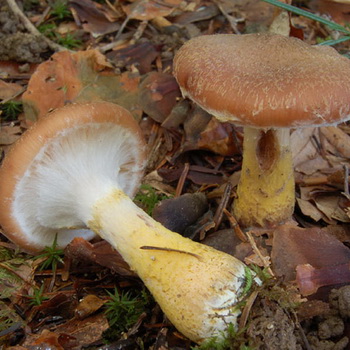
Agaric mushrooms with white and gray plates
May rowing (Calocybe gambosa).

Family: Lyophyllaceae (Lyophyllaceae)
Season: mid May - mid June
Growth: singly and in groups
Description:
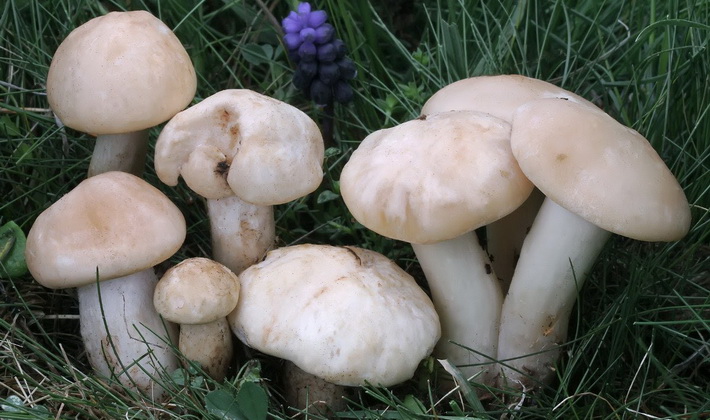
The hat is hump-like, then half-spread, cream, then white.
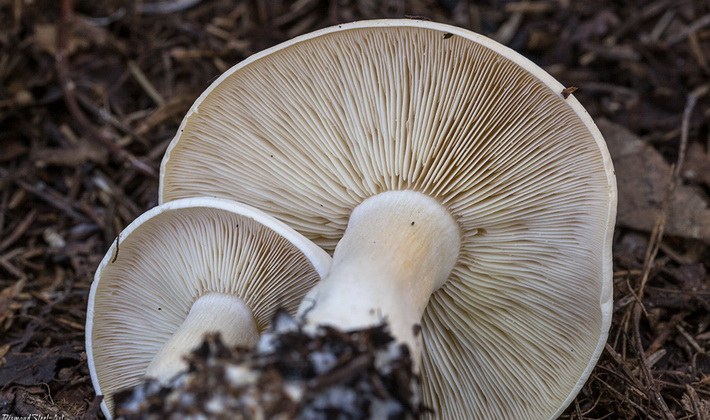
The pulp is white, dense, with the taste and smell of fresh flour.
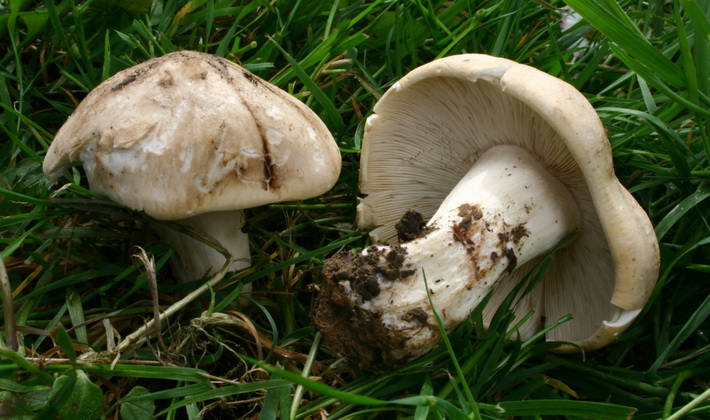
The peduncle is cylindrical, whitish, slightly yellowing, frequent, overgrown, whitish. The lamellae are narrow, frequent, overgrown, whitish.
It is used fresh (boiling for 10-15 minutes) in soups and main dishes, it can be dried and pickled.
Ecology and distribution:
These edible leaf mushrooms are found in bright deciduous forests, meadows, and gardens.
Ordinary lilac-legged (Lepista personata).

Family: Ordinary (Tricholomataceae)
Season: mid September - late October
Growth: rarely alone, often in groups, forming rings
Description:
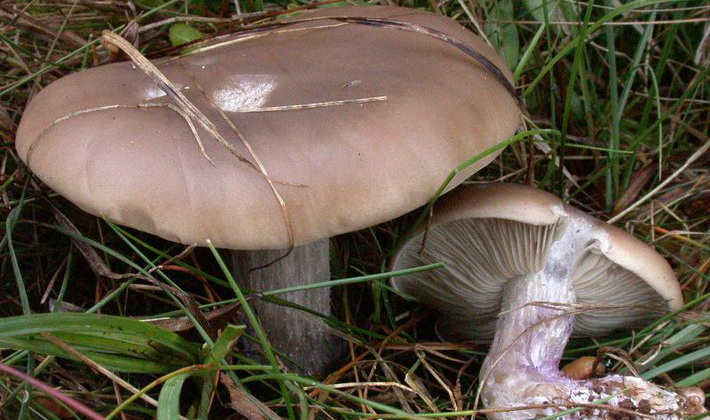
In youth, the hat has a wrapped, even edge.
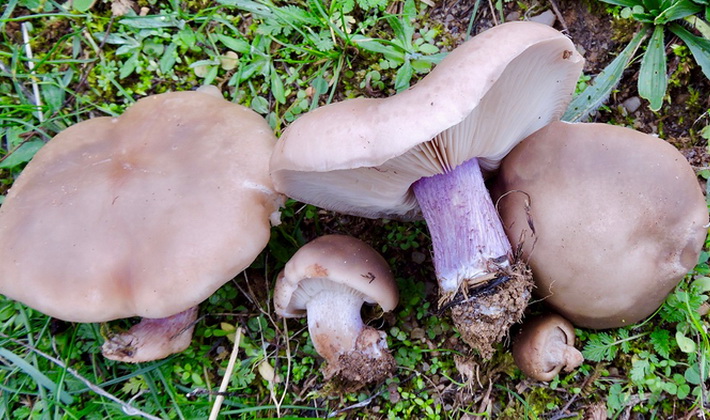
The leg of young mushrooms is violet, flake-like. A hat thawed in diameter, light gray to brownish, even and smooth.
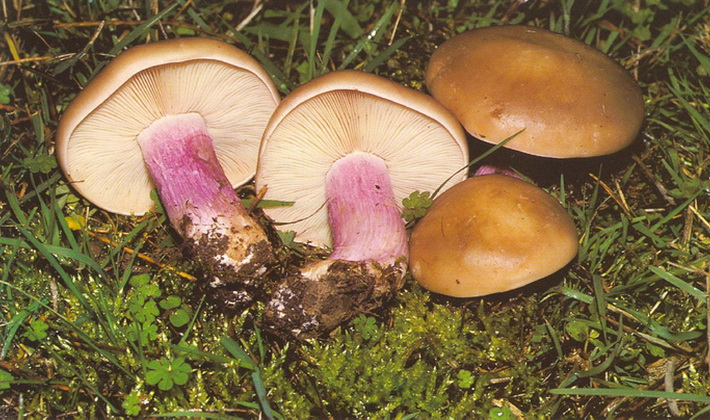
The plates are white or gray, uneven. The flesh is whitish or grayish, with a pleasant smell.
A good edible mushroom, does not require preliminary boiling, has an excellent taste in marinated and salted form, suitable for drying.
Ecology and distribution:
These mushrooms with white plates grow in meadows, in gardens, pastures, very fond of soil fertilized by cattle.
Ordinary brown-yellow (Tricholoma fulvum).
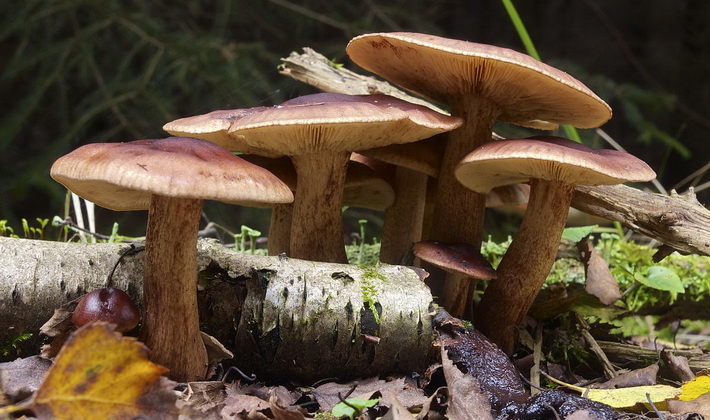
Family: Ordinary (Tricholomataceae)
Season: Aug. Sept
Growth: singly or, more often, in groups
Description:
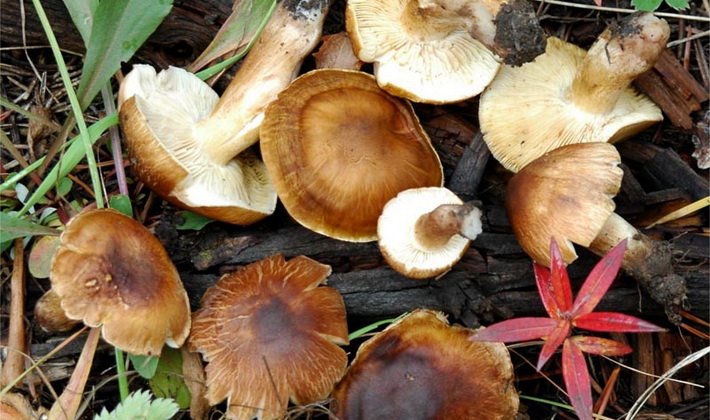
Pulp with cucumber-flour groin. The hat is round-banded, then erased, with a tubercle, reddish-brown, reddish.
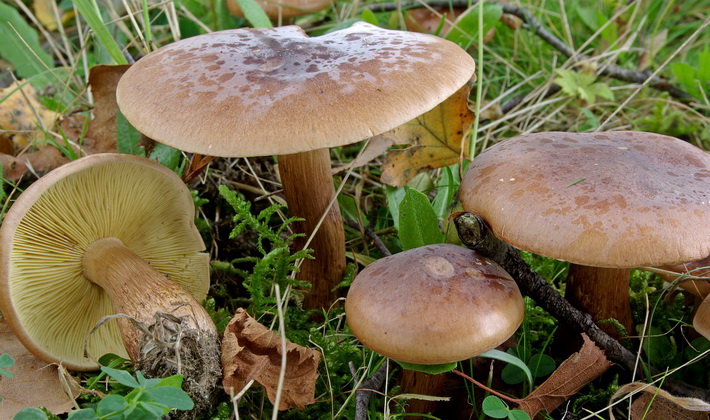
Leg fusiform or whelped below, hollow, reddish.
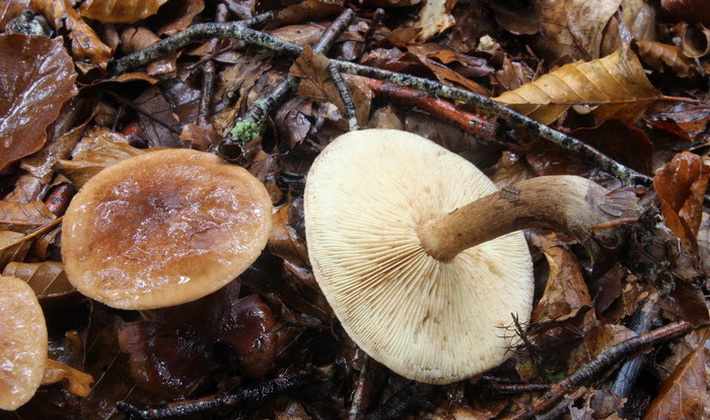
The plates are notched or adorned with a tooth, white, frequent, covered with age, brown spots with age.
The mushroom is inedible due to its bitter taste.
Ecology and distribution:
It is found in deciduous and mixed forests. It tolerates drought.
Separate rowan tree (Tricholoma sejunctum).
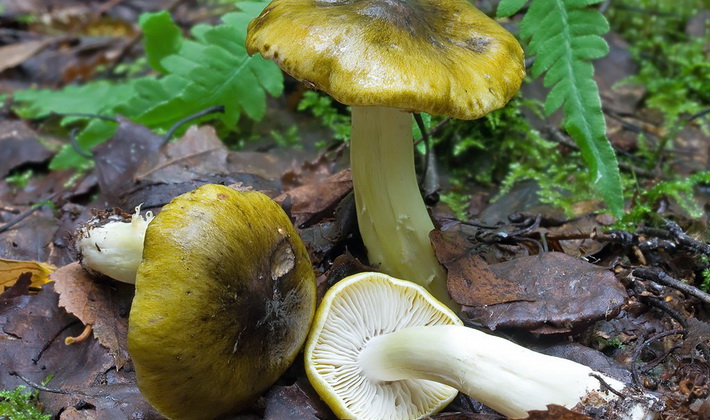
Family: Ordinary (Tricholomataceae)
Season: end of July - end of September
Growth: usually in small groups
Description:

The plates are grayish, silky, wide, rare, fork-branched, with lamellae.
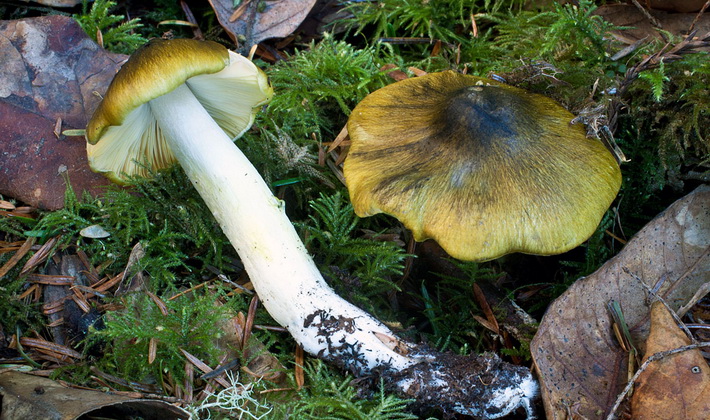
Leg is small-scaled, greenish-white at the top, dirty gray at the bottom, swollen at the base. The edges of the cap are slightly bent down.
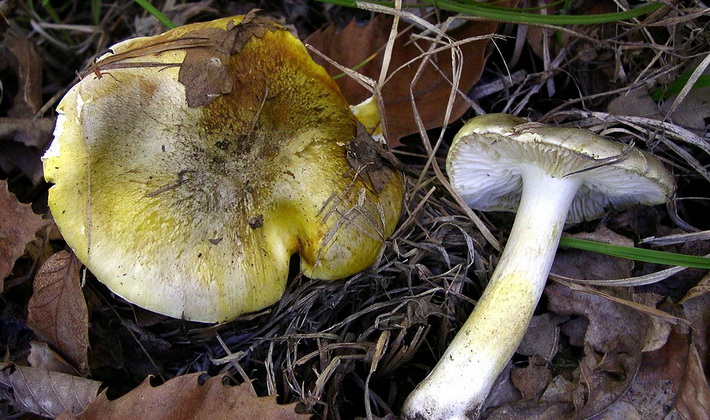
The cap is convex, with a conical tubercle, darkish-olive, mucous in wet weather. The flesh is white, yellowish under the skin of the cap and legs, with a smell of fresh flour, bitter.
Conditionally edible mushroom. After boiling, it is suitable for salting.
Ecology and distribution:
It forms mycorrhiza with deciduous and coniferous trees. It occurs mainly in deciduous and mixed forests, less commonly in conifers. Prefers moist places and fertile soils.
Earthy Earthen (Tricholoma terreum).

Family: Ordinary (Tricholomataceae)
Season: mid August - October
Growth: in groups
Description:
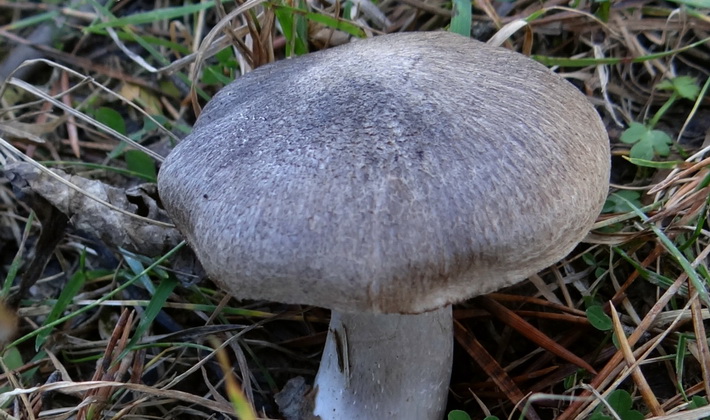
The hat is gray, first wide-bell-shaped, then spread out, washed with fibrous scales. The edge of the hat is wavy, cracking. The plates are grown, wide, frequent, white or grayish.

The flesh is thin, white or grayish.
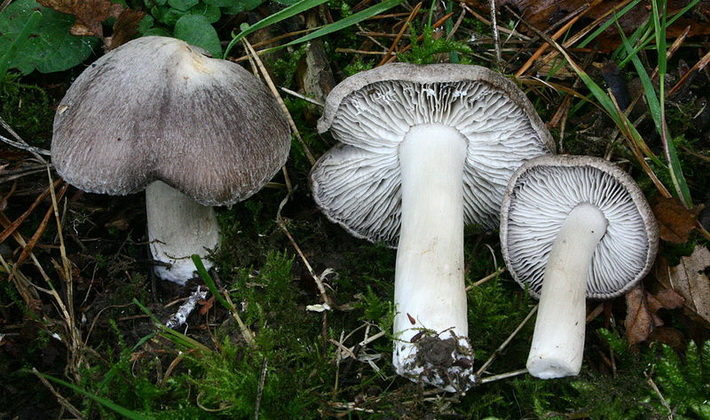
The leg is cylindrical, hollow, grayish.
These lamellar mushrooms with white plates are used fresh (boiling for about 15 minutes), can be salted and pickled.
Ecology and distribution:
It occurs in coniferous and deciduous forests (often with pine trees), in plantings, in shrubs, in rare grass and on the litter.
Udemansiella mucosa (Oudemansiella mucida).
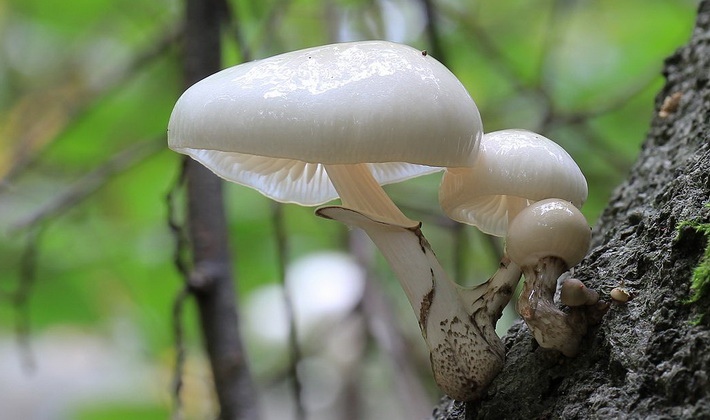
Family: Physalacriaceae (Physalacriaceae)
Season: mid-May - end of September
Growth: more often in bunches, less often alone
Description:
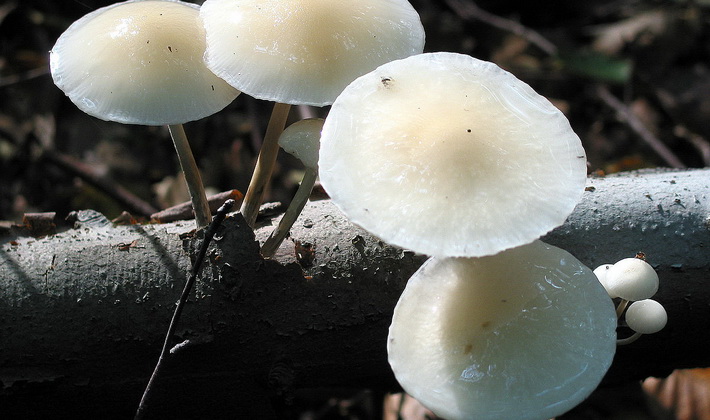
The hat is white, light gray or creamy brown, convex, with a mucous surface.
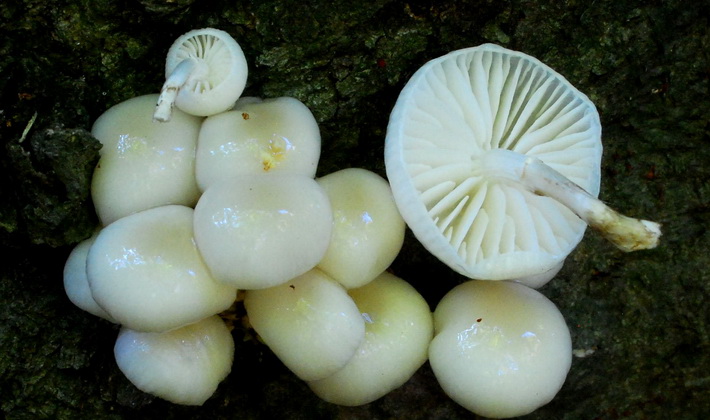
The pulp is dense, yellowish-whitish.

The lamellae are broadly grown, dense, white in color, with well-defined gaps. The foot is dry and smooth.
The mushroom is edible, but almost tasteless.
Ecology and distribution:
It grows on thick branches of living trees, on dead trunks of hardwood, more often on beech, maple, from the base to the crown. Distributed all over the world. In Russia, it is common in the south of Primorye, in the European part it is rare.
Cystoderma amiant (Cystoderma amianthinum).
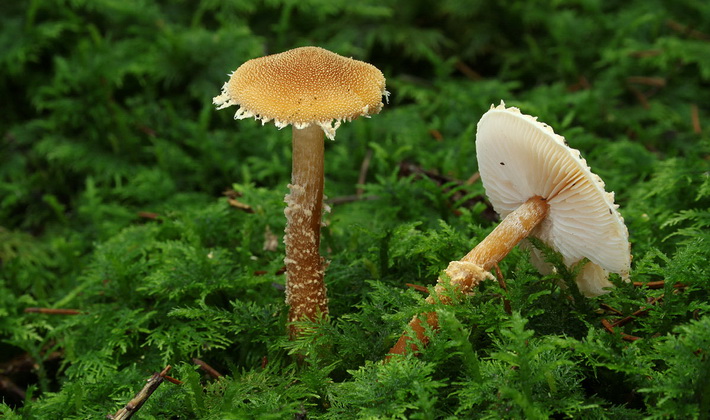
Family: Champignon (Agaricaceae)
Season: Aug. Sept
Growth: singly and in small groups
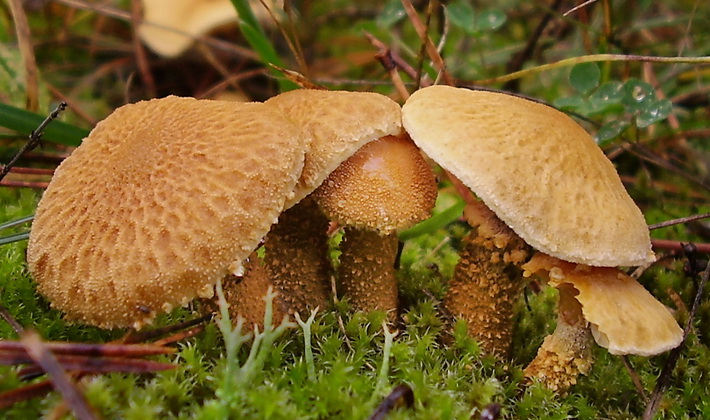
The hat is flat-convex or flat, with a blunt tubercle; color from reddish brown to ocher yellow. The cap of young mushrooms is conical or hemispherical. The flaky remains covered the edge of the hat. The edge of the hat is fringed. The ring is often absent.
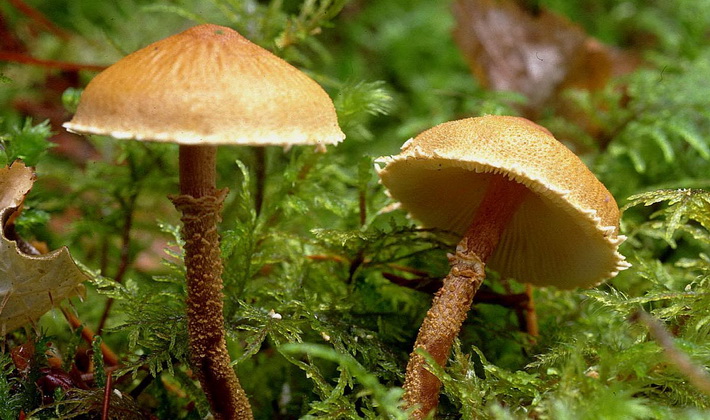
The leg is continuous, later - hollow, fibrous, of the same color with a hat.
The plates are unequal, narrow, frequent, adhered to the peduncle; in young mushrooms they are white, later yellowish.
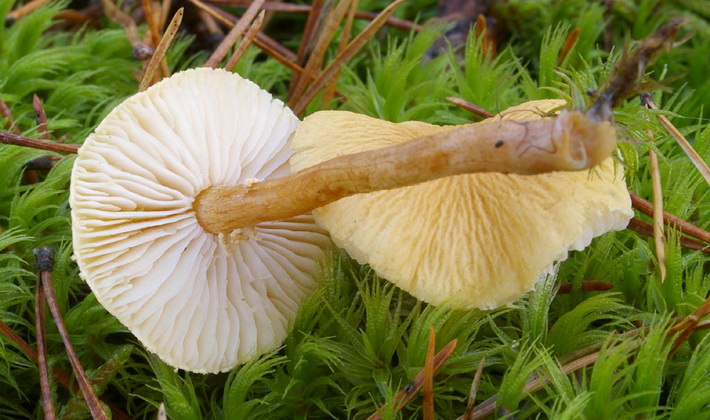
The pulp is yellowish, with a moldy smell.
The mushroom is considered conditionally edible, but its taste is low.
Ecology and distribution:
It grows in conifers, less often - in mixed forests, glades, sometimes in meadows, wastelands, in parks; in moss, among ferns, in lingonberries, often digging deeply into the forest litter.
Agaric with brown or ginger hat
Entoloma sagging (Entoloma rhodopolium).
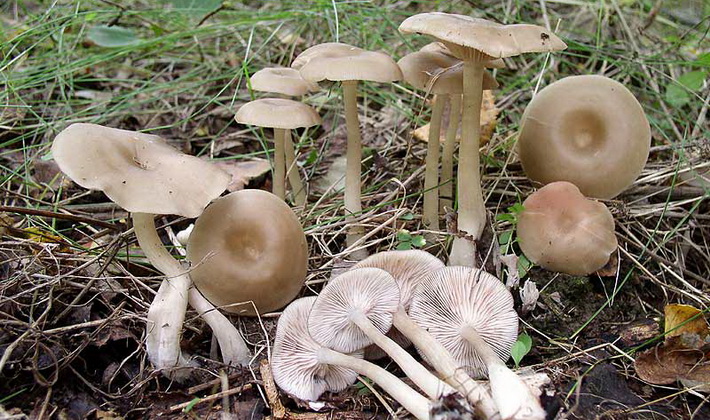
Family: Entolomataceae
Season: Aug. Sept
Growth: in grass and on leaf litter in groups, rows, rings
Description:
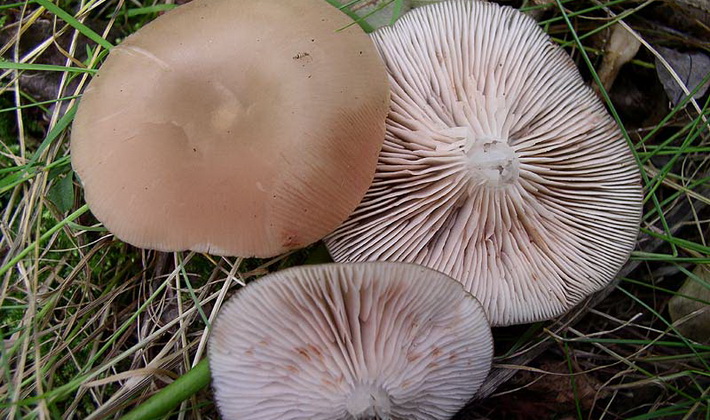
The cap of young mushrooms is bell-shaped, then opens to almost flat, dry, smooth, brown tones.
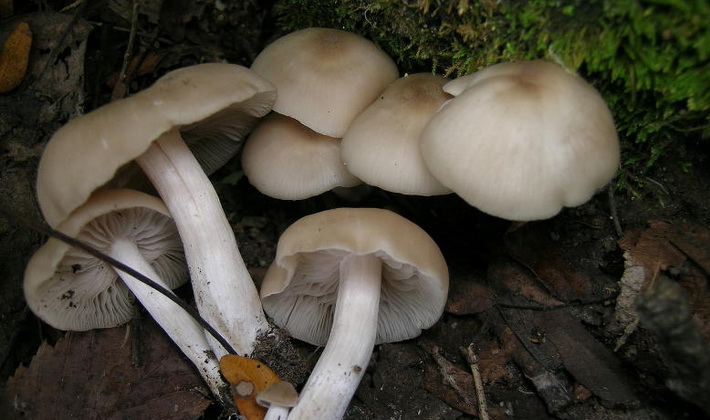
The pulp is brittle, melted whitish, slightly translucent, with a fresh odor.
The plates are rare, adhered to the pedicle, then with a tooth descending on it, with age become bright pink.
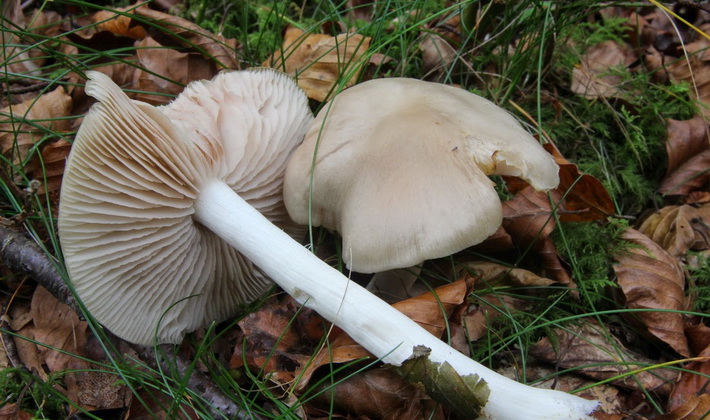
The leg is white, smooth, with a cotton, then with a hollow middle.
The fungus causes severe gastric poisoning: after 1-3 hours, headache, dizziness, then severe vomiting, diarrhea, lasting up to three days.
Ecology and distribution:
This brown-headed agaric is found in deciduous and mixed forests, forming mycorrhiza with elm and birch.
Cobweb bracelet (Cortinarius armillatus).

Family: Cobweb (Cortinariaceae)
Season: end of July - mid-October
Growth: in groups and singly
Description:
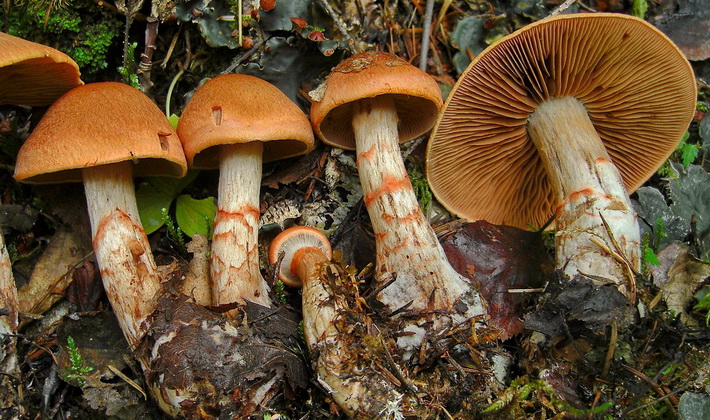
On the leg are several red uneven belts.
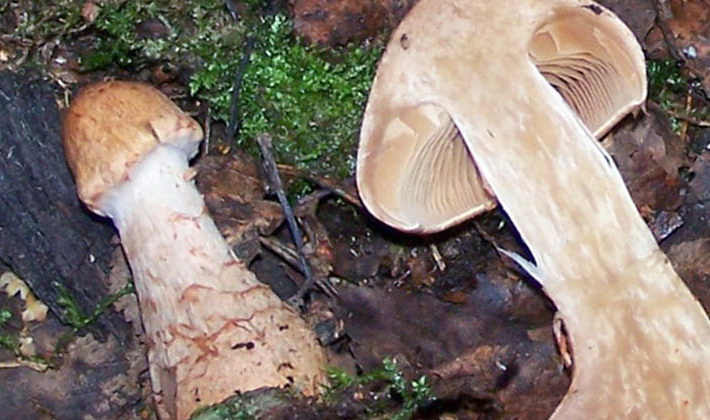
Flesh with a yellowish tint and an unpleasant odor.
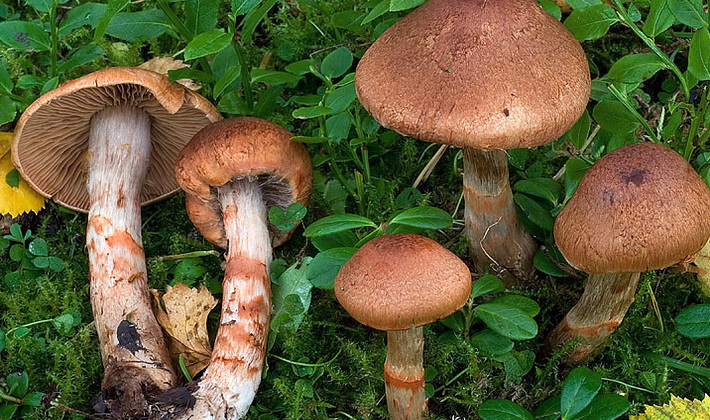
The hat is first bell-shaped, then spread out, with a tubercle in the center, red-brown. Lamellas are grown, wide, light brown. The spider veil is brownish-pink.
Used fresh (boiling for 15 minutes) in main dishes and pickled.It is better to collect young mushrooms with an unopened hat.
Ecology and distribution:
This agaric with a red-brown hat is found in coniferous (with pine) and mixed forests (with birch), in moist places, on the edge of swamps, in moss.
Mucous cobweb (Cortinarius mucosus).
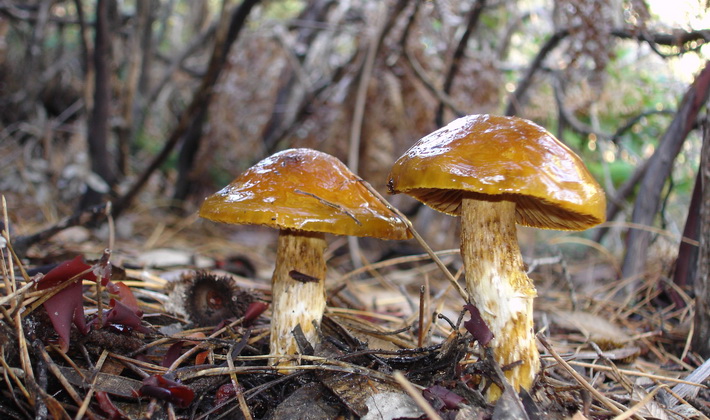
Family: Cobweb (Cortinariaceae)
Season: mid-August - end of September
Growth: in groups and singly
Description:
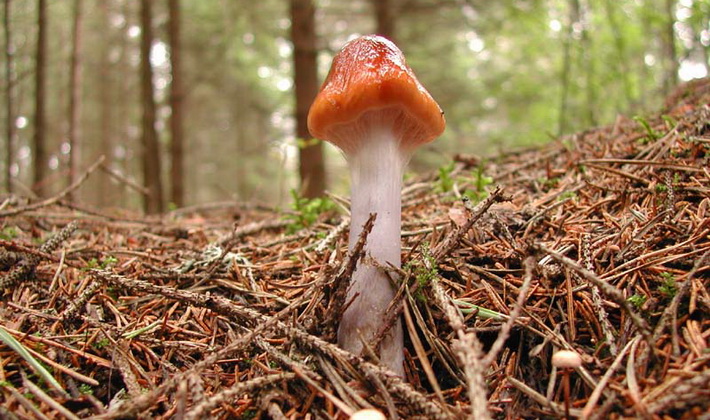
The hat is first blunt-bellied, then convex, reddish-brown, covered with a thick layer of mucus.
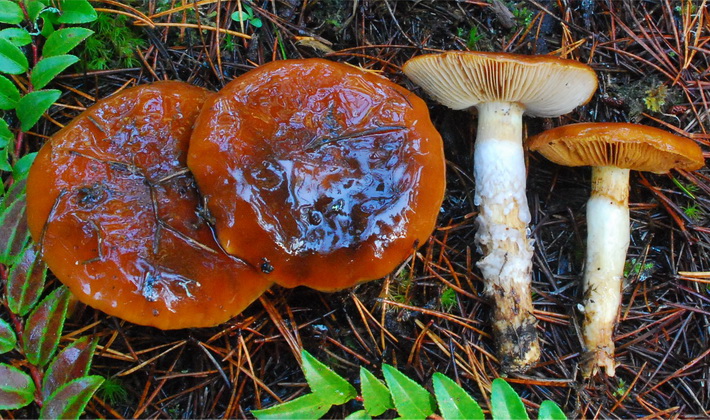
Leg mucous, silky, white, with weak fibrous residues of the bedspread.
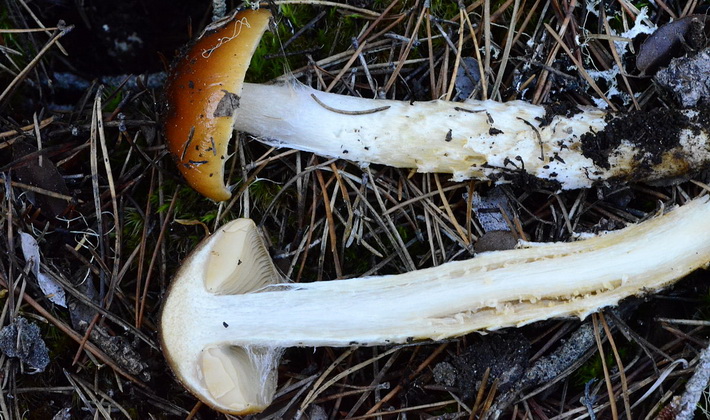
The flesh is first dense, then soft, whitish. The lamellas are overgrown with a tooth, brownish, with a jagged edge.
It is used fresh in the second courses (after boiling), salted and pickled. It is better to collect young mushrooms with open hats.
Ecology and distribution:
It occurs in dry pine and mixed forests, on sandy soils, in moss. May accumulate heavy metals.
Plush cobweb (Cortinarius orellanus).
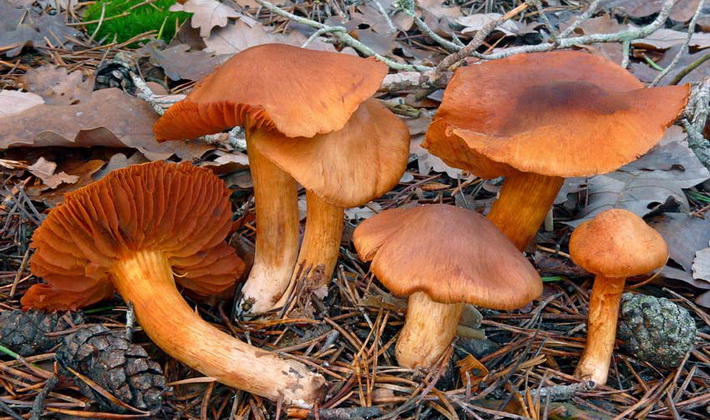
Family: Cobweb (Cortinariaceae)
Season: July - October
Growth: singly or in small groups
Description:
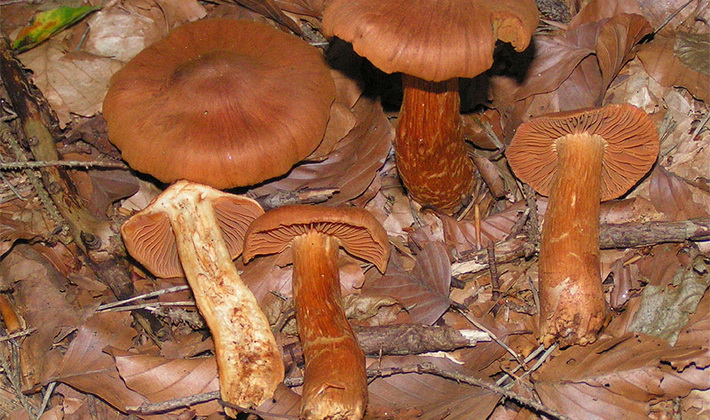
The flesh is yellowish or brownish, with the smell of radish.

Leg slightly narrowed to the base, light yellow, with longitudinal fibrous scales, without stripes. Lamellae overgrown, wide, thick, rare, hat-colored.
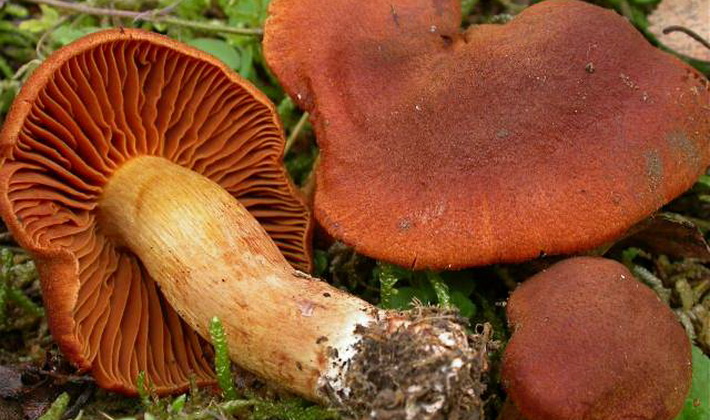
The hat is convex, then flat, with a tubercle in the center, felt or small-scaled, orange or red.
Deadly poisonous mushroom, contains tollin toxin, which affects the liver and kidneys. Symptoms of poisoning appear after 3-14 days.
Ecology and distribution:
It occurs in deciduous forests, most often on sandy soils under oaks and birches.
Beautiful cobweb (Cortinarius rubellus).
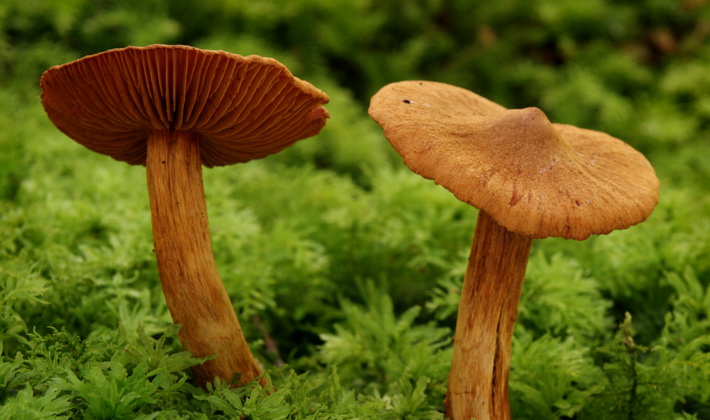
Family: Cobweb (Cortinariaceae)
Season: Aug. Sept
Growth: singly or in small groups
Description:
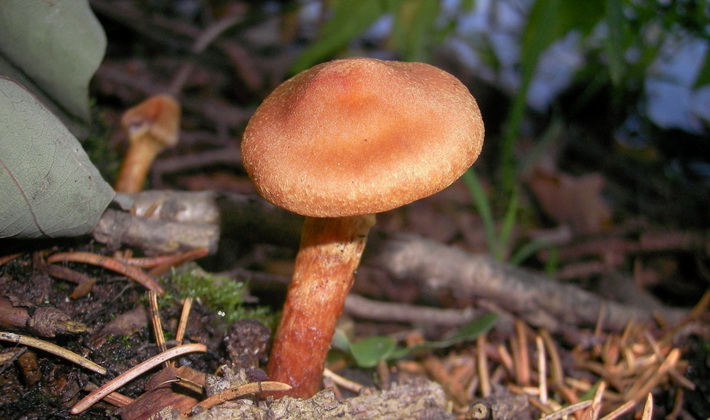
The hat is conical, then prostrate-conical, with a sharp tubercle, fibrous, finely scaly, red.
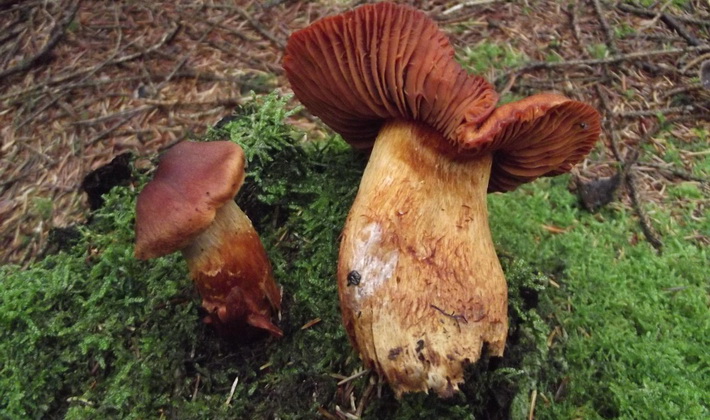
The pulp is buffy, with a raw rare odor.

Leg slightly thickened at the base, fibrous, hat-colored with lighter yellowish uneven belts. Lamellae overgrown or with a small notch, wide, sparse, thick, orange-buffy.
Deadly poisonous mushroom, contains tollinin toxin.
Ecology and distribution:
Forms mycorrhiza with spruce. It occurs in spruce and spruce-pine forests on slightly podzolic soils. Rare view. In Russia, it was found only on the Karelian Isthmus (Leningrad Region).
See how this agaric mushroom looks in the photo:
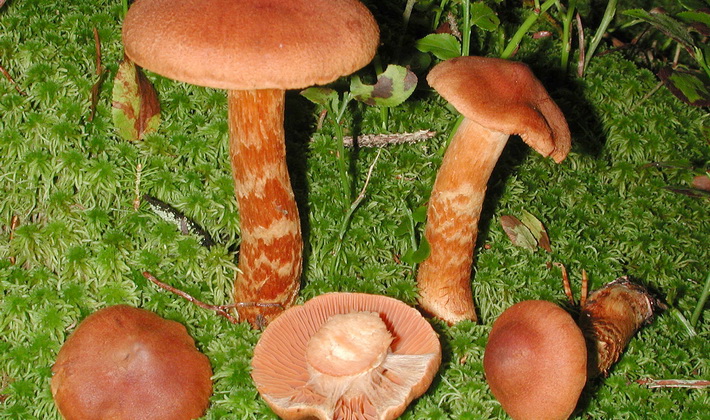
Red Plate Web (Cortinarius semisanguineus).
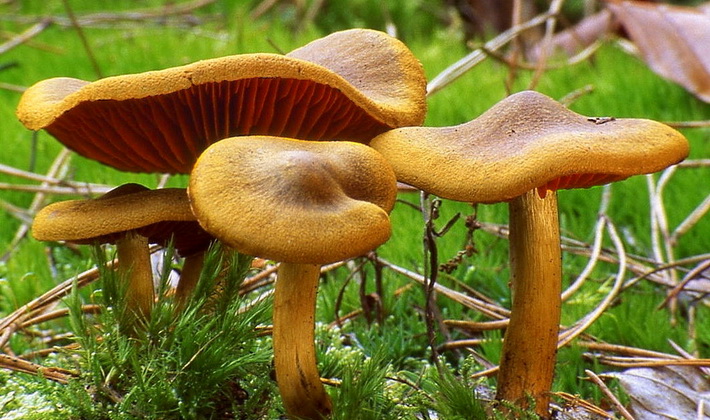
Family: Cobweb (Cortinariaceae)
Season: beginning of August - end of September
Growth: singly and in groups
Description:
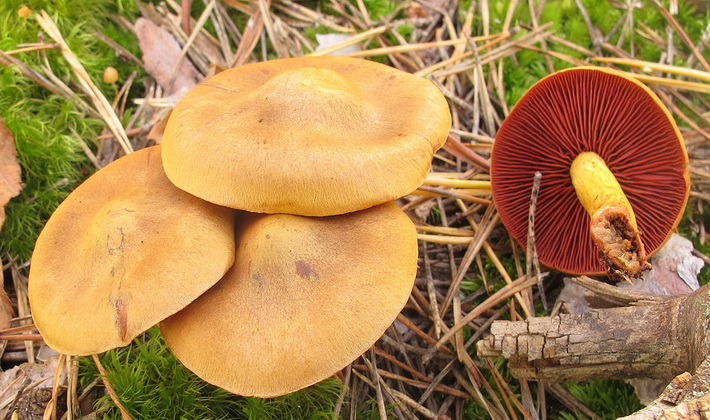
The hat is convex, with a tubercle in the center, brownish or olive-brown.
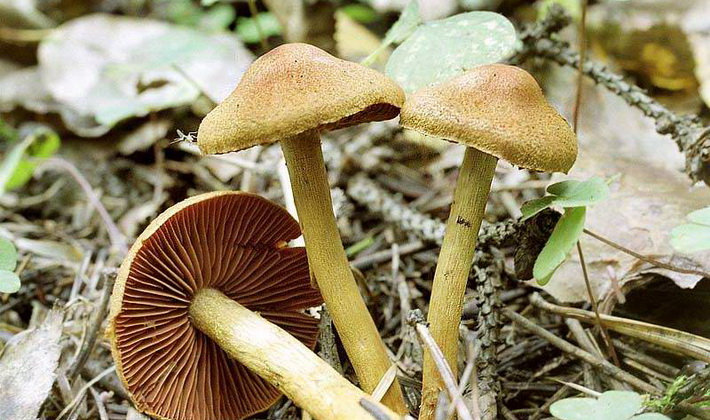
The flesh is light brown.

The leg is the color of a hat or lighter, in the upper part with a purple tint, covered with filamentary remains of the bedspread. Lamellae are grown, rare, blood-red or red-brown.
The mushroom is inedible, according to some reports - poisonous.
Ecology and distribution:
Widely distributed, grows in coniferous (pine) and mixed forests. It forms mycorrhiza with pine, possibly also with spruce.
The following are examples of other agaric mushrooms with descriptions and photographs.
Examples of other agaric mushrooms
Ordinary scaly (Tricholoma scalpturatum).
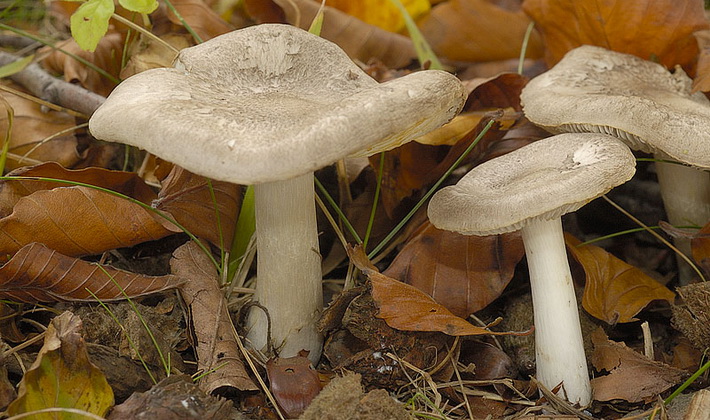
Family: Ordinary (Tricholomataceae)
Season: June - end of October
Growth: often forms “witch circles”, sometimes groups of mushrooms grow in bunches
Description:
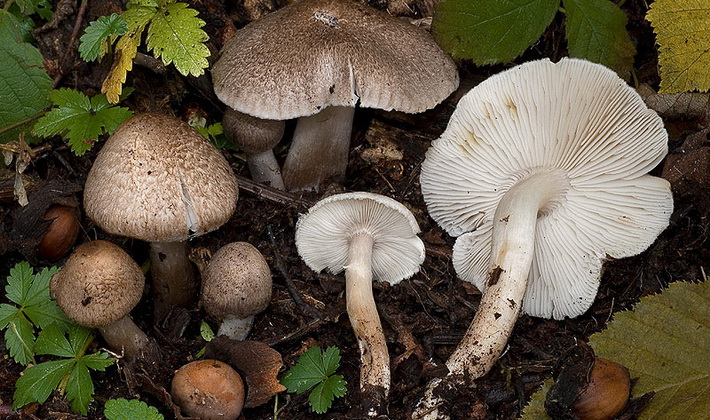
The cap is first convex, then prostrate, sometimes concave, with a tubercle. The skin is fine-fibered or with small pressed scales, grayish.

The pulp is very fragile, white, the smell and taste are mealy.
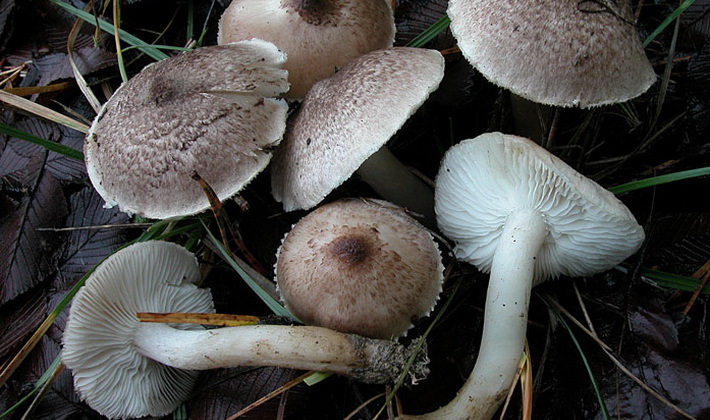
The leg is fibrous, grayish, sometimes with remains covered in the form of scraps of skin. The lamellae are frequent, with a tooth, and yellowing.
Mushroom of mediocre taste.It is used after preliminary boiling fresh, salty, pickled.
Ecology and distribution:
Lamellar mushroom called scaly foliage grows in forests of various types, gardens, parks, forest shelterbelts, in grass, along roadsides.
Ordinary yellow-red (Tricholomopsis rutilans).
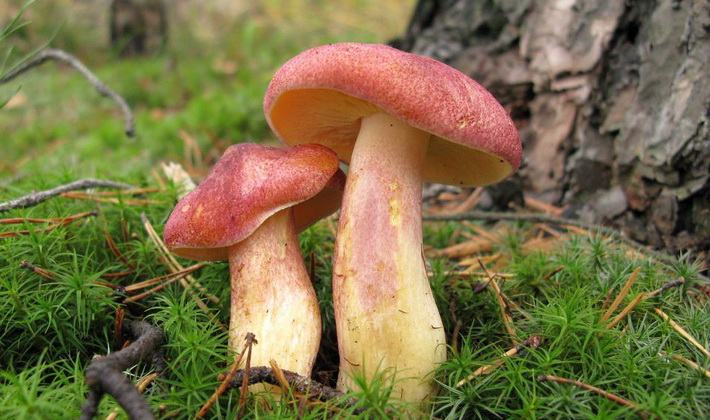
Family: Ordinary (Tricholomataceae)
Season: mid July - late October
Growth: in groups
Description:
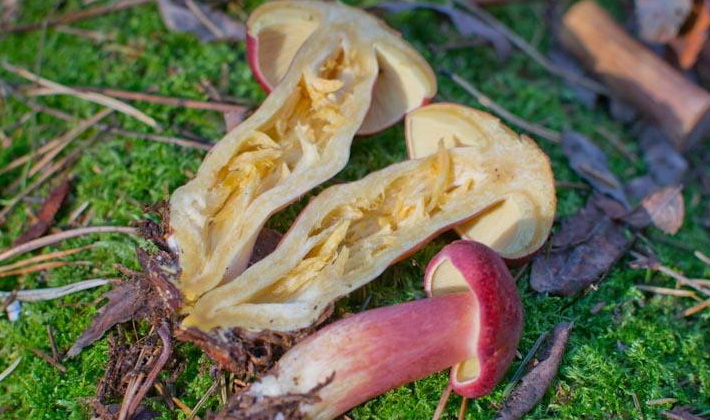
The pulp is bright yellow, with a sour smell.
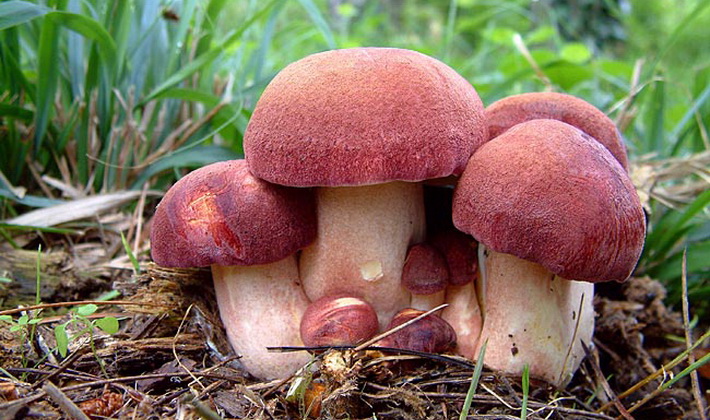
The cap is convex, the skin is orange-yellow, dry, velvety, covered with small purple scales. The lamellae are narrowly grown, yellowish or bright yellow, sinuous.
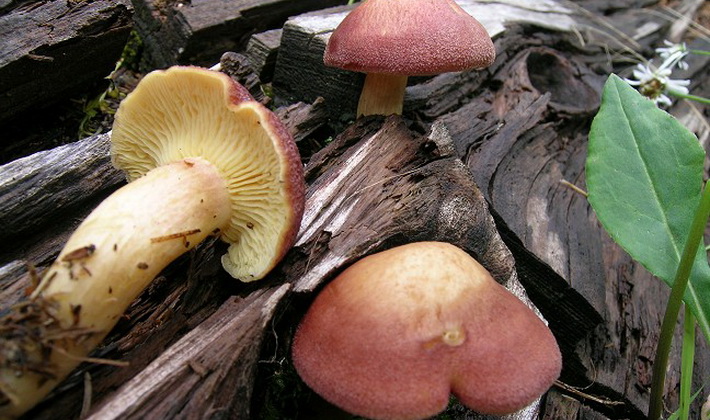
The leg is solid, then hollow, often bent, with a thickening at the base, the same color as the hat.
Conditionally edible mushroom of low quality. Only young mushrooms are suitable for food. After boiling, they are consumed in a fresh, salted and pickled form.
Ecology and distribution:
It occurs in coniferous, mainly pine, forests, grows on dead wood.
Entoloma poisonous (Entoloma sinuatum).
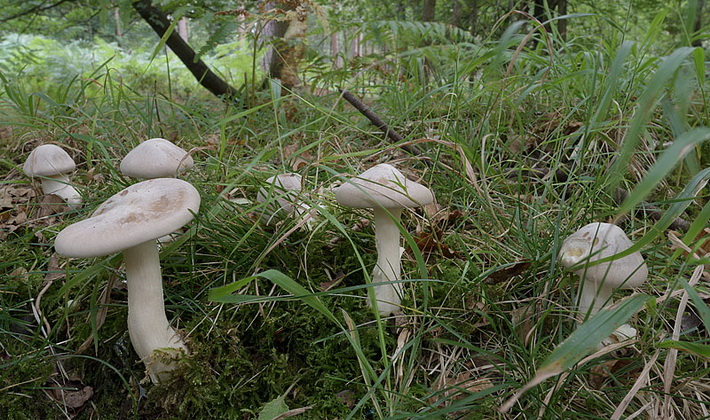
Family: Entolomataceae
Season: end of May - beginning of October
Growth: on clay soils singly and in small groups
Description:
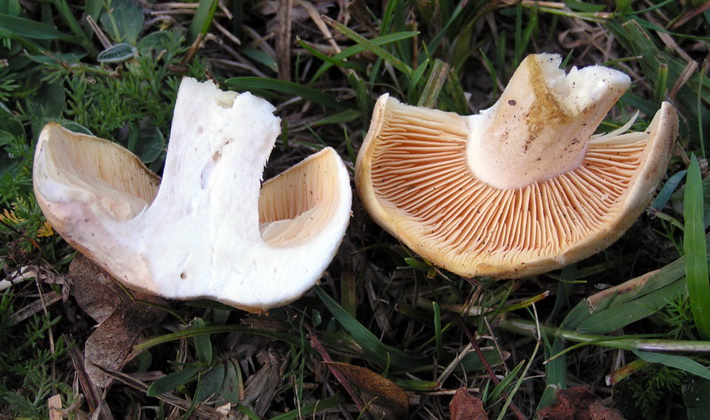
The pulp is white, brownish under the skin of the hat, in mature mushrooms with an unpleasant odor.

The leg of young mushrooms is solid, in maturity - with spongy filling.
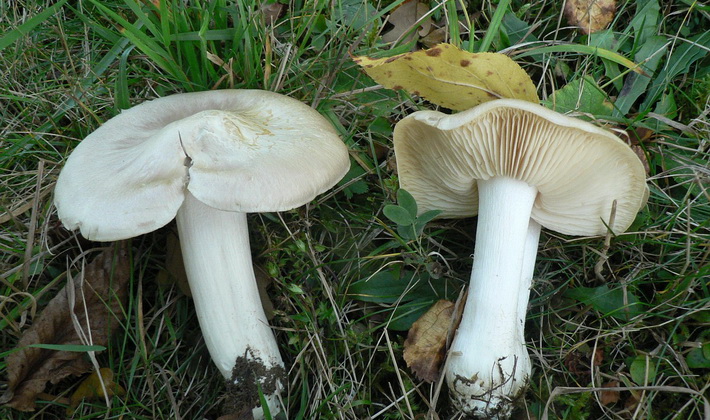
The cap is at first convex, white, then spread out, with a large tubercle, yellowish. The surface of the peduncle is white, silky, later ocher-yellowish, with pressure brownish. Lamellae in young mushrooms are whitish. Lamellae are slightly grown, rare, wide, in mature mushrooms - with a pinkish-meaty hue.
The fungus causes severe gastric poisoning, similar to an entomol squeezed.
Ecology and distribution:
On the territory of Russia it is found in the south of the European part, in the North Caucasus and in the south of Siberia. It grows in light deciduous and mixed forests (especially in oak forests) and parks, forming mycorrhiza with oak, beech, and hornbeam.
Cobweb lazy (Cortinarius bolaris).
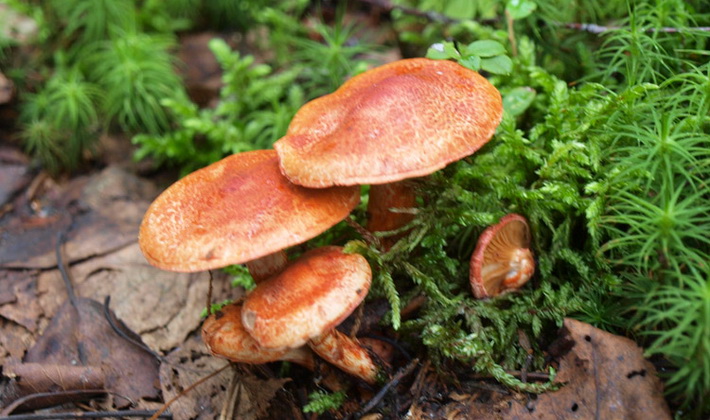
Family: Cobweb (Cortinariaceae)
Season: September October
Growth: groups of fungi of different ages
Description:
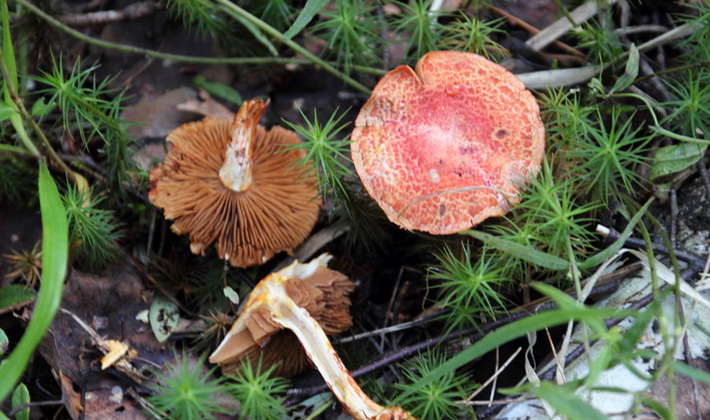
The pulp is white, yellowish or light orange.

The hat is convex, then almost flat, densely covered with small reddish scales.
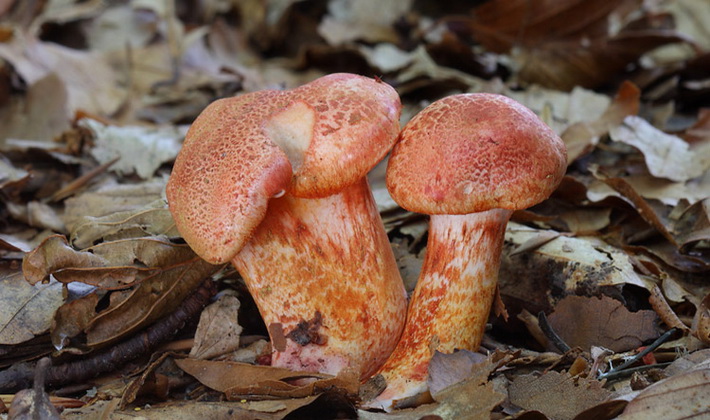
The leg is red-brown, covered with reddish-red scales, sometimes with a thickening at the base. In the upper part of the leg are reddish belts. The plates are grown, slightly downward, first light yellow, then rusty-colored.
Ecology and distribution:
It grows in forests of various types, in humid places, in mosses. Prefers acidic soils. It forms mycorrhiza with trees of different species. Distributed in Western and Central Europe. On the territory of Russia it is found in the European part, in the Southern Urals and in Eastern Siberia.
Recognizable cobwebs (Cortinarius sodagnitus).
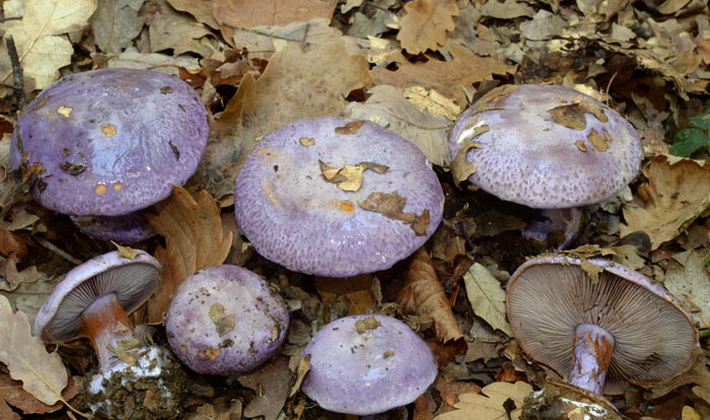
Family: Cobweb (Cortinariaceae)
Season: September October
Growth: singly or in small groups
Description:

The hat is first convex, then almost flat, sticky, bright purple.
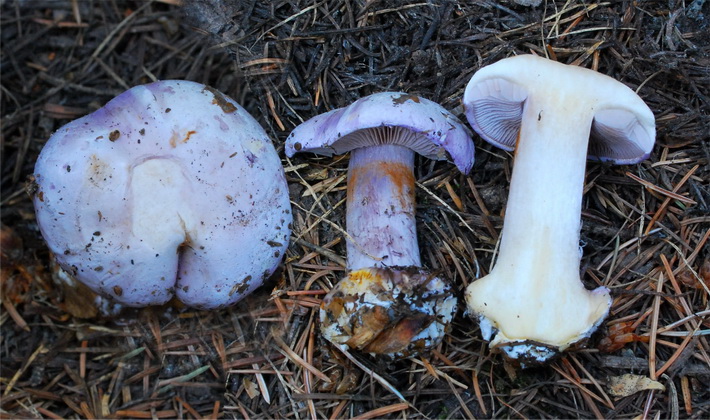
The pulp is white in a hat, lilac in a leg. Lamellas adhered by a tooth, frequent, bright lilac, later lilac-brown.
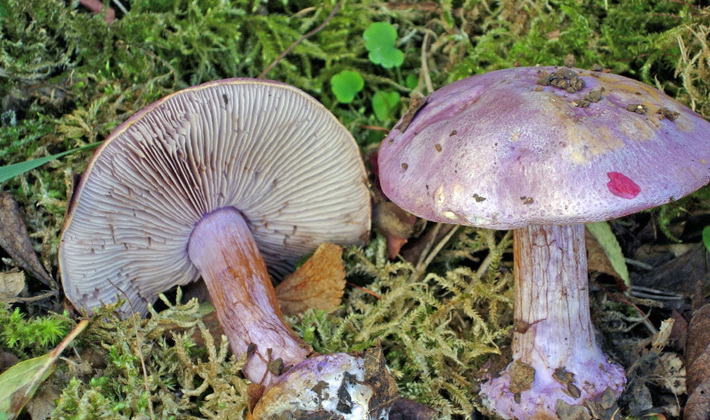
There is a distinct nodule at the base of the leg. The fibrous veil of the young fruiting bodies is pale violet. The foot is bright-violet.
Ecology and distribution:
It occurs in deciduous forests on carbonate soils, forms mycorrhiza with beech, hornbeam, linden, oak. Rare view. Found in Russia in the Penza region and in the Western Caucasus (Krasnodar Territory).
Brilliant cobweb (Cortinarius splendens).
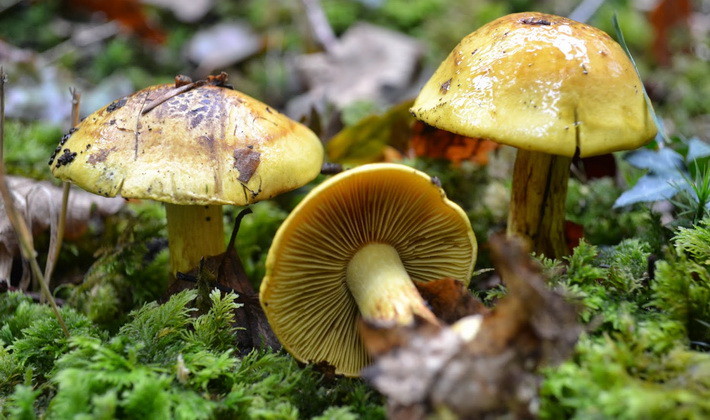
Family: Cobweb (Cortinariaceae)
Season: Aug. Sept
Growth: singly or in small groups
Description:
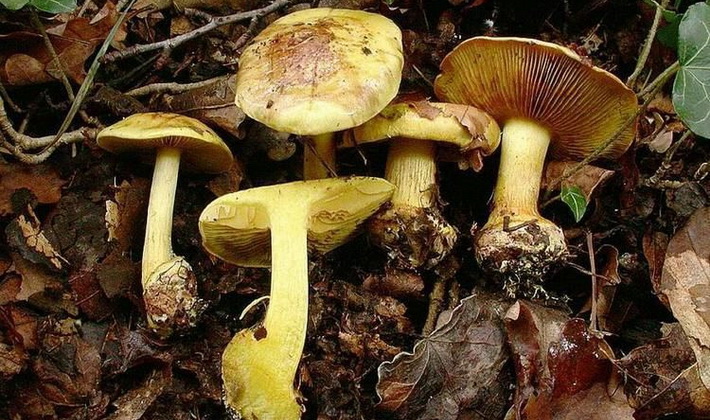
The flesh is lemon yellow or sulfur yellow, sometimes with a bread smell.

The cap in young mushrooms is hemispherical, then opens and becomes convex, covered with mucus.
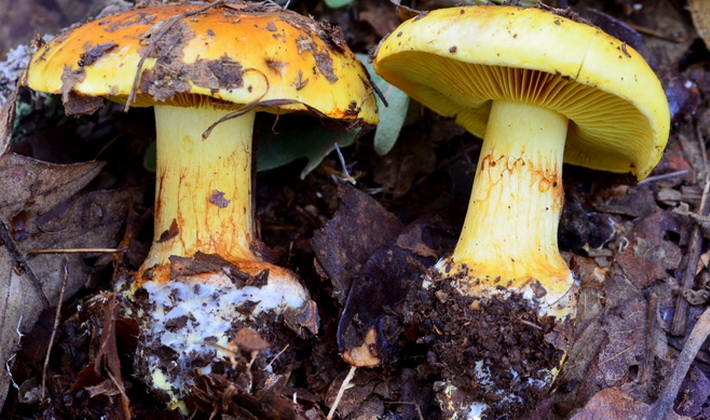
Leg is yellow in color. In the central part, the cap is fibrous-scaly, color is sulfur-yellow or chrome-yellow. In the lower part of the leg is pubescent bulbous thickening. Lamellae with a notch adhered to the stem are yellow in young mushrooms, then acquire a lenish hue.
Deadly poisonous mushroom. Probably contains tollanin toxin.
Ecology and distribution:
It is found in pine and mixed forests. Distributed in Europe. On the territory of Russia found in the Penza region.
Cobweb yellow (Cortinarius triumphans).

Family: Cobweb (Cortinariaceae)
Season: beginning of August - end of September
Growth: in groups and singly
Description:
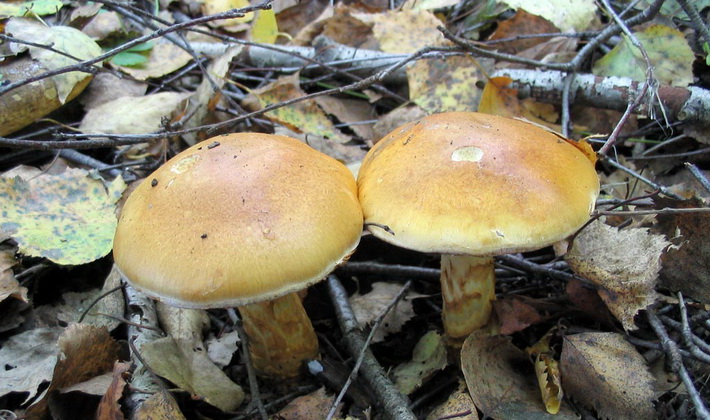
The hat is flat-convex, sticky in wet weather, yellow, ocher-red in the center.
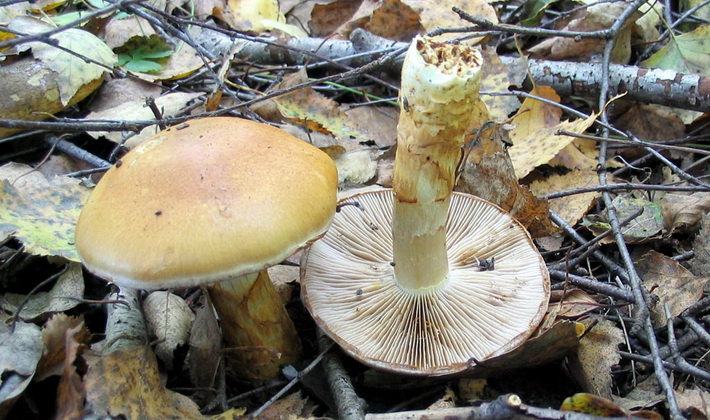
Leg pale yellow, thickened to base.
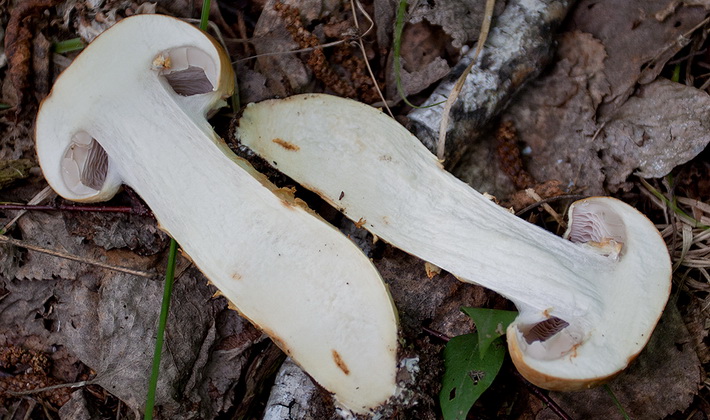
The pulp is whitish with a pleasant smell. The cap of young mushrooms is hemispherical, sometimes flattened in the center. On the leg are torn scaly red belts. The lamellas are overgrown with a tooth, frequent, wide, pale lilac, then clay.
The most delicious of the cobwebs, used fresh in the second course (after boiling), salted, pickled and dried.
Ecology and distribution:
It occurs in deciduous (with birch, oak), mixed and coniferous (spruce-birch, in pine plantations) forests, in bright places, in the grass and on the litter.
Cobweb violet (Cortinarius violaceus).
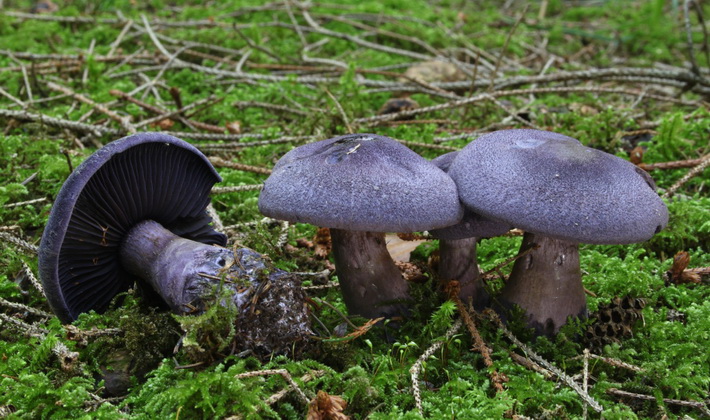
Family: Cobweb (Cortinariaceae)
Season: mid-August - end of September
Growth: in groups and singly
Description:
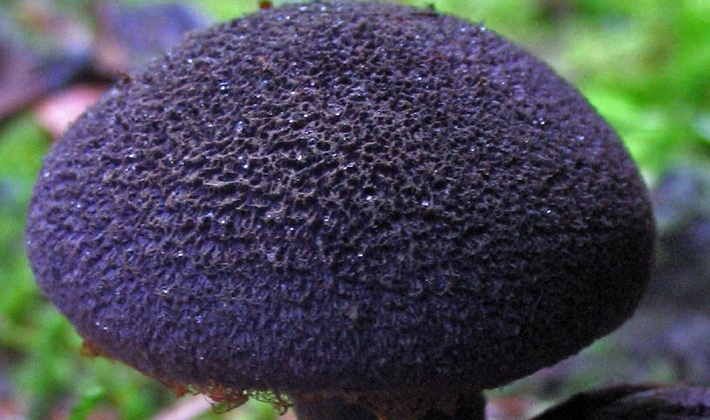
The hat is first convex, then open, felt-scaly, dark purple.
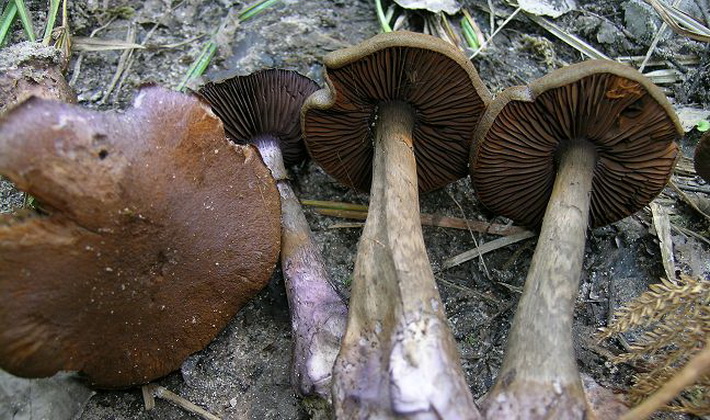
The pulp is whitish, bluish, purple or grayish-purple.
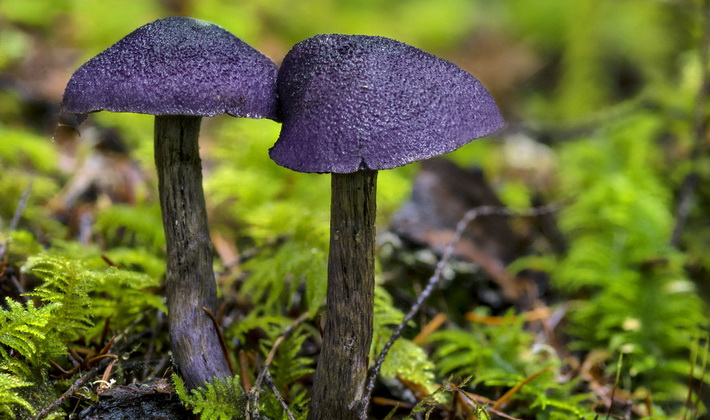
Leg, fibrous, brownish or dark violet, in the upper part covered with small scales. Lamellae overgrown with prong, wide, sparse, dark purple. Tuberous thickening at the base of leg.
Edible mushroom of medium quality, used fresh after boiling for 20 minutes, salted.
Ecology and distribution:
It occurs in deciduous and coniferous (with pine) forests, in pine trees, in humid places. Rare view. It is listed in the Red Book of Russia.
Cylindrical vole (Agrocybe cylindracea).
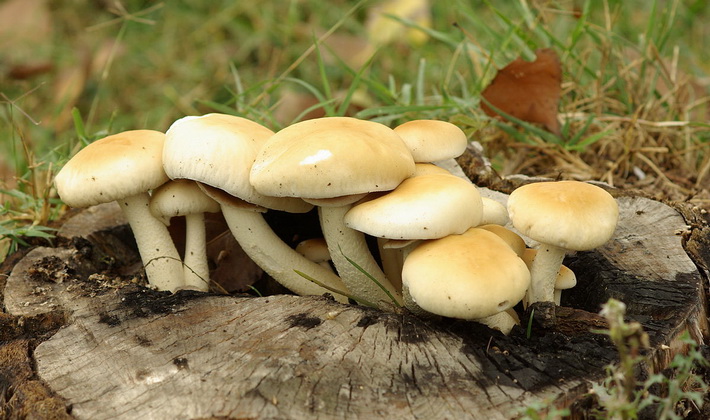
Family: Bolbitia (Bolbitiaceae)
Season: spring - late autumn
Growth: numerous groups
Description:

The cap of this lamellar mushroom is initially hemispherical, then from convex to flat, with a slightly pronounced tubercle; the color is white, buffy, later brownish. The skin is smooth, dry, covered with a mesh of cracks.
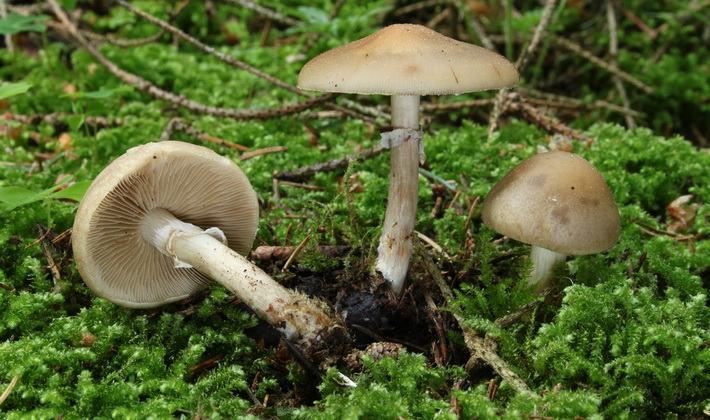
Leg cylindrical, silky, densely pubescent above ring.

The flesh is fleshy, white or slightly brownish, with the smell of wine. The ring is well developed, white, brown when ripened, located high. The plates are thin and wide, narrowly grown, at the beginning light, later brown.
Edible mushroom, widely eaten in southern Europe, cultivated.
Ecology and distribution:
It grows on living and dead deciduous trees. Widely distributed in the subtropics and in the south of the northern temperate zone.
Early flake (Agrocybe praecox).
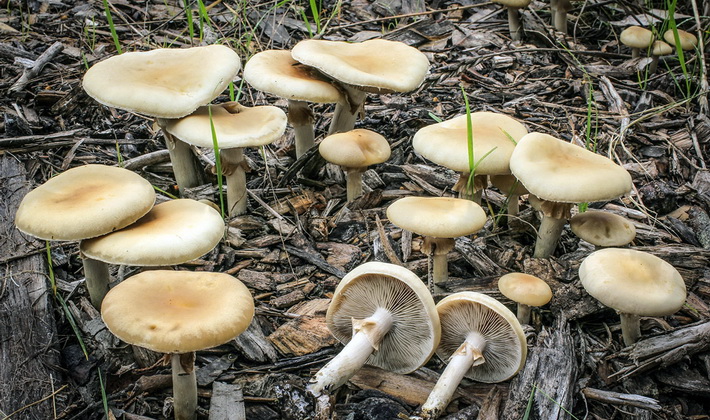
Family: Bolbitia (Bolbitiaceae)
Season: end of May - mid-June
Growth: in groups
Description:
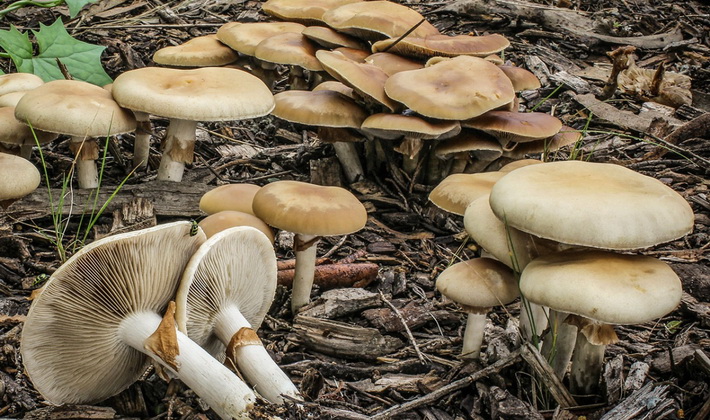
The cap is convex and convex with a wide tubercle, whitish or yellowish. The cap of young mushrooms is hemispherical with a membranous coverlet.
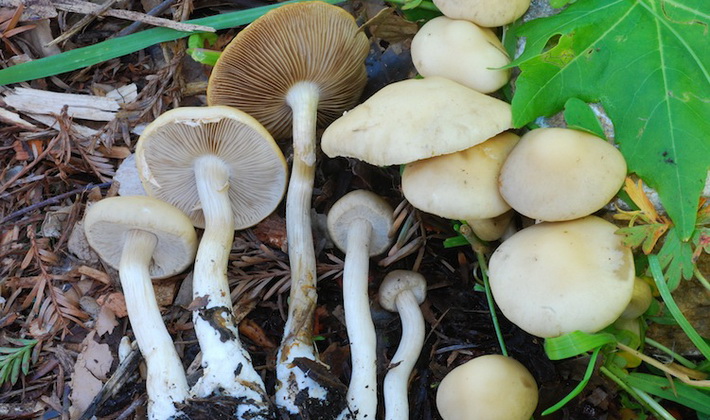
The leg is hollow, fibrous brownish below the ring. The plates are frequent, with a tooth, whitish. The ring is membranous, hanging.
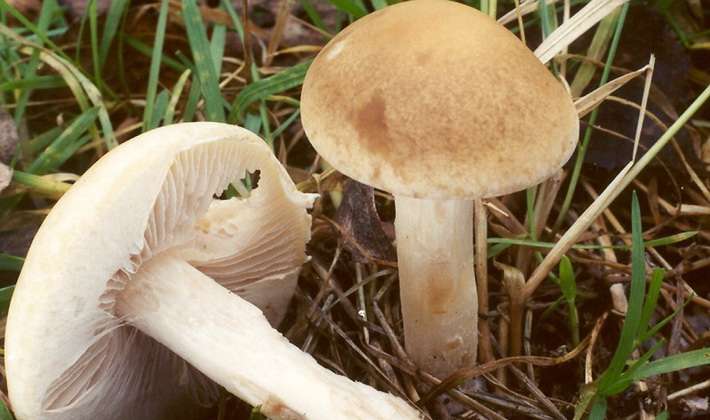
The pulp is white, brownish at the base of the leg, with a mushroom smell.
Conditionally edible mushroom, used fresh in the second courses (after boiling), can be pickled.
Ecology and distribution:
It is found on the edge of the forest, in parks, vegetable gardens, near roads, in shrubs, in grass, on humus.
Galerina edged (Galerina marginata).
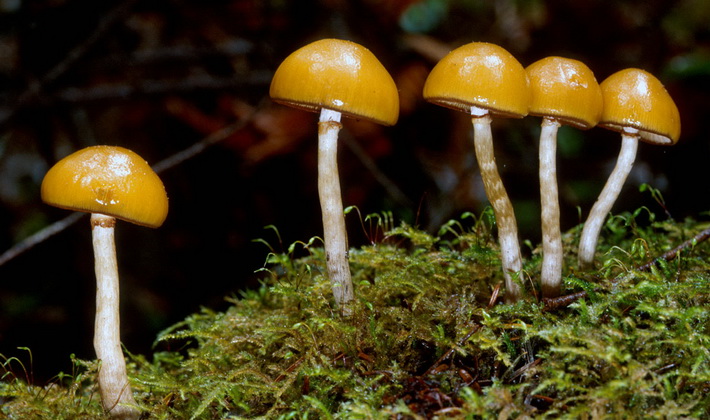
Family: Hymenogastracea (Hymenogastracea)
Season: mid June - October
Growth: in small groups and singly
Description:

The plates are broad-grown, yellowish. The foot is hard, hollow, light on top, yellowish, yellowish ocher below the ring.
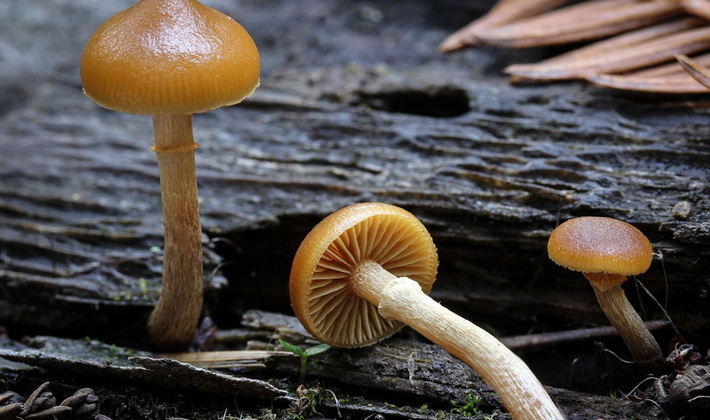
The hat is bulging with a wide blunt tubercle and a thin margin, smooth, ocher-red in the wet state, and yellow in the dry state.
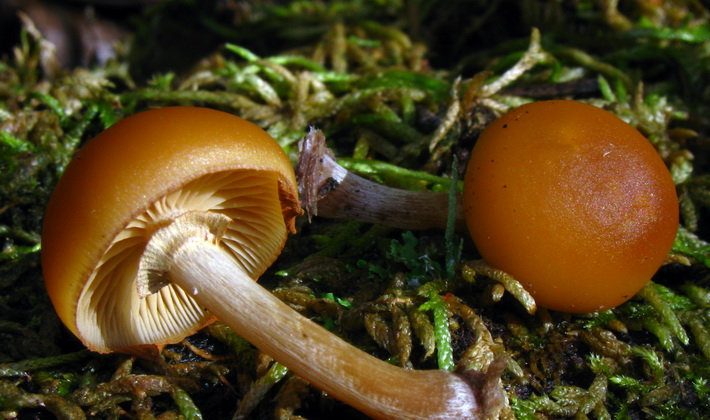
The pulp is watery, reddish. The ring is bent, dark ocher. The cap of young mushrooms is bell-shaped, covered from below with a fibrous-film cover.
The mushroom is poisonous, contains amatoxins that damage the liver.
Ecology and distribution:
It is found on mossy decaying wood of coniferous and deciduous species, in moist places, near marshes. Widely distributed in the northern hemisphere.
Ring-shaped cap (Rozites caperatus).
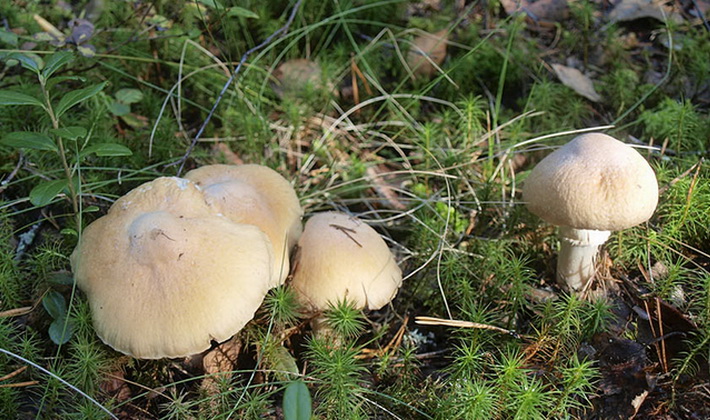
Family: Cobweb (Cortinariaceae)
Season: early July - early October
Growth: usually in small groups
Description:
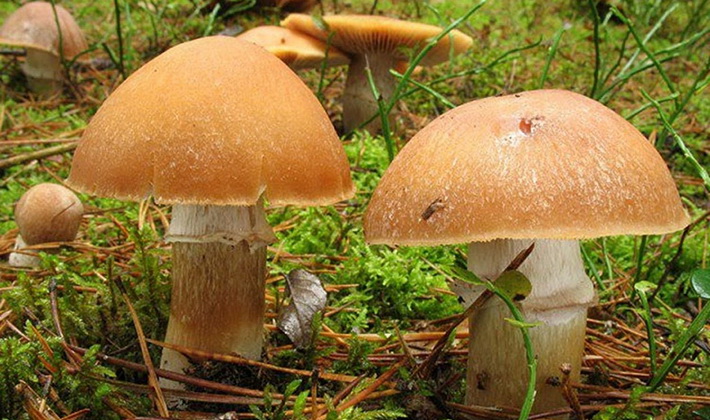
The hat is fleshy, bell-shaped, straightens as it grows, color from gray-yellow to ocher.
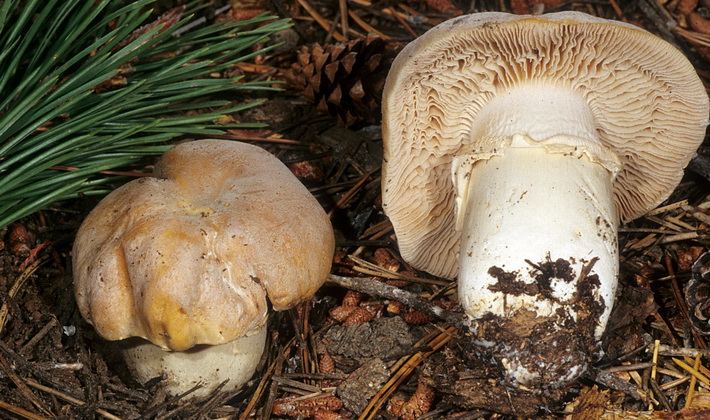
The pulp is friable, white, later yellowing, with a pleasant smell and taste.

The leg is strong, thickened at the base, solid, silky. The silky fibers on the hat are the remains of the bedspread. In dry weather, the edges of the hat often crack. A thin film ring of irregular shape tightly fits the leg. Plates are relatively rare, grown, of different lengths.
Delicious edible mushroom, you can cook in any way.
Ecology and distribution: It forms mycorrhiza mainly with conifers. It grows in mossy places in coniferous and mixed forests, especially in blueberries, less often in oak forests. In Russia, distributed in the western and central regions of the European part.
Psathyrella Candolleana
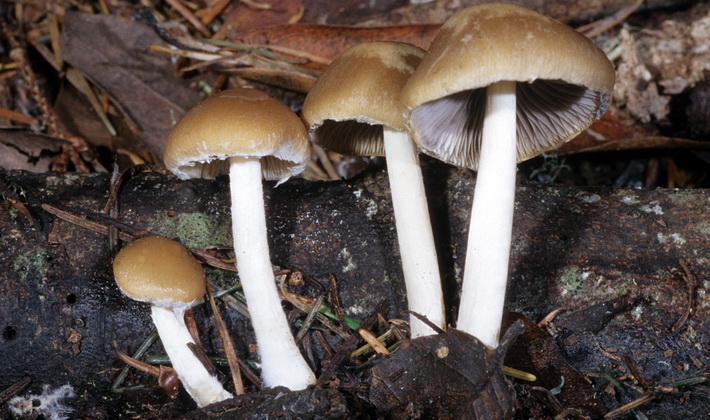
Family: Psatyrellaceae (Psathyrellaceae)
Season: mid June - mid October
Growth: groups, beams
Description:
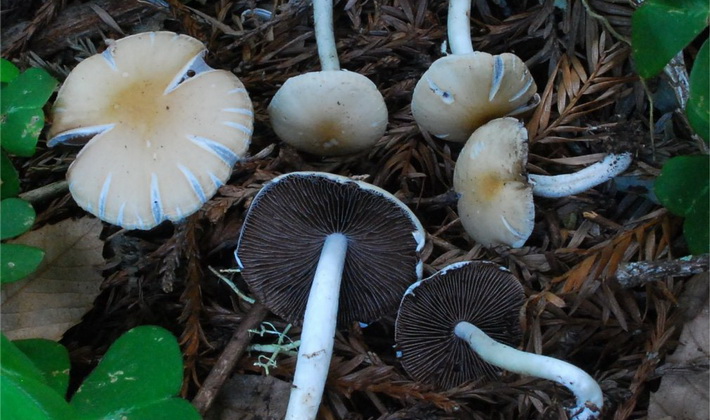
The edge of the hats often cracks. The hat is hemispherical, then bell-shaped or wide-conical. When ripe, the hat opens to flat, with a rounded tubercle.
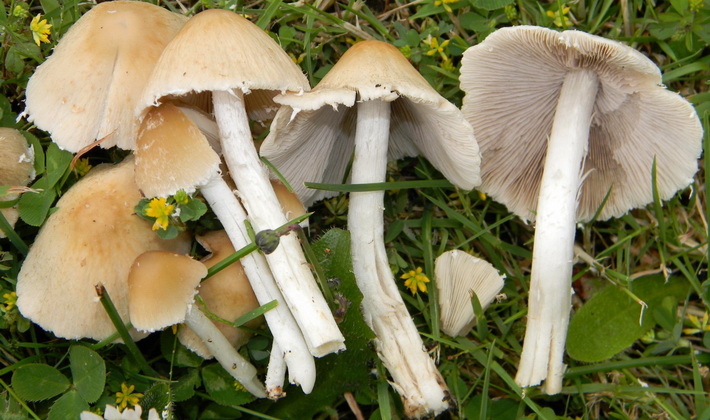
The flesh is white, brittle, without any particular taste or smell. The fibrous remains of the bedspread are noticeable in young mushrooms along the edges of the hat.
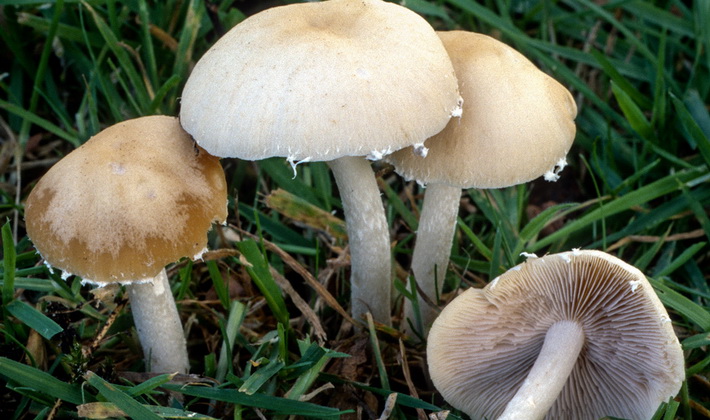
Leg with a thickened base, hollow, white or cream.
Information about the edibility of this fungus, which belongs to the lamellar, is contradictory; collecting is not recommended.
Ecology and distribution:
It grows on soil and decaying hardwood, on stumps, in shrubs, along paths and roads, rarely on living trees.
Shod rowing (Tricholoma caligatum).
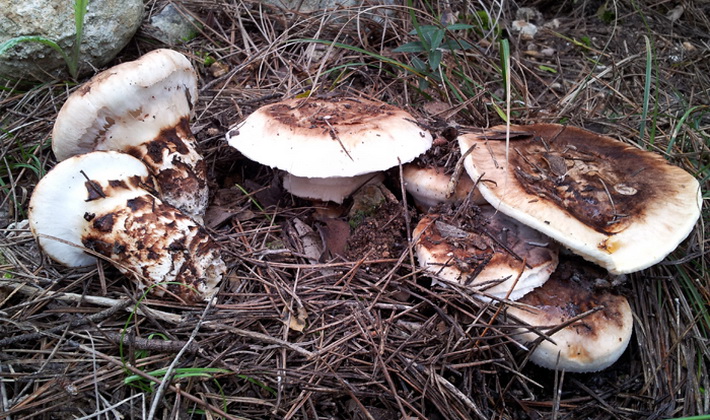
Family: Ordinary (Tricholomataceae)
Season: Aug. Sept
Growth: singly or in small groups
Description:
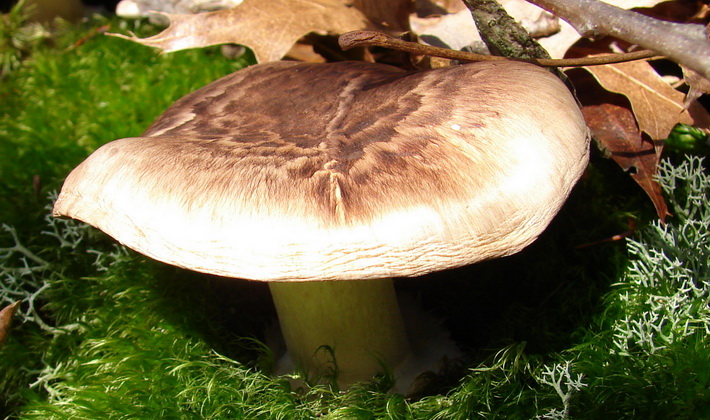
The cap is hemispherical, then it is convexly spread. The remains of the felt cover along the edge of the cap. The plates are frequent, with plates.
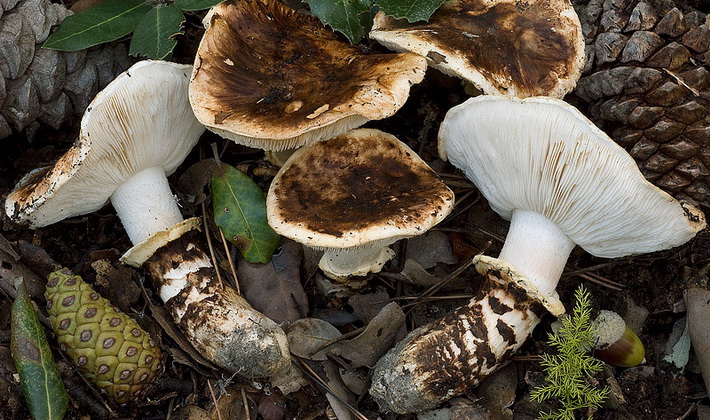
The leg above the ring is smooth, white. The surface of the hat is woolly-fibrous. The foot is felt-fibrous or scaly.
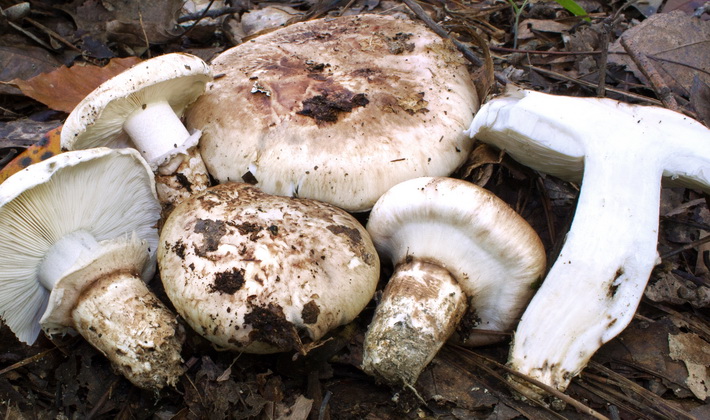
The pulp is white, elastic, fragile in a hat. The taste is fresh, flour, the smell is rare-fruity.
The fungus is edible; in China and Japan it is considered delicious. Used in oriental medicine.
Ecology and distribution:
Forms mycorrhiza with pine. Grows in pine forests on sandy soils. Rare view. It is found in Russia in the Krasnoyarsk Territory and in the Far East.
Matsutake (Tricholoma magnivelare).
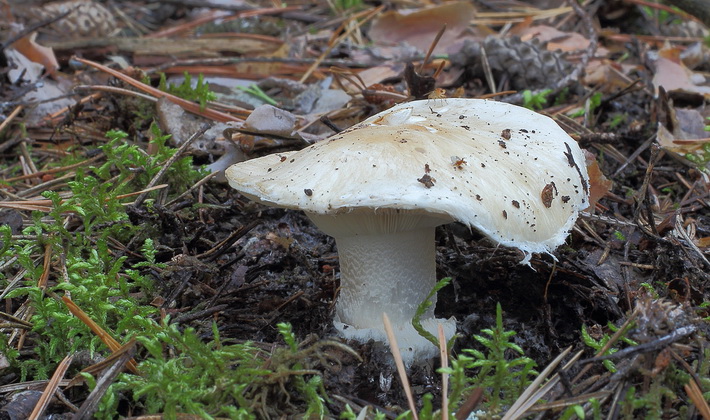
Family: Ordinary (Tricholomataceae)
Season: end of summer - fall
Growth: forms a ring colony
Description:
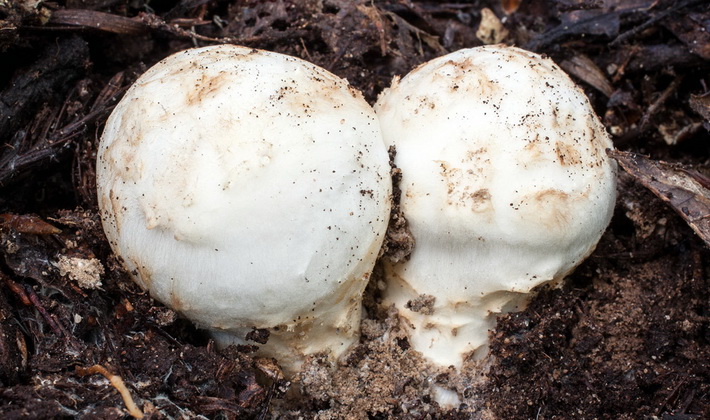
The hat in young specimens is white, in mature ones it is yellow or orange-brownish.
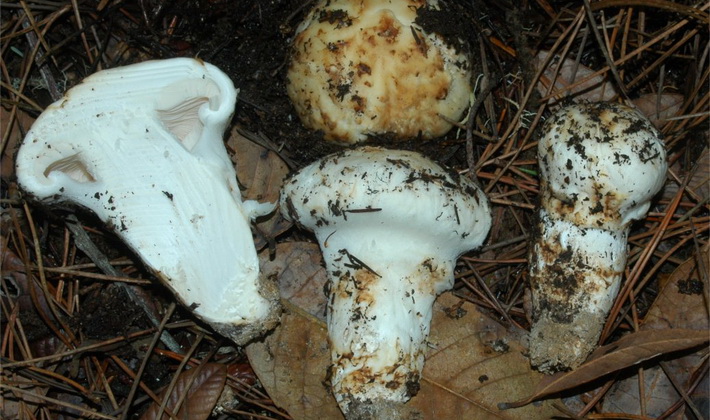
The pulp is white, fleshy, with a delicate aroma.
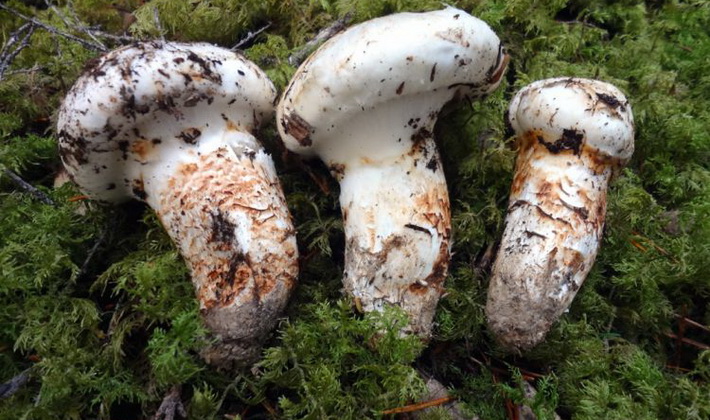
The stalk is dense, fleshy white. In a ripe mushroom, the hat crackes along the edge. The lamellae are frequent, grown, white, brown with age. The remains of the bedspread form a massive ring.
It is especially appreciated in Japanese and Chinese cuisines for its specific pine aroma and exquisite taste.
Ecology and distribution:
Forms mycorrhiza with pine or fir. Grows at the foot of trees, hiding under fallen leaves. Prefer dry arid soil.It is found in Asia, Northern Europe, North America.
Gebeloma root (Hebeloma radicosum).
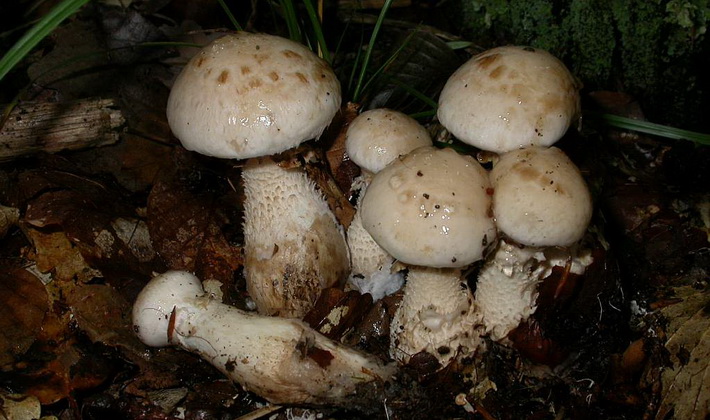
Family: Strophariaceae (Strophariaceae)
Season: July - October
Growth: singly or in small groups
Description:
The skin is almost white to clay brown or light brick, shiny. The surface is covered with brown scales. Lamellae are free or emarginate, frequent, convex or pale-convex.
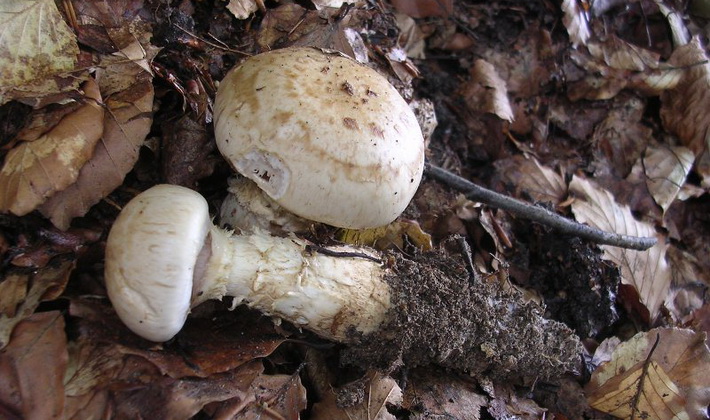
The leg is pale gray or pale brown. The bottom of the leg is fusiform thickening. The long root-shaped part of the leg is immersed in the substrate.
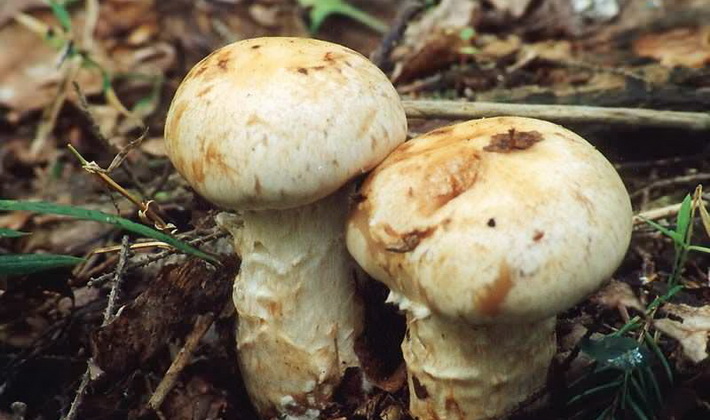
The cap is hemispherical with curled edges, then flat-convex. The ring is membranous, located under the plates.
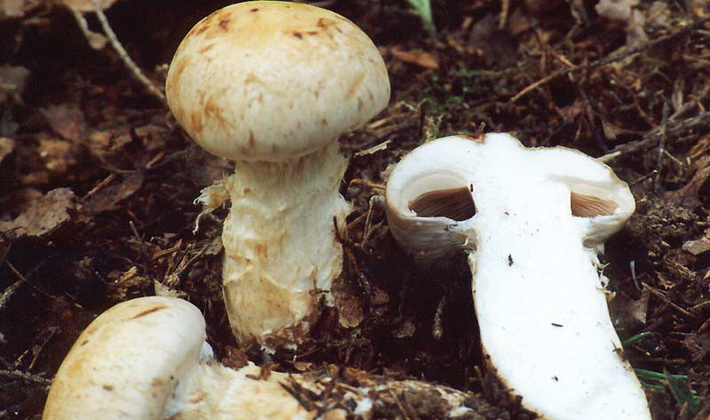
The pulp is fleshy, dense, with the smell of bitter almonds.
Inedible due to the bitter taste.
Ecology and distribution:
It forms mycorrhiza with deciduous trees, especially with oak. It occurs in deciduous forests on well-drained calcareous soils, along paths, and often develops on old stumps and woody remains, in mouse burrows.
Gray honey plate (Hypholoma capnoides).
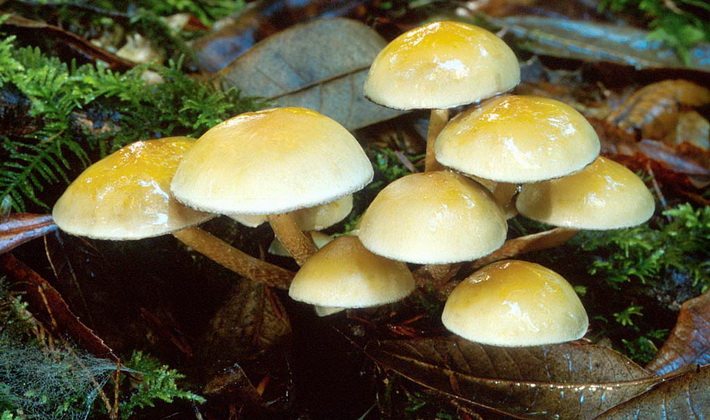
Family: Strophariaceae (Strophariaceae)
Season: mid-august - end of october
Growth: groups and bunch, colonies
Description:
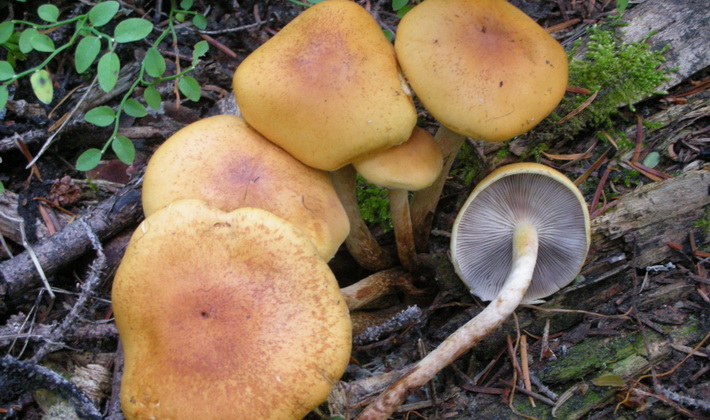
The hat is convex, then prostrate, yellow to brownish color.
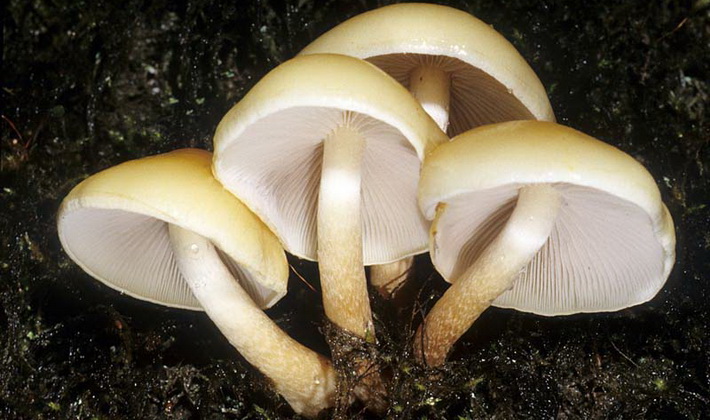
The leg is hollow, without a ring, sometimes with the remains of a private bedspread, yellowish, rusty brown below.
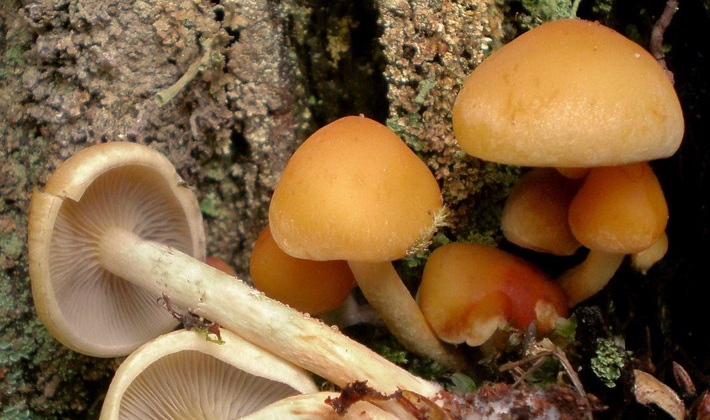
The flesh is white or with a pleasant smell. Young mushroom plates are whitish or yellowish, then bluish-gray.
A good edible mushroom, after boiling it is used in soups and main dishes, salted, pickled and dried.
Ecology and distribution: It occurs in coniferous forests on decaying wood of pine or spruce, on stumps, on roots and around them, on fallen leaves.
Sulfur Yellow False Foam (Hypholoma fasciculare).
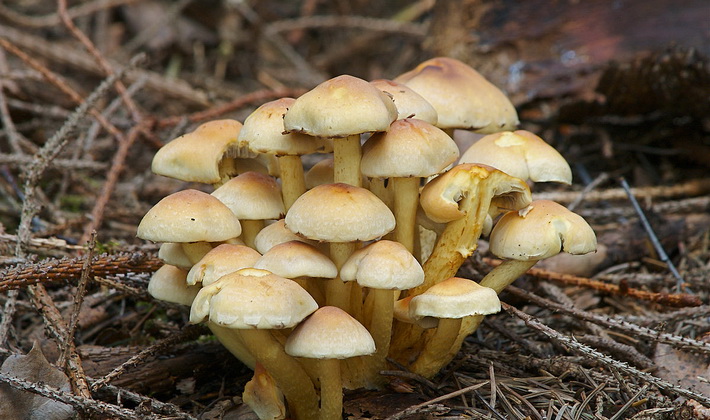
Family: Strophariaceae (Strophariaceae)
Season: end of May - end of October
Growth: groups and bunch, colonies
Description:
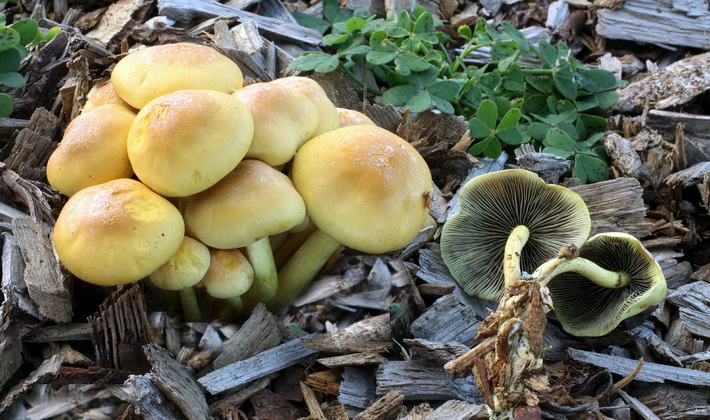
The hat is convex, then half-spread, yellow, in the center with a reddish tint.
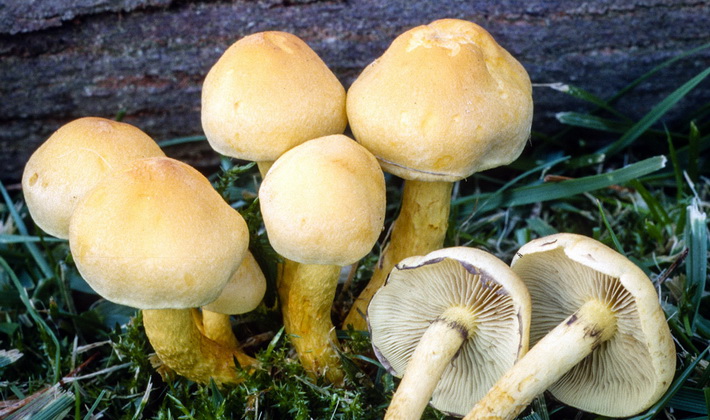
The flesh is sulfur-yellow, bitter, with an unpleasant odor. The plates are grown, sulfur-yellow, then greenish-olive.
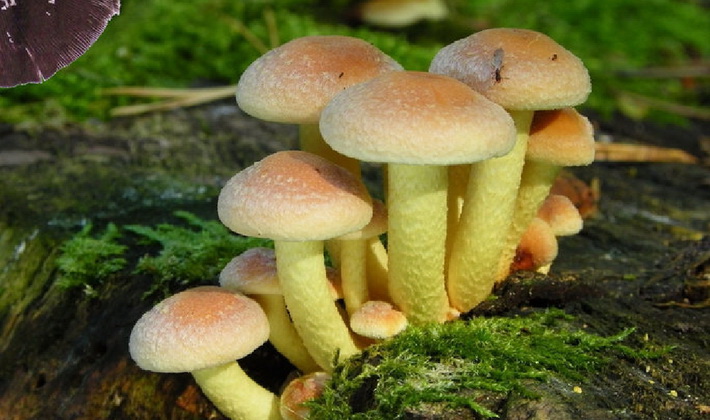
The leg is hollow, often curved, yellow.
Weakly poisonous mushroom, causes intestinal upset.
Ecology and distribution:
It is found in deciduous and coniferous forests on decaying deciduous wood (birch, oak) and, less commonly, conifers (pine, spruce), on stumps, near them, on felling.
Summer honey agaric (Kuehneromyces mutabilis).
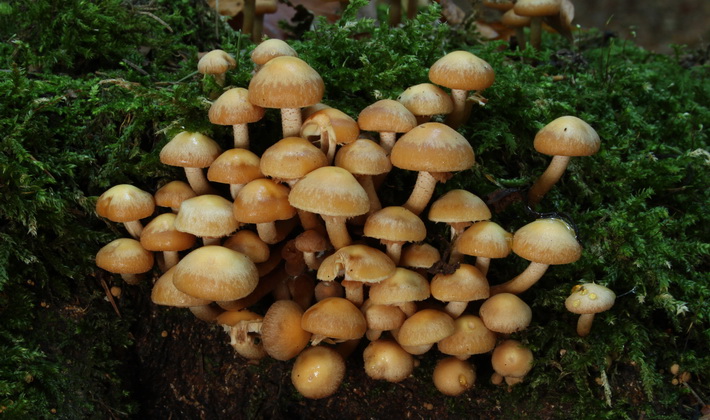
Family: Strophariaceae (Strophariaceae)
Season: end of May - end of October
Growth: bunch group, colony
Description:
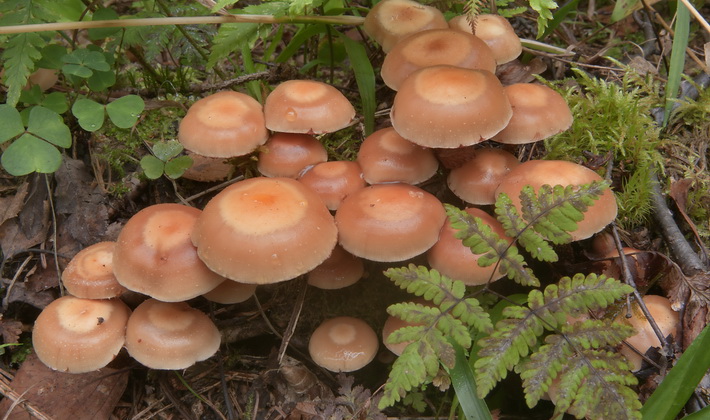
The cap of young mushrooms is convex.
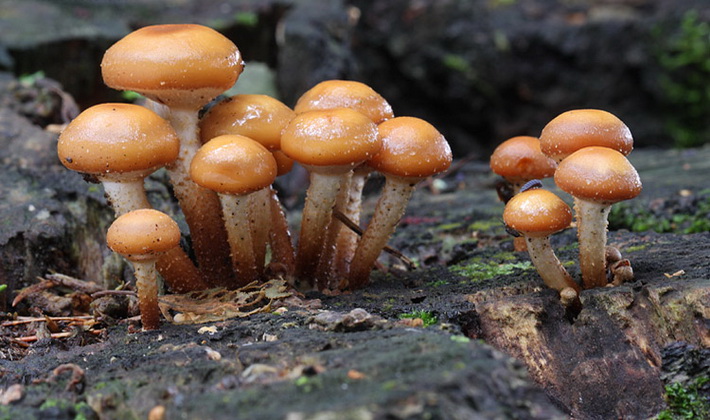
The leg is tight; in the upper part, lighter than the hat, smooth. The skin is smooth, mucous. The ring is membranous, narrow, clearly visible in young mushrooms. Small dark scales appear on the leg below the leg. As the mushroom ages, the hat becomes flat, with a pronounced wide tubercle. The ring is often stained with precipitated spores in a buffy-brown color.
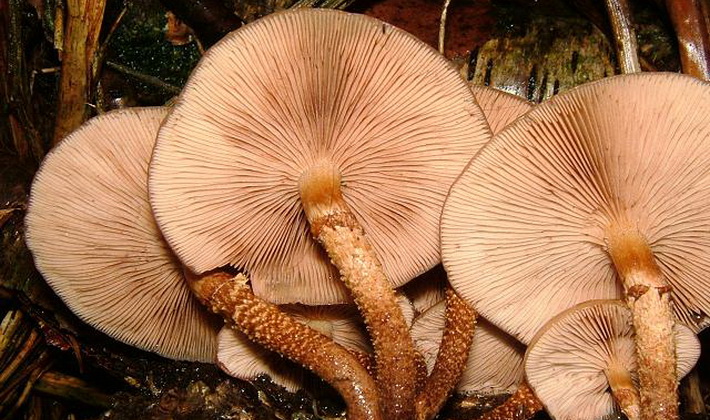
The plates are grown or descending, relatively light brown-brown at first. The pulp is watery, pale yellow-brown in color, with a mild taste and a pleasant smell of fresh wood. The edges of the hat with noticeable grooves. With age, the ring may disappear. The hat is often lighter in the middle and darker at the edges. In the leg the flesh is darker. In rainy weather, the hat is translucent, brownish, in dry - dull, honey-yellow.
Delicious edible mushroom, used fresh (after boiling for 5 minutes) in soups and main dishes, can be salted, dried and pickled. It is only necessary to collect hats. Legs are edible in young undisclosed mushrooms; later they become tough. In dry weather, honey agarics often turn worms starting from the leg.
Ecology and distribution:
It grows in deciduous and mixed, less often in coniferous, forests on decaying hardwood (usually birch), on damaged living trees, rarely on spruce wood, on and around stumps, in gardens, parks, and wooden buildings. In some countries of Europe and in Japan it is cultivated on an industrial scale.
Similar species.
Summer honey agaric can be confused with a dangerous poisonous mushroom galleria fringed (Galerina marginata). Galerinas are distinguished by somewhat smaller sizes and the fibrous surface of the lower part of the leg. Inedible or slightly poisonous false mushrooms of the genus Hypholoma do not have a ring on the leg.
See how agaric mushrooms look in the photo, the names of which are given above:
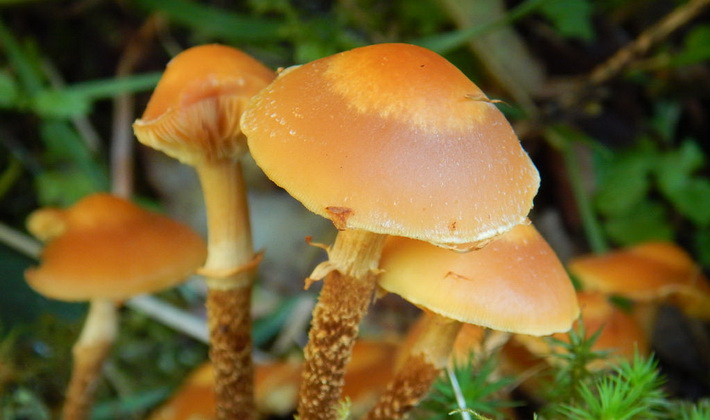
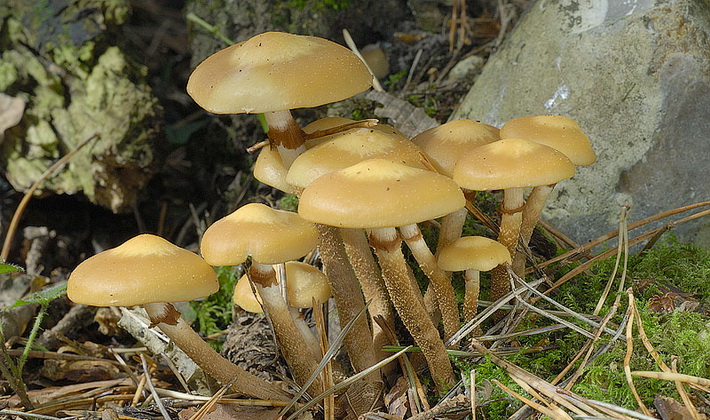

Golden flake (Pholiota aurivella).
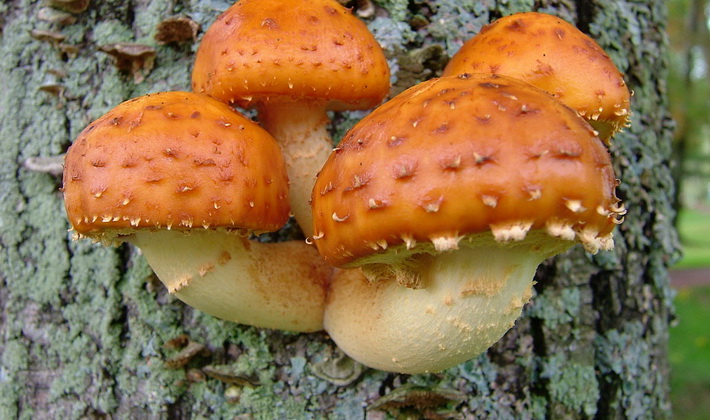
Family: Strophariaceae (Strophariaceae)
Season: end of July - mid-October
Growth: in large groups, often several years in one place
Description:
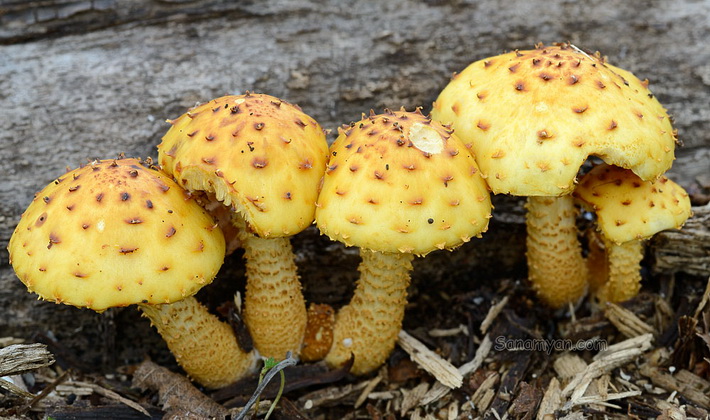
The cap of young mushrooms is hemispherical with curved edges, golden yellow or rusty yellow. The cap of mature mushrooms is flat-round, sometimes with a tubercle in the center.
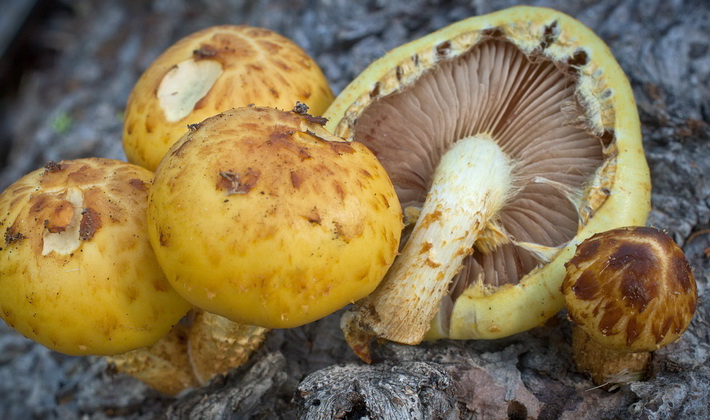
The flesh of young mushrooms is white, of mature ones yellowish. In wet weather, the hat is sticky. The hat is covered with rare brown scales.
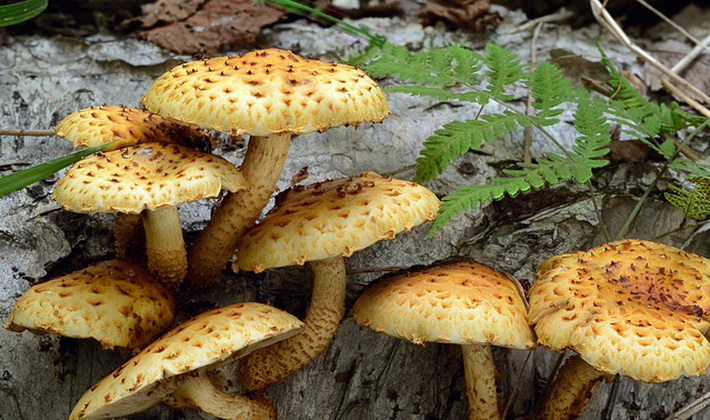
The leg is yellow, covered with dark brown scales. The ring of mature mushrooms disappears. The lamellae adhered to the leg with a tooth, first yellow, then rusty-brown.
Conditionally edible mushroom. After boiling, it is consumed fresh, salted and pickled. The legs of mature mushrooms are inedible.
Ecology and distribution:
They grow on dead and living hardwood (aspen, birch, willow).
Alder flake (Pholiota alnicola).
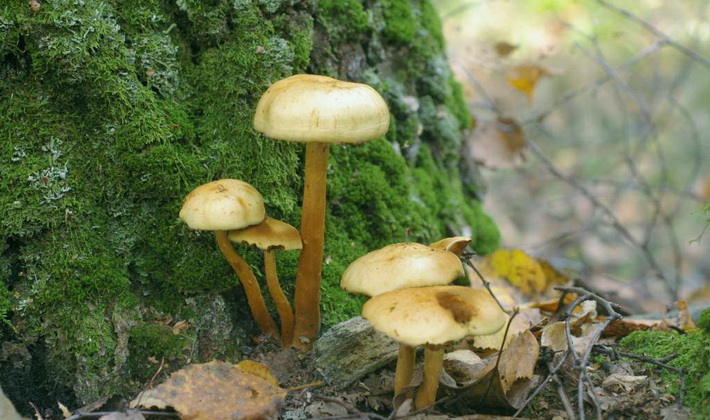
Family: Strophariaceae (Strophariaceae)
Season: mid-August - end of September
Growth: groups and colonies
Description:
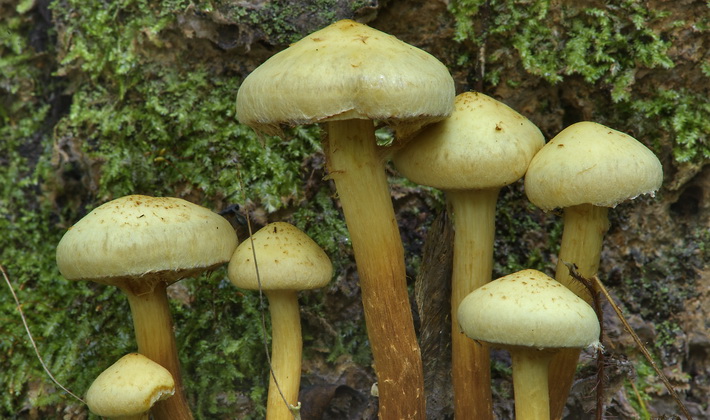
The cap of young mushrooms is convex.
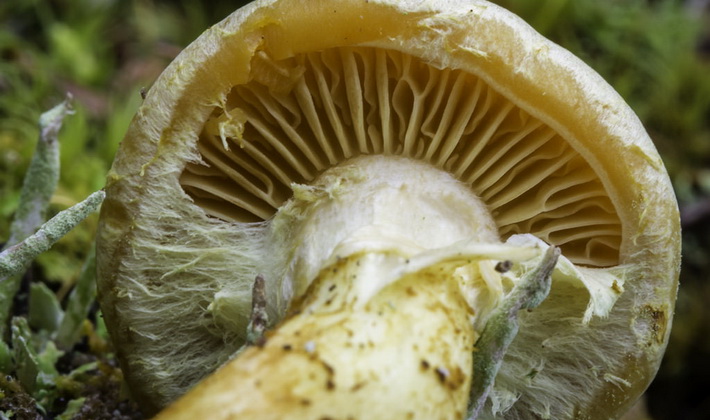
The flesh is yellowish, with an unpleasant odor and a bitter taste. Lamellas are overgrown, yellowish, when ripe, rusty-brown.
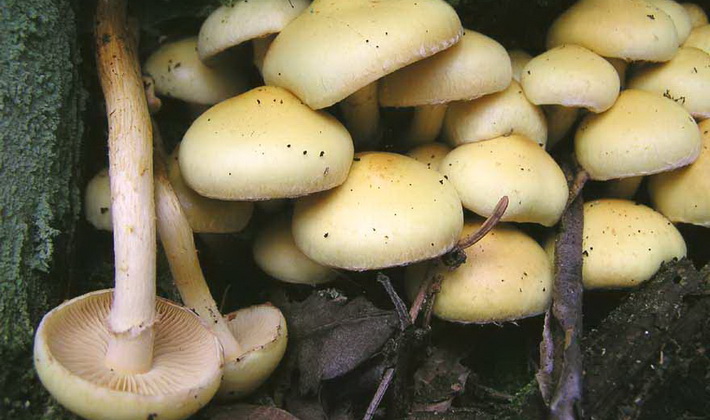
On the stem there is a narrow brown ring or its remains. A hat of ripe mushrooms is open, with a tubercle in the center, yellow or reddish, sticky. The foot under the ring is rusty-brown, fibrous. Rare brownish scales are visible on the hat.
Ecology and distribution:
They grow in deciduous forests, at the base of deciduous trees (birch, alder, willow), on stumps and near them, in the grass.
Flake yellowish-greenish (Pholiota gummosa).
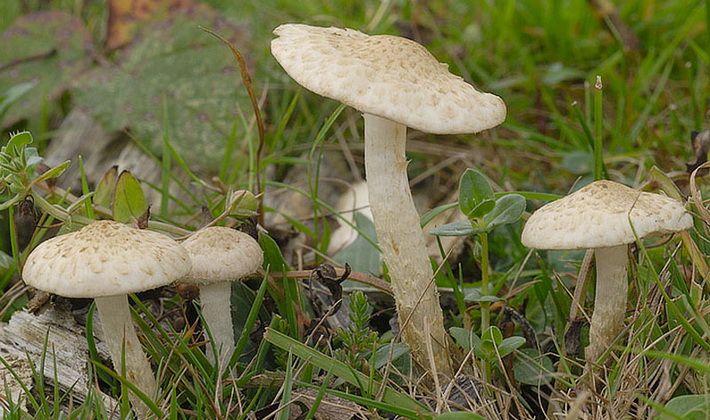
Family: Strophariaceae (Strophariaceae)
Season: mid August - mid October
Growth: in groups
Description:

The flesh is yellowish, odorless and tasteless.
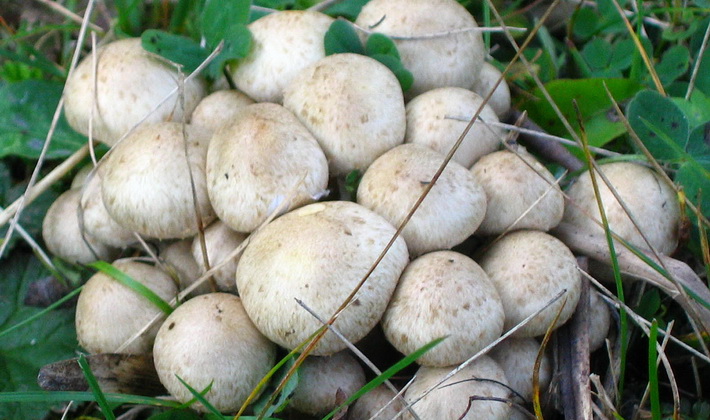
The cap is hemispherical, later prostrate, with a tubercle in the center.
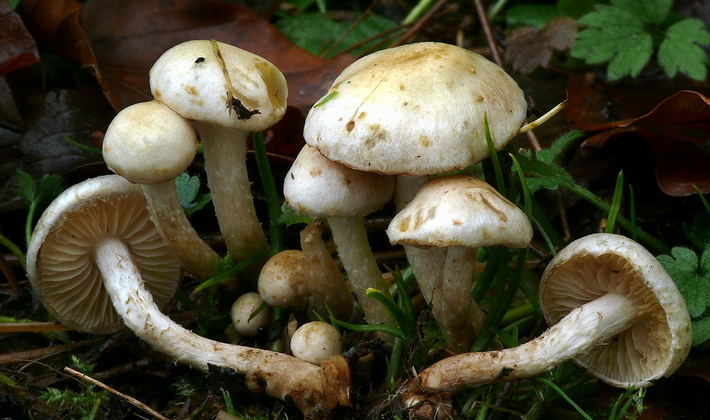
Leg is curved, dense, at the base of a rusty color. Lamellae adhered to the leg, frequent, creamy mucous, sticky, light yellow, sometimes with a greenish tint, finely scaly. The surface of the cap is mucous, sticky, light yellow, sometimes with a greenish tint, finely scaly.
Conditionally edible mushroom. After boiling, it is consumed fresh and pickled.
Ecology and distribution:
They grow on the stumps of deciduous trees and near them, in the grass.
Here you can see photos of edible and poisonous lamellar mushrooms, the names and descriptions of which are presented in this article:
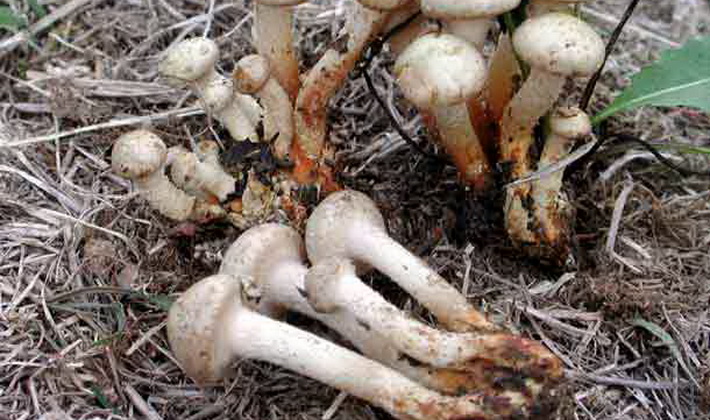
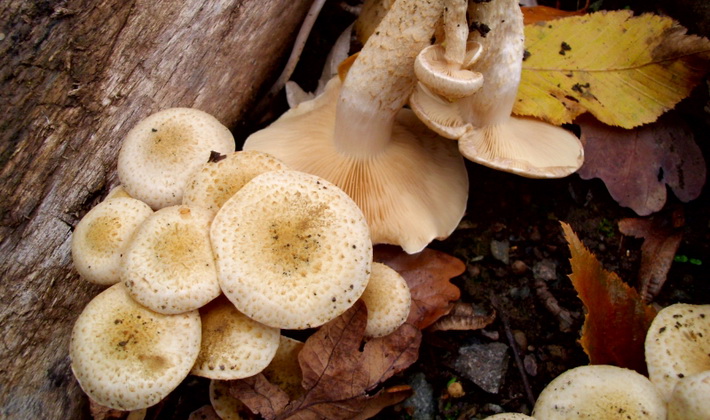
Carboniferous flake (Pholiota highlandensis).
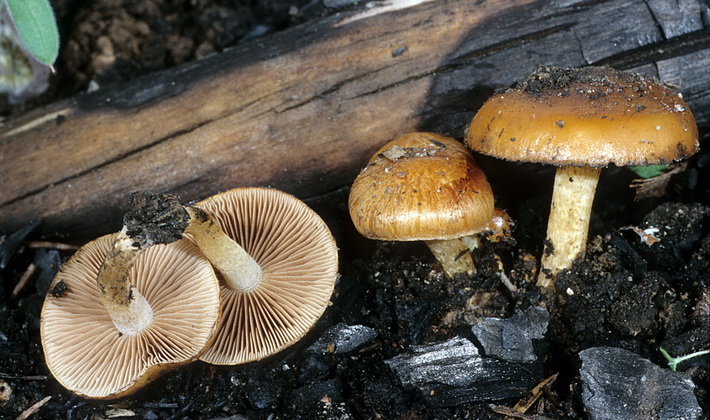
Family: Strophariaceae (Strophariaceae)
Season: mid June - November
Growth: in groups
Description:

Lamellae narrowly grown, frequent, bright, later olive-brown. The cap is convex, then convexly spread with a wide truncated tubercle.
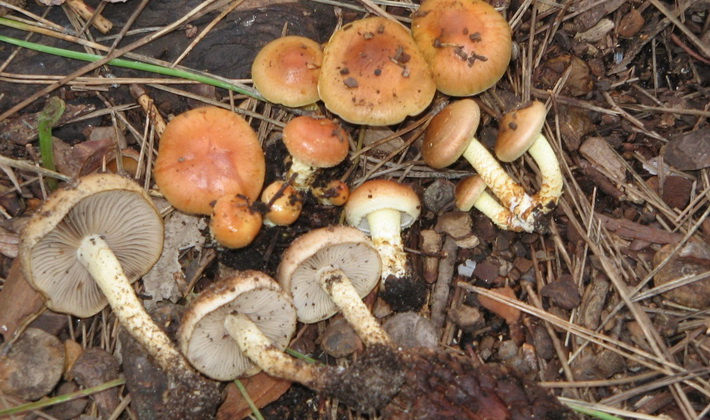
The flesh is yellowish brown with a faint unpleasant odor. Fibrous flakes are visible in young mushrooms at the edge of the cap.

The lower leg is covered with small red-brown scales. The skin is ocher-brown, slightly sticky, with small radial scales.
It does not represent culinary value, but after boiling it can be consumed fresh in the second courses and pickled.
Ecology and distribution:
It grows on abandoned campfires in open, lit places. Distributed in the northern temperate zone.
Adhesive flake (Pholiota lenta).

Family: Strophariaceae (Strophariaceae)
Season: end of August - November
Growth: in groups
Description:
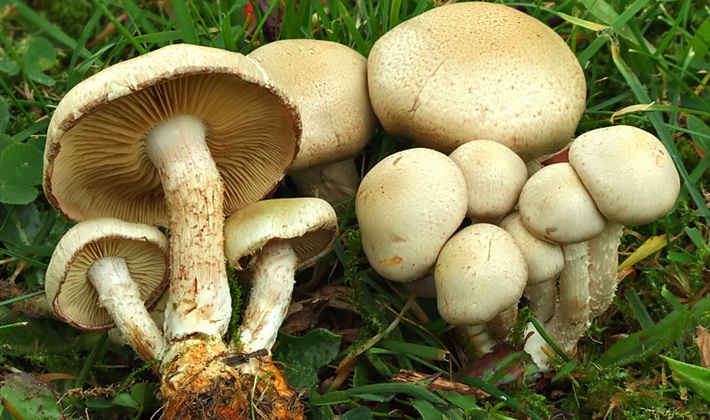
The hat is first convex, then open, sticky, cream.
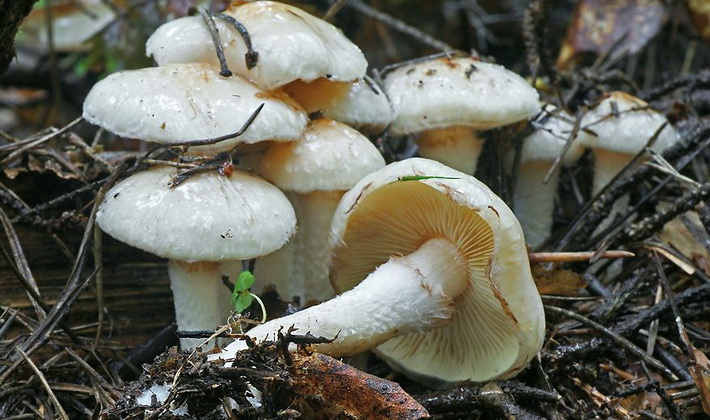
The flesh is dense, yellowish, with a pungent odor. The flesh in the leg is watery. The lamellae are frequent, overgrown, cream. The lower rings on the leg are light pressed scales.
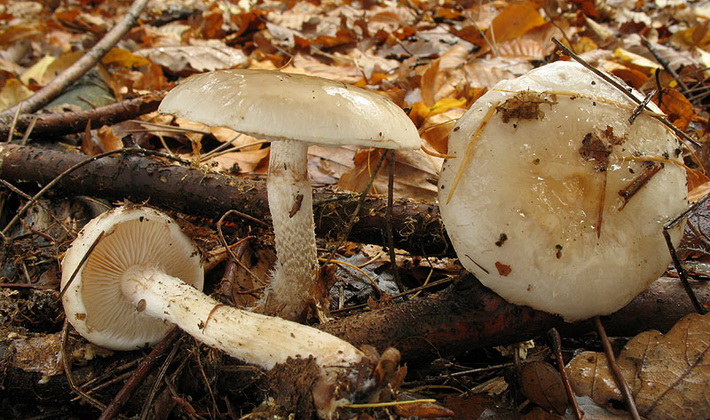
The leg is dense, with fibrous remnants of the ring.
Edible mushroom of low quality. After boiling, you can use fresh in the second course, salted and pickled. Better to collect some hats.
Ecology and distribution:
Grows near coniferous trees (spruce, pine), near rotting wood, in shrubs, in moss.
Common Scale (Pholiota squarrosa).
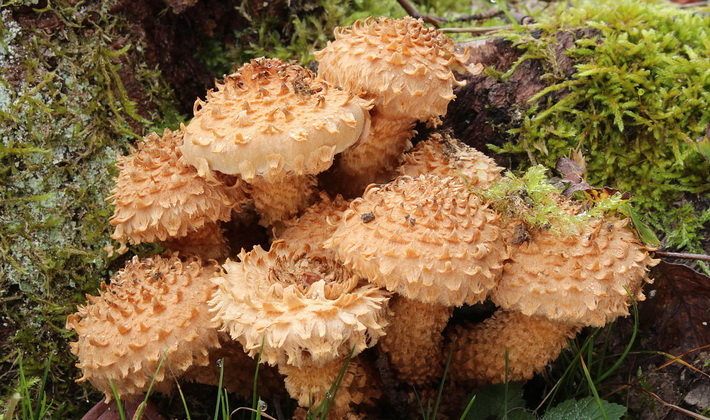
Family: Strophariaceae (Strophariaceae)
Season: mid July - early October
Growth: bundle groups, colonies
Description:
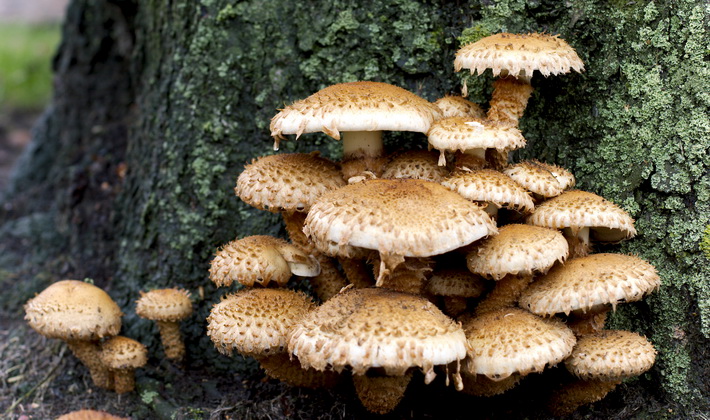
The cap is covered with numerous brown pointed scales. Lamellae are overgrown, frequent, yellow-olive. The cap is buffy, along the edge pale yellow, in young mushrooms it is round-shaped or hemispherical.

Leg with an annular scaly belt in the upper part.
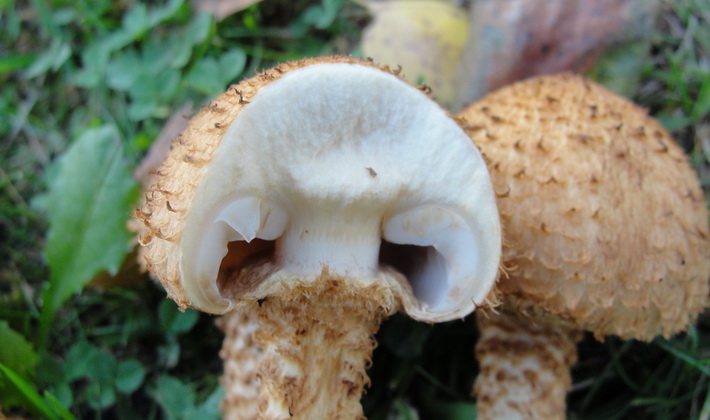
The pulp is dense, yellowish or brownish. Below the girdle, the leg is densely covered with brown scales.
Conditionally edible mushroom. Better to use in pickles and pickled.
Ecology and distribution:
It grows on dead and living wood, around trunks, on the roots of deciduous (birch, aspen) and less often coniferous (spruce) trees, on stumps and around them.
Stropharia coronaria (Stropharia coronilla).
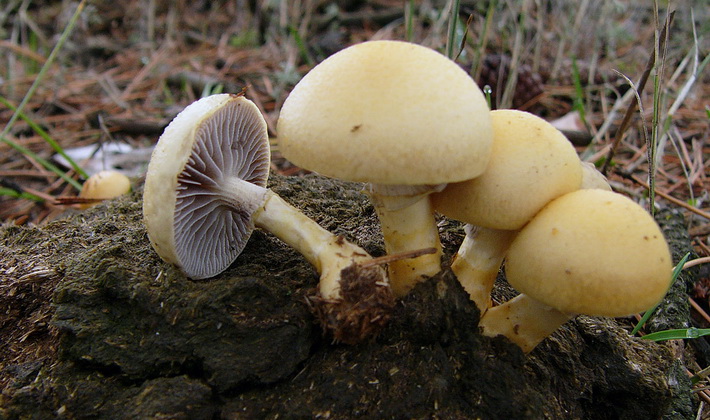
Family: Strophariaceae (Strophariaceae)
Season: June - September
Growth: absent-mindedly or in small groups, singly or 2-3 in a joint
Description:
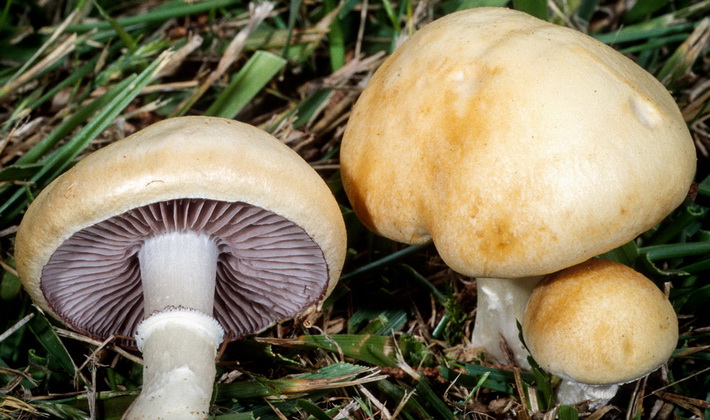
The hat is hemispherical, smooth, lemon yellow.
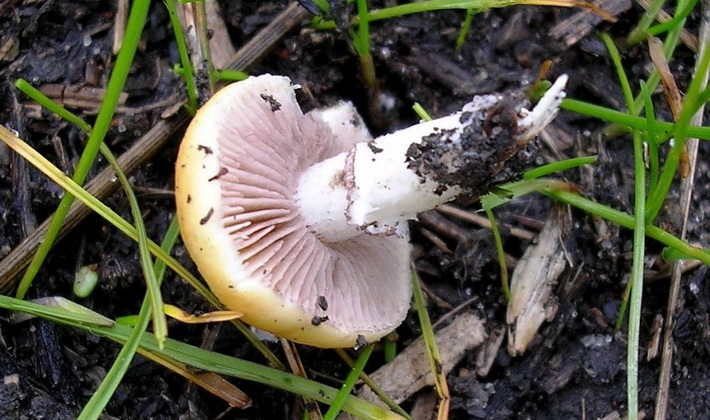
The pulp is whitish, dense, fleshy, the taste and smell are pleasant. The ring is narrow, dense, striped.
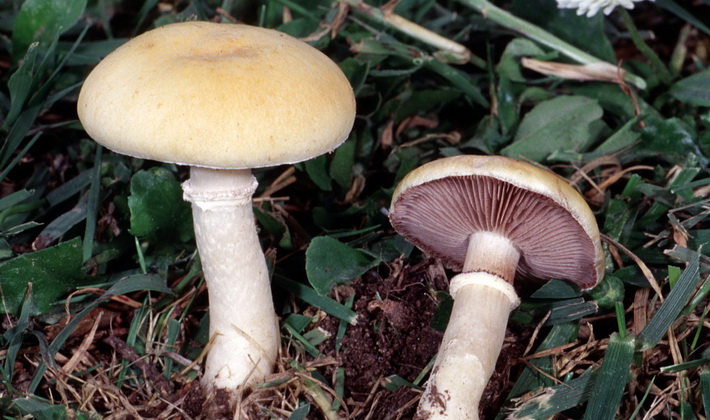
The leg is smooth, sometimes thickened below, white. The lamellae adherent to the leg with a prong, lilac-gray, then brownish-black.
Edibility is controversial; eating is not recommended.
Ecology and distribution:
It grows in grass in meadows, in fields, in gardens and parks, in pastures, less often in forests. Prefers sandy or man-made soil.
Ring (Stropharia rugoso-annulata).
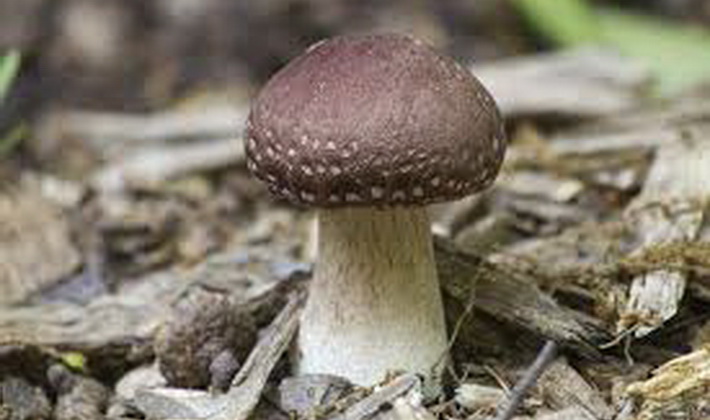
Family: Strophariaceae (Strophariaceae)
Season: June - October
Growth: in groups
Description:
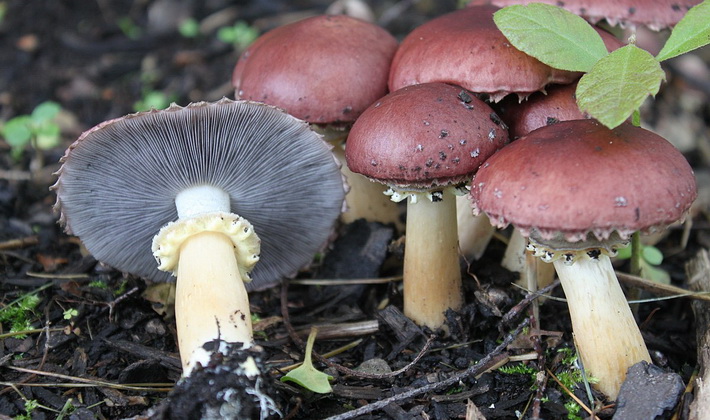
The ring is membrane-shaped, whitish. In youth, the plates are gray-purple, in old age brown-violet, frequent, adhered to the stem. The flesh is dense, white, and tender.
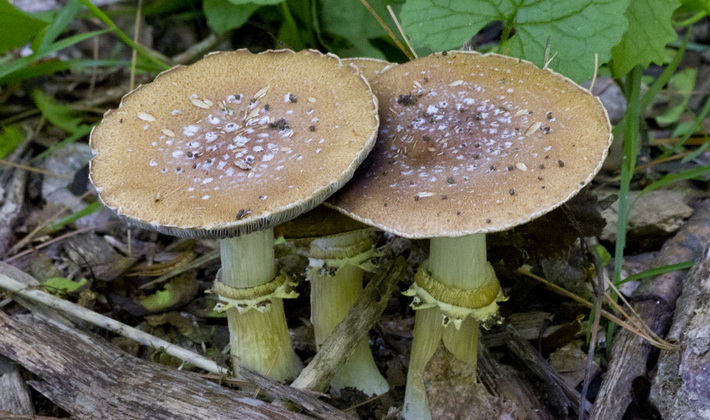
The hat is open, yellow or reddish-brown in old age. The hat is hemispherical, closed in youth. The edge of the hat is initially wrapped, with the remains of the bedspread.

The leg is thick, hard, smooth, whitish, later brownish, with a ribbed ring, hollow in old age.
The mushroom can be fried, boiled, stewed, used for salads and canning.
Ecology and distribution:
It grows on well-fertilized soil, plant debris, usually outside the forest, but occasionally in deciduous forests. It is found in Russia in the Far East. It is grown industrially.
Hemispheric stropharia (Stropharia semiglobata).
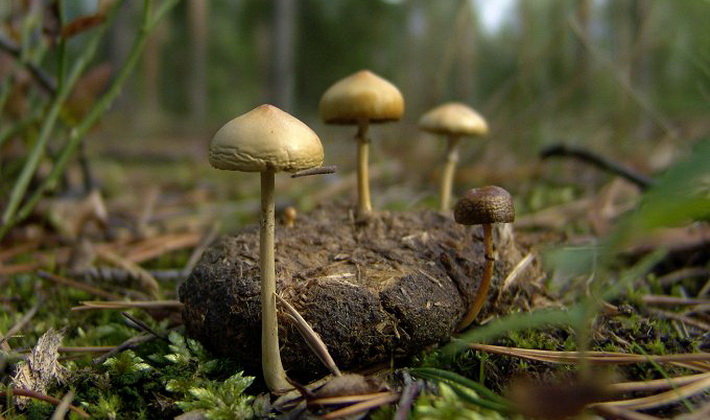
Family: Strophariaceae (Strophariaceae)
Season: Aug. Sept
Growth: in small groups, less often singly
Description:

Hat at a young age is hemispherical, then convex, sometimes flat, smooth, light yellow or tan
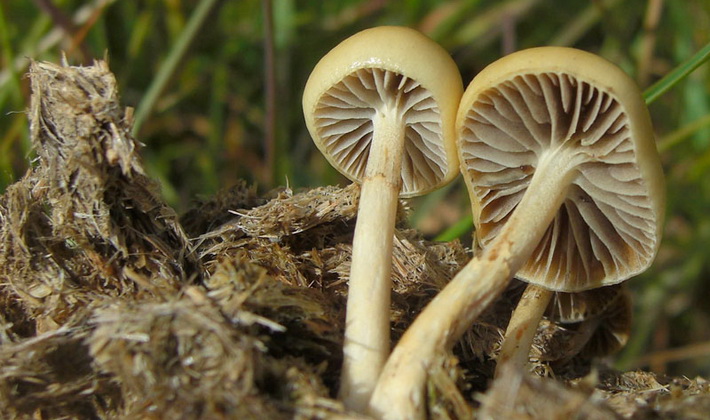
The pulp is whitish or yellowish in color. The edge of the cap is sometimes covered with whitish remains of the bedspread.
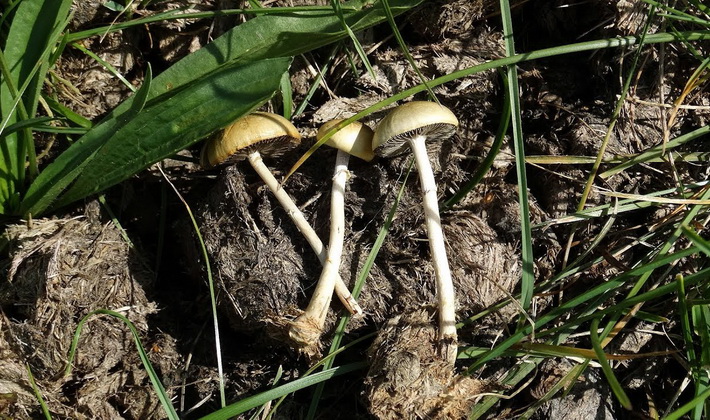
Leg flat or slightly thickened at the base.
The information about edibility is contradictory.
Ecology and distribution:
It grows on horse and cow manure or on fertilized manure soil. Appears after the rains.
Autumn honey agaric (Armillaria mellea).
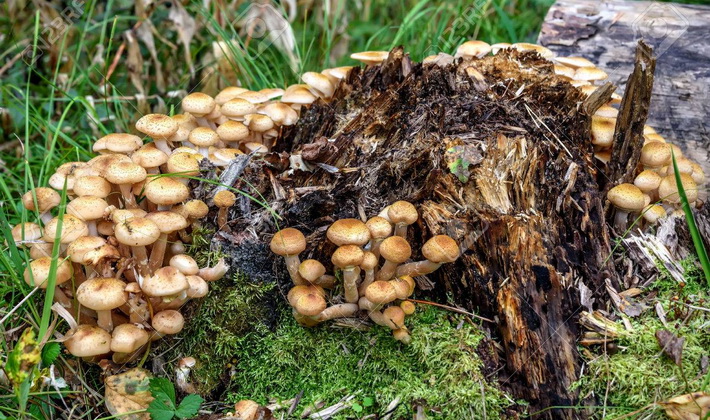
Family: Physalacriaceae (Physalacriaceae)
Season: August - October
Growth: in groups
Description:
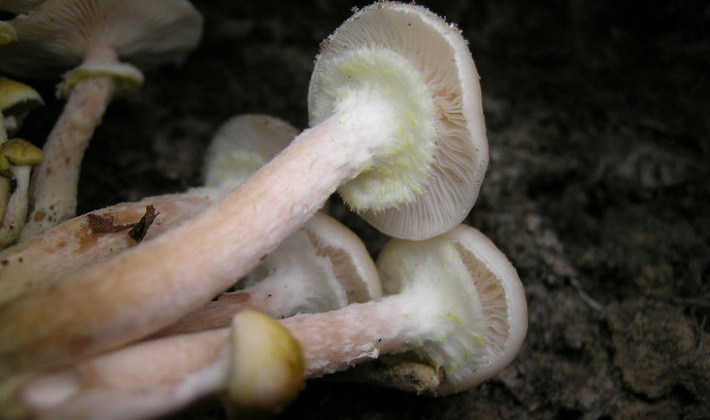
The pulp of the leg is fibrous, stiff. In the upper part of the leg is a white ring.
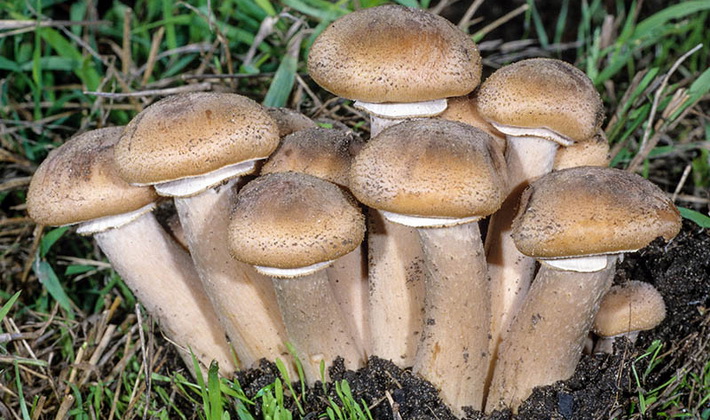
The cap of young mushrooms is spherical, then flat-convex with a tubercle in the center, yellow-brown, with small brown scales. The flesh is dense, white, with a pleasant smell and sour taste. The plates are slightly descending, frequent, first white-yellowish, then light brown.
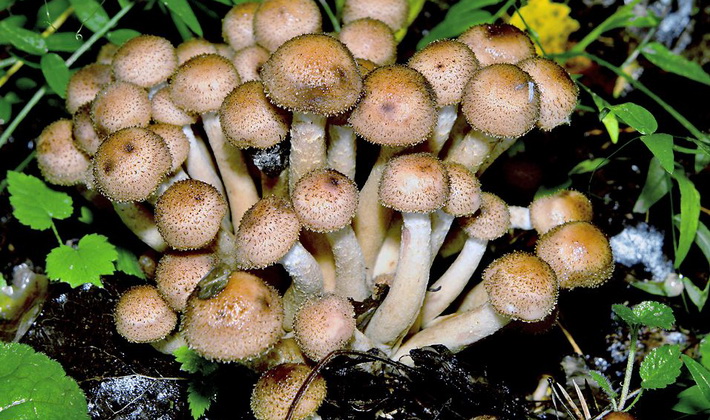
Leg light above, brown below.
Good edible mushroom. Before use, boiling is necessary.
Ecology and distribution:
It grows on both dead and living trees. Prefers hardwood, especially birch. There are one or two “waves” during the season, when honey mushrooms are found in huge numbers.
Flake grass (Phaeolepiota aurea).
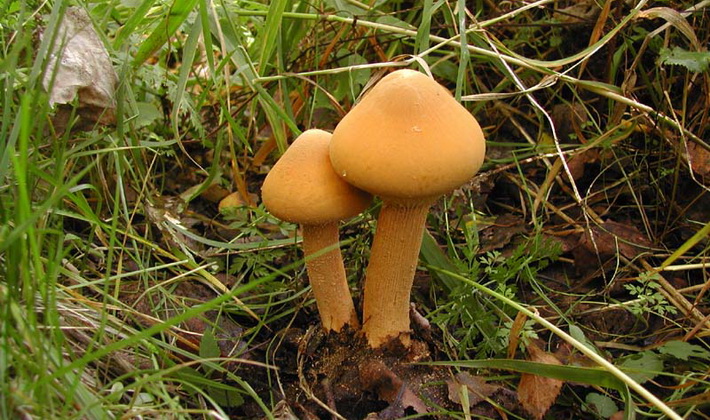
Family: Champignon (Agaricaceae)
Season: August - October
Growth: usually in groups
Description:
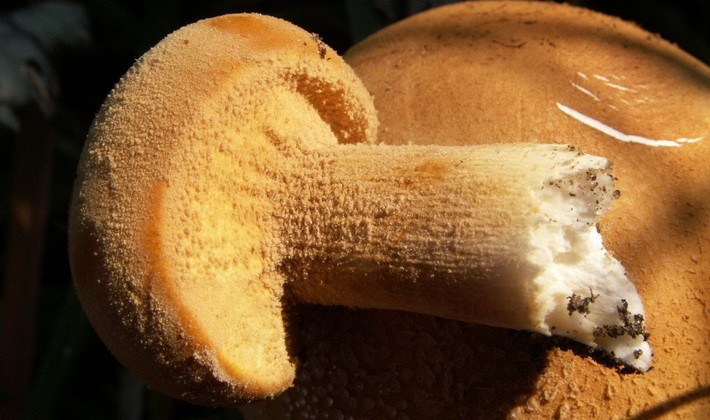
The flesh is fleshy, white or yellowish. The lamellae are frequent, thin, overgrown, yellowish.
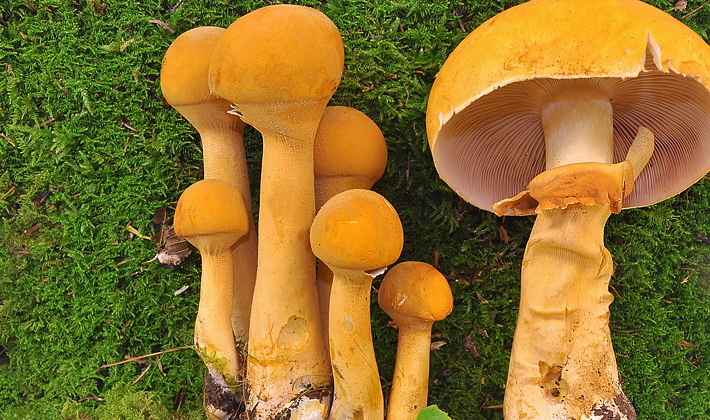
Leg widened to the base or swollen in the middle, one-color with a hat. The cap of ripe mushrooms is convex-prostrate, ocher-yellow.

The cap of young mushrooms is hemispherical or conical, with a dense gray-ocher private veil. The ring is bent, wide, membranous.
This agaric with white flesh has long been considered edible and tasty, but recent studies have revealed traces of hydrocyanic acid in it.
Ecology and distribution:
It grows in rare deciduous and coniferous forests, in clearings and open places, on the side of roads and clearings, in grass, nettles, in shrubs, on rich soil.
These photos illustrate the description of agaric mushrooms:
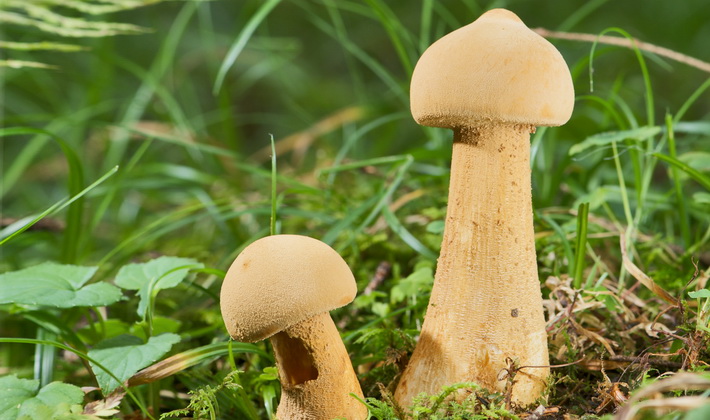
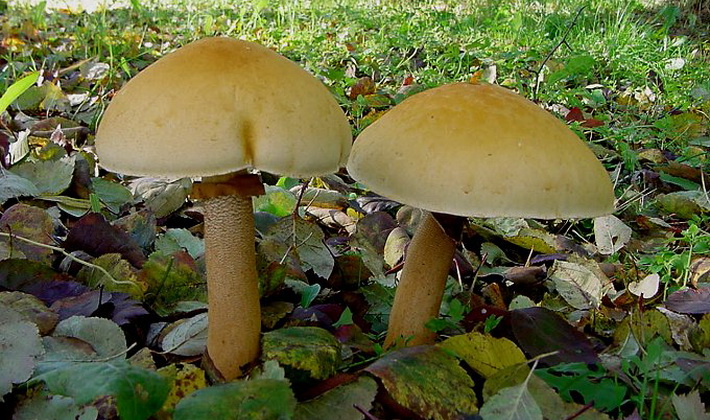
Stellate-spore fiber (Inocybe asterospora).
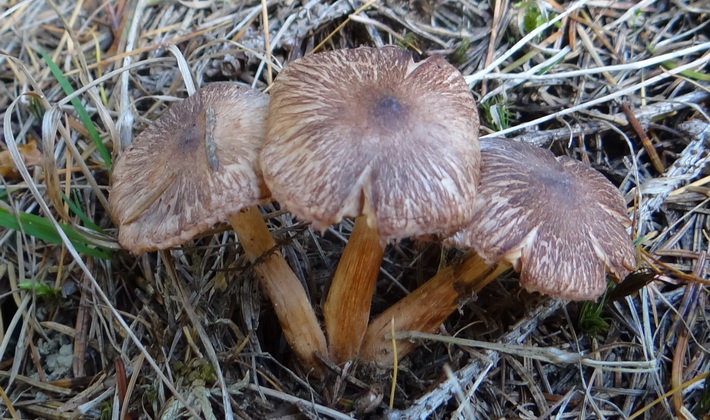
Family: Cobweb (Cortinariaceae)
Season: June - October
Growth: sometimes in large groups
Description of agaric stellate-spore fibrosis:

The cap of young mushrooms is bell-shaped. The cap of mature mushrooms is wide-spread, radially fibrous, often with a lobed, brown edge.
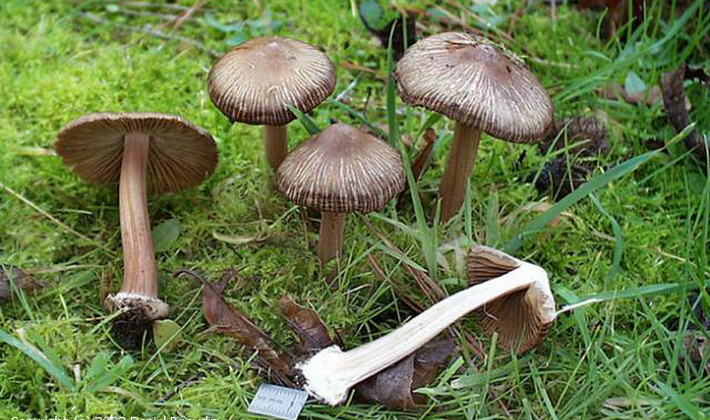
The pulp or fawn, with a strong spermatic odor and an unpleasant taste. The plates are grown, frequent, wide, dirty-brownish, sometimes with an olive tint, with a flaky-pubescent edge.
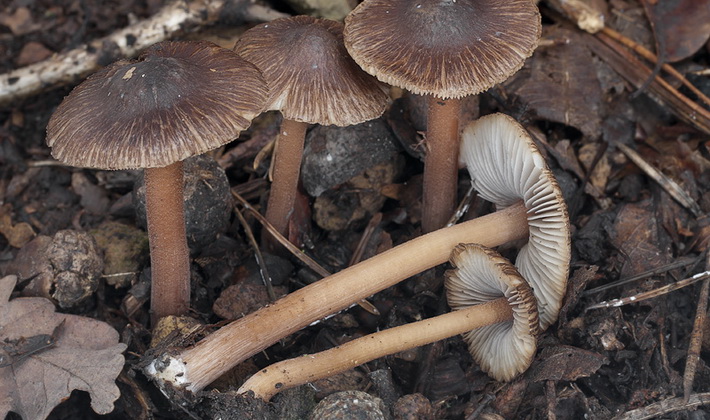
The leg is club-shaped, solid, longitudinally fibrous, brownish.
Mortally poisonous plastinchatych mushroom, contains muscarine toxin.
Ecology and distribution:
Grows in deciduous and mixed forests, in moss, on the litter.
Patuillard fiberglass (Inocybe erubescens).
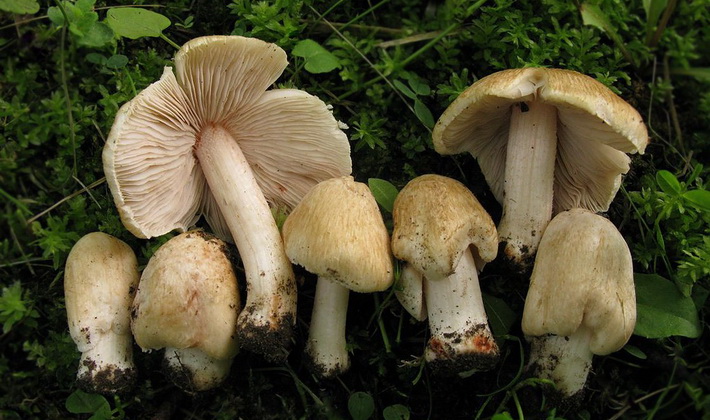
Family: Cobweb (Cortinariaceae)
Season: May - October
Growth: singly and in small groups
Description:

The cap is most often reddish, at first bell-shaped conical, spreads over time. The edges of the cap are with deep radial cracks, especially in old mushrooms. The skin is smooth, with a silky sheen.
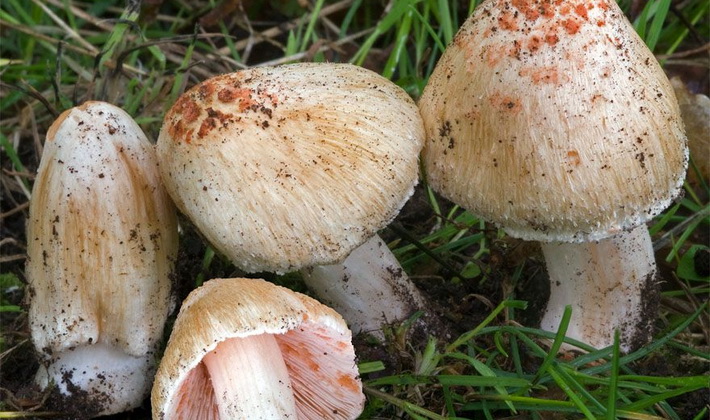
The pulp is white, when damaged, it turns red, with pepper taste.
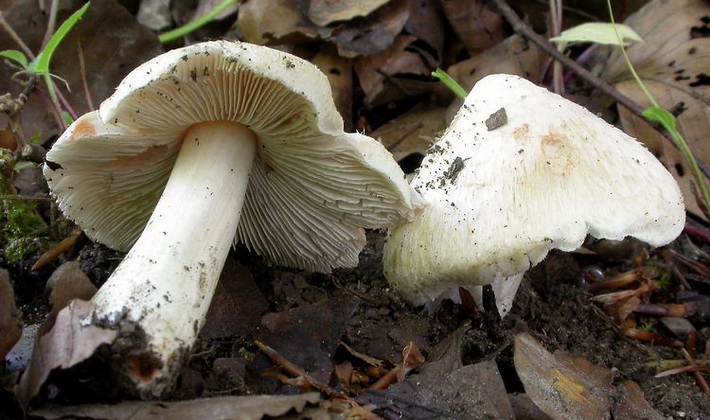
Leg of the same color with a hat, strong, slightly thickened at the base, with longitudinal grooves. Lamellae very frequent, not wide, pink, then brown, white at the edges and covered with fluff.
Deadly poisonous mushroom, contains muscarine toxin.
Ecology and distribution:
It grows in deciduous, coniferous, mixed forests, parks, gardens, usually on calcareous and clay soils. Forms mycorrhiza with beech, linden.
Earthen fiber (Inocybe geophylla).
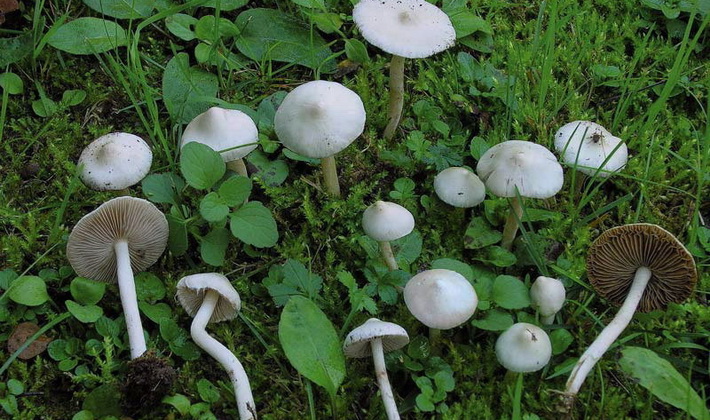
Family: Cobweb (Cortinariaceae)
Season: mid July - mid September
Growth: singly and in small groups
Description:
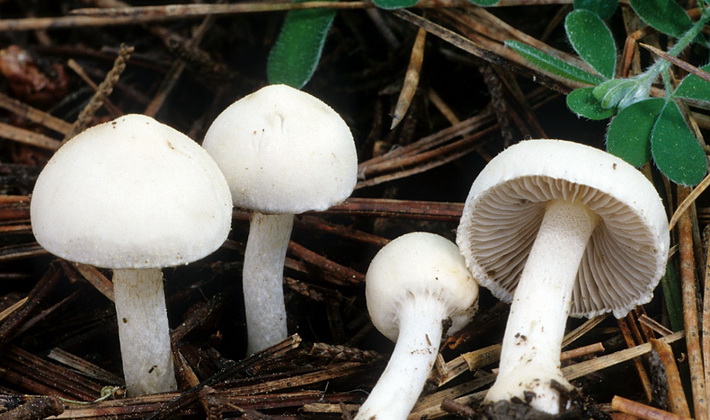
The cap is convex, spread out with a sharp tubercle, shiny, whitish at first, then cream or ocher. The cap of young mushrooms is conical. The plates are frequent, wide, almost free, grayish-yellowish, then yellowish-brown.
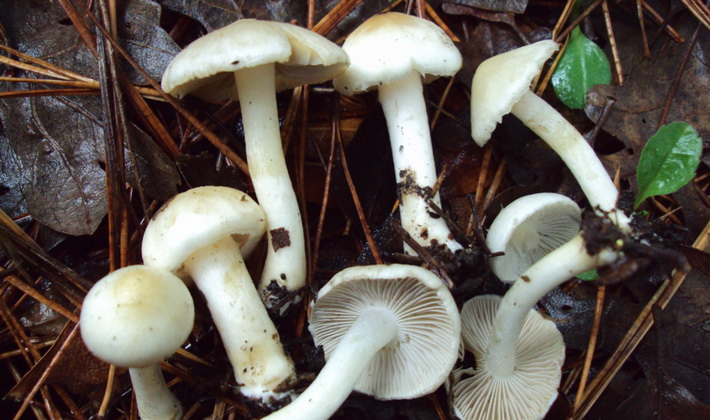
The leg is continuous, then hollow, whitish, then brownish.
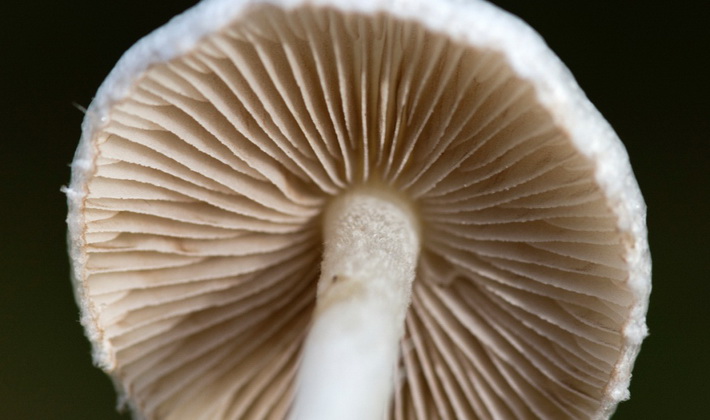
The pulp is whitish, with a faint unpleasant odor.
This type of agaric is deadly poisonous, contains muscarine toxin.
Ecology and distribution:
It grows in coniferous, coniferous-deciduous and deciduous forests, at the edges, in parks, in shrubs, in the grass.
Ruptured fiberglass (Inocybe lacera).
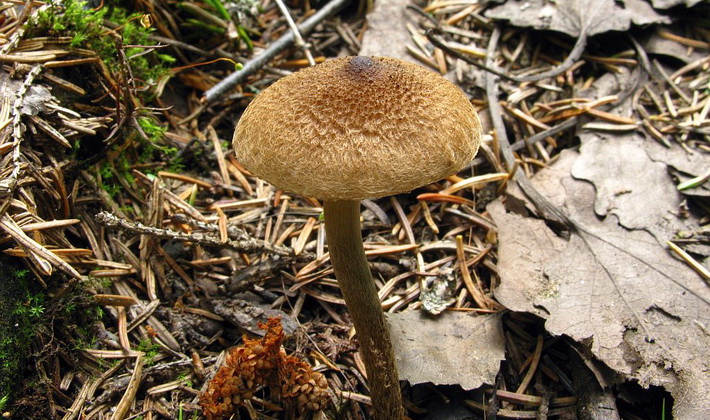
Family: Cobweb (Cortinariaceae)
Season: July - September
Growth: singly and in small groups
Description:
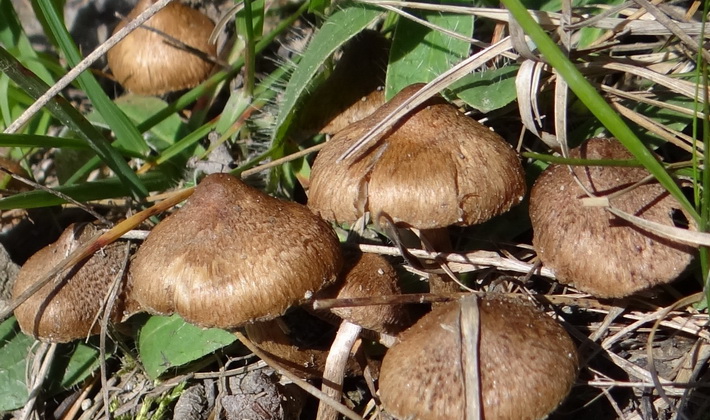
The hat is half-extended, bell-shaped, with a tubercle in the center, finely scaly, yellow-brown. The edge of the hat is white, flaky.

The flesh of the cap is white, the taste is first sweetish, then bitter.

The stalk is dense, brown, with fibrous scales. The plates are wide, adhered to the stalk, brownish brown with a white edge.
Deadly poisonous mushroom, contains muscarine toxin.
Ecology and distribution:
Grows in damp places, along the edges of roads and ditches. Prefers sandy soils, mountains, coniferous and deciduous forests.
Fissured fiber (Inocybe rimosa).
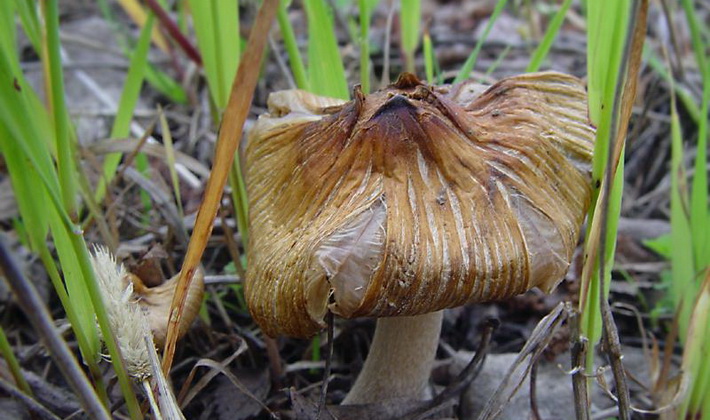
Family: Cobweb (Cortinariaceae)
Season: mid July - mid September
Growth: singly and in small groups
Description:
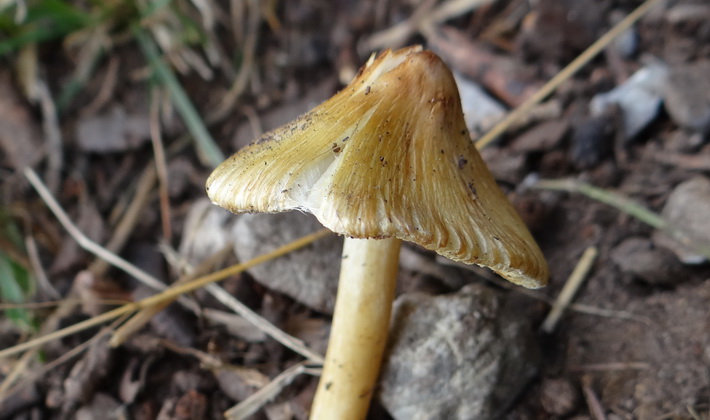
The cap of young mushrooms is conical, bell-shaped, the color varies from whitish to brownish-yellow. The cap of mature mushrooms is wide-bell-shaped, spread with a sharp tubercle, cracked, with translucent flesh. The plates of this mushroom are frequent, wide, almost free.
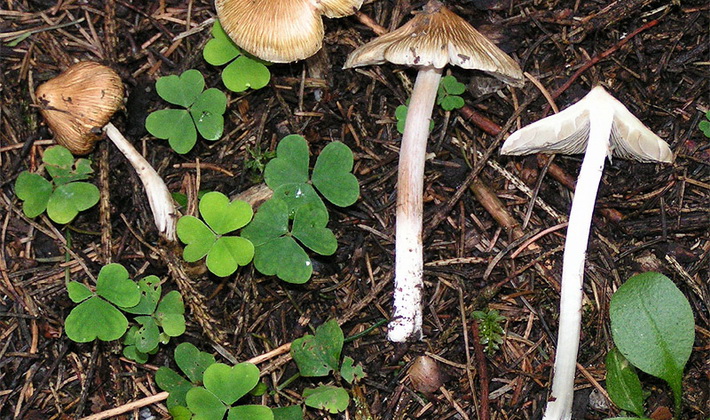
The pulp is whitish, brownish in the leg, sometimes with an unpleasant odor.
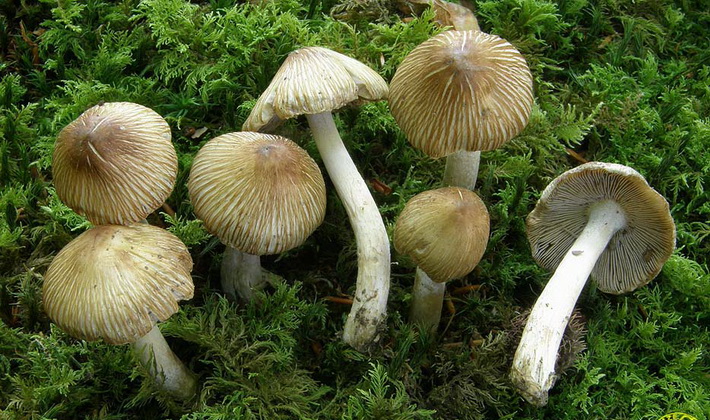
Leg deeply immersed in litter, fibrous, often twisted.
Deadly poisonous mushroom, contains muscarine toxin.
Ecology and distribution:
It grows in deciduous and coniferous forests, along the edges of the grass.
Psatyrella velvety (Psathyrella velutina).
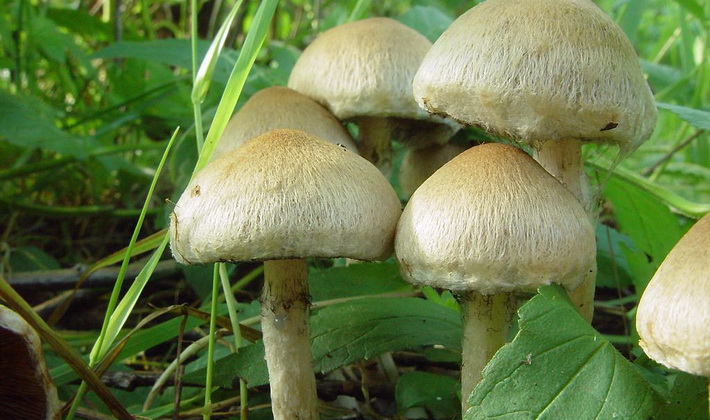
Family: Psatyrellaceae (Psathyrellaceae)
Season: mid July - October
Growth: singly and in groups
Description:
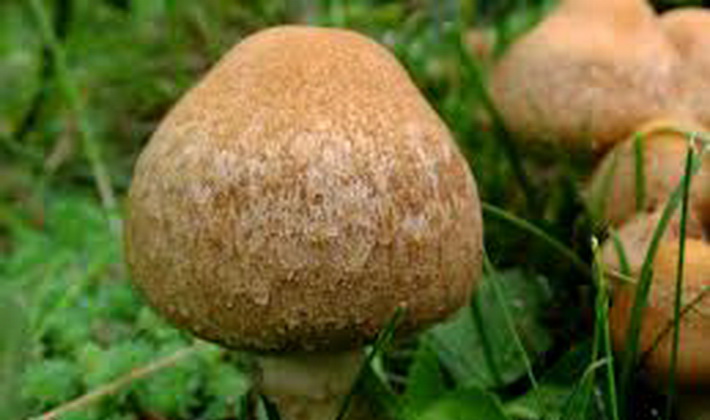
The hat is reddish-brown, felted, with a tubercle. The edge of the cap with a fibrous edge.
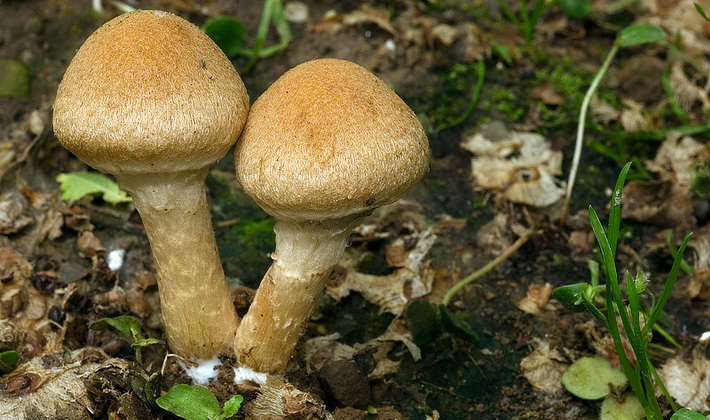
Leg fibrous-scaly, hollow, with annular residues of the bedspread.
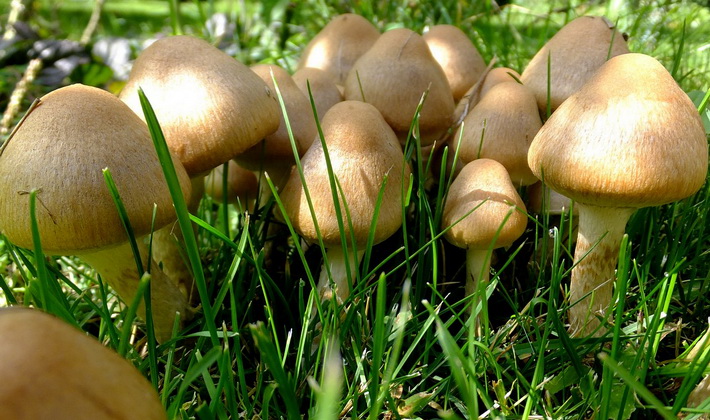
The flesh is faded brown, crumbly, with a spicy smell. Lamellae in their youth are brownish, then purplish-black, curved, emarginate, with whitish droplets of liquid.
Most sources attribute the mushroom to conditionally edible. It is used fresh after boiling.
Ecology and distribution:
It grows in deciduous and mixed forests, in open places, on soil and rotten wood, in grass, along roadsides, near forest roads.
Moss honey (Marasmius oreades).
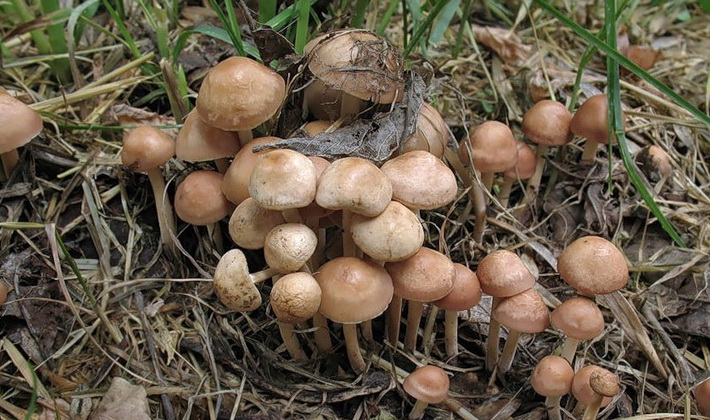
Family: Non-mandrel (Marasmiaceae)
Season: end of May - end of October
Growth: abundant, often forms rows, arcs and “witch circles”
Description:
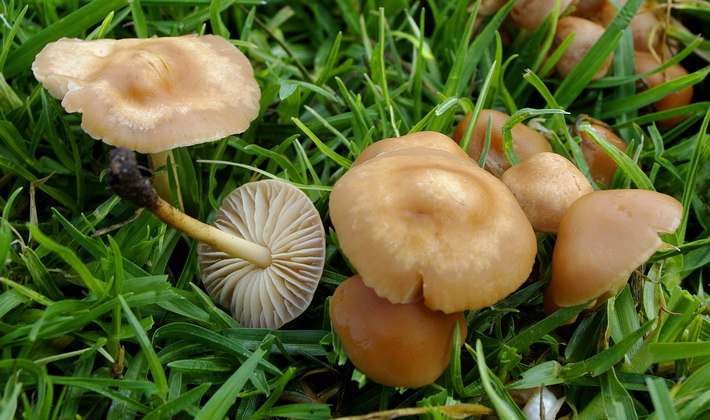
The hat is first conical, then convex, outstretched, bluntly tuberous, light brown in wet weather, fades to pale cream in dry weather.
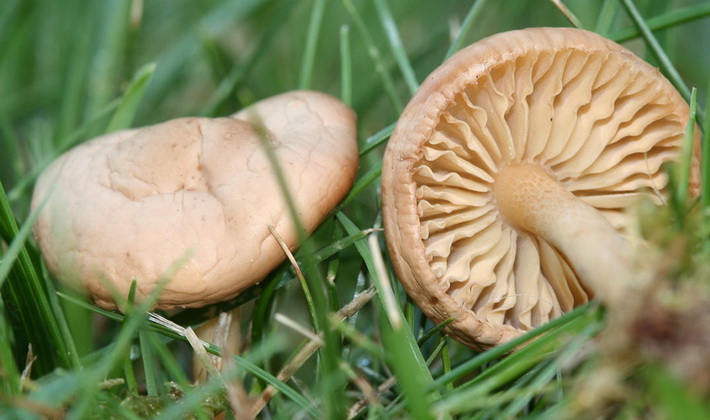
The flesh is pale yellowish, with a pleasant pungent odor. Lamellae are rare, wide, overgrown, then almost free, light.
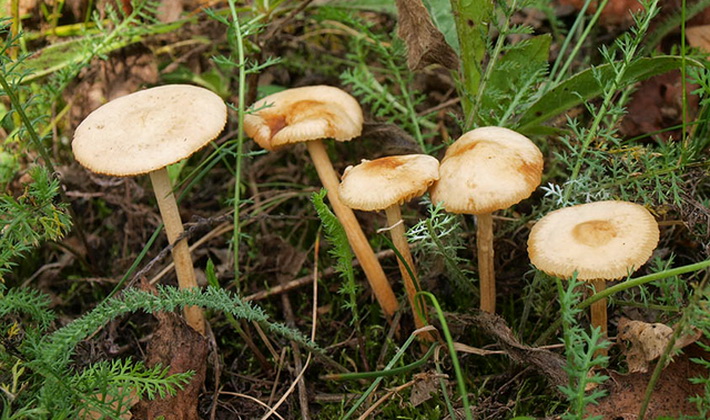
Leg flat, fibrous, dense, continuous, one-color with a hat. The edge of the hat is uneven, serrated.
Tasty edible mushroom. Only hats are used, since the legs are very stiff. Suitable for all types of processing.
Ecology and distribution:
It grows in open grassy spaces - meadows, pastures, in vegetable gardens, orchards, along the edges of fields, on roadsides, at the edges and forest glades.
Conical flake (Psathyrella conopilus).
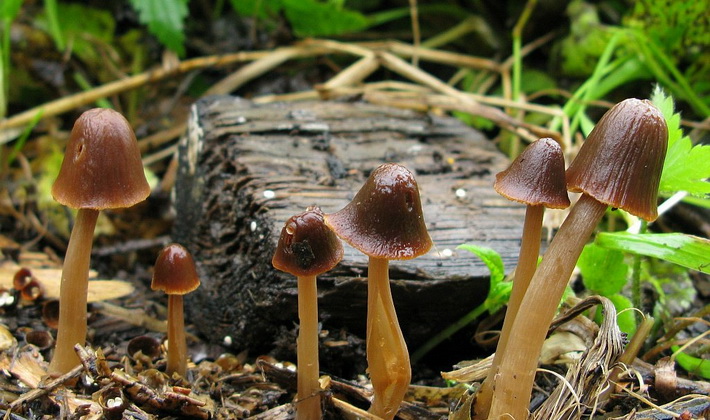
Family: Psatyrellaceae (Psathyrellaceae)
Season: spring-fall
Growth: singly and in groups
Description:

The hat is conical in shape, furrowed. The skin is smooth, dark brownish-brown in color, when dried, becomes ocher-yellow.
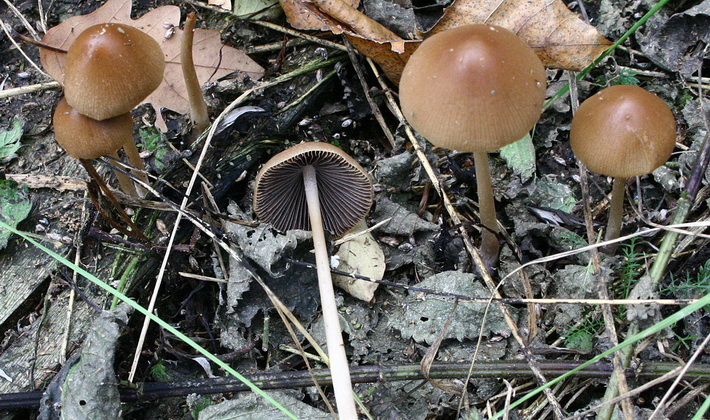
The leg is white, hollow, fragile. The plates are grown, frequent, brittle, from gray to black in color with a white edge.

The flesh is brown, very thin, with a mild taste.
It has no nutritional value. Ecology and distribution:
It grows in broad-leaved forests, on moist soils, in parks, gardens, on soils rich in nitrogen, on lawns, on branches or wood waste, on leaf litter, on manure soils. It is found in Russia in the European part, in the Caucasus, in the Far East.
Ordinary varnish (Laccaria laccata).
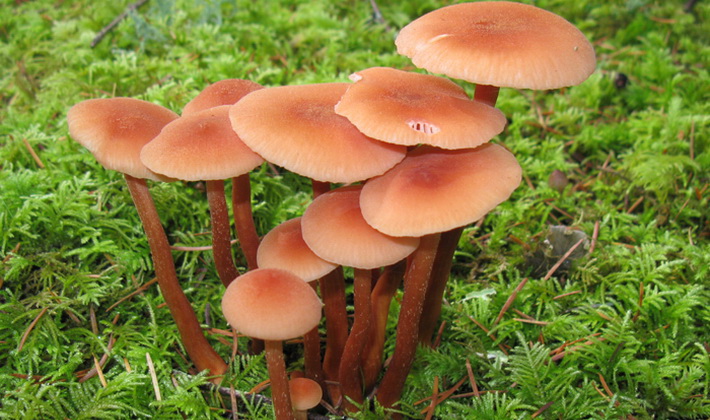
Family: Ordinary (Tricholomataceae)
Season: mid July - October
Growth: in groups
Description:
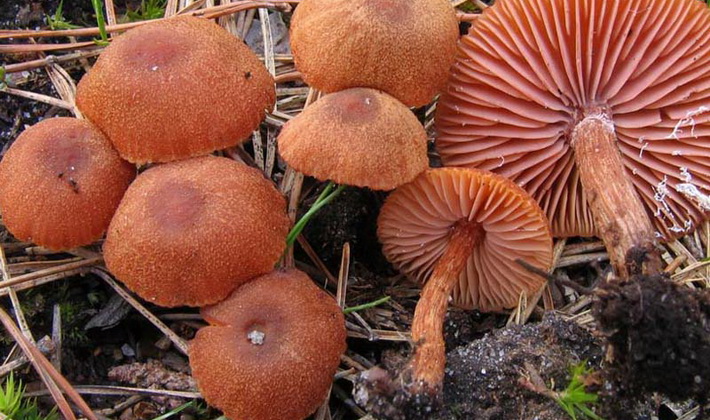
The hat is convex, pink-meat or yellow-reddish. The hat of mature mushrooms is faded, spread out with an uneven cracked edge. The plates are grown or slightly descending, thick, wide, waxy. There is a hollow in the center of the hat.
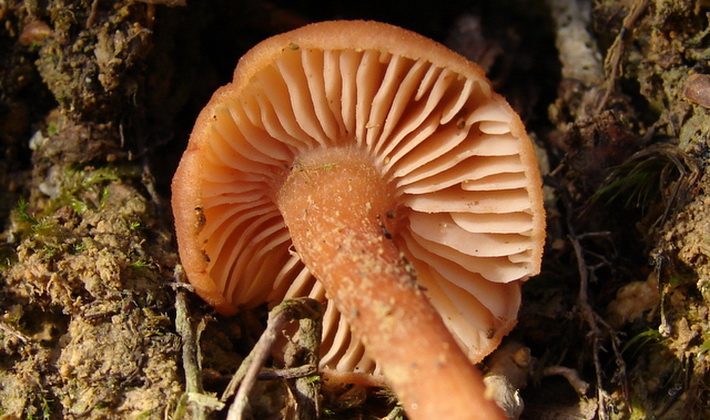
The pulp is watery, odorless.
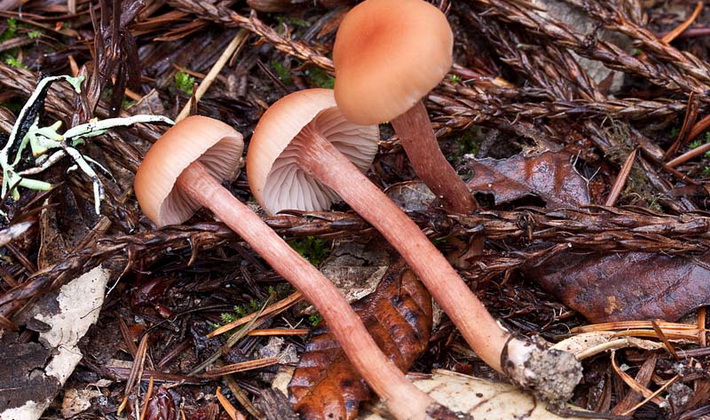
The leg is flat, the same color with a hat, translucent.
The mushroom is edible, used fresh after boiling.
Ecology and distribution:
It grows in light deciduous and mixed forests, on the edges, in meadows, in parks and gardens, in shrubs. Avoid excessively damp, dry and dark places.
Cucumber macrocystidia (Macrocystidia cucumis).
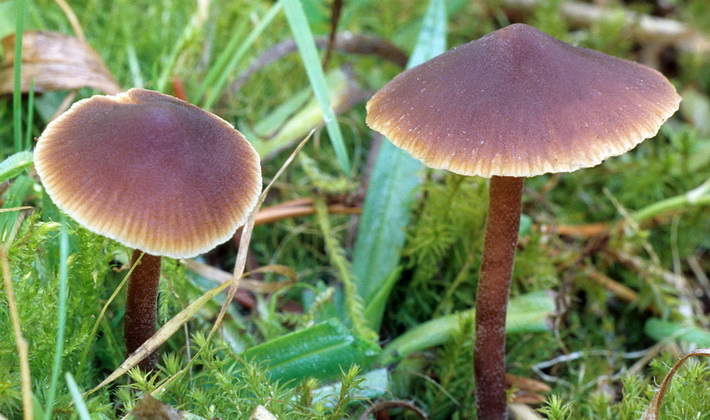
Family: Ordinary (Tricholomataceae)
Season: end of June - mid-October
Growth: in groups
Description:
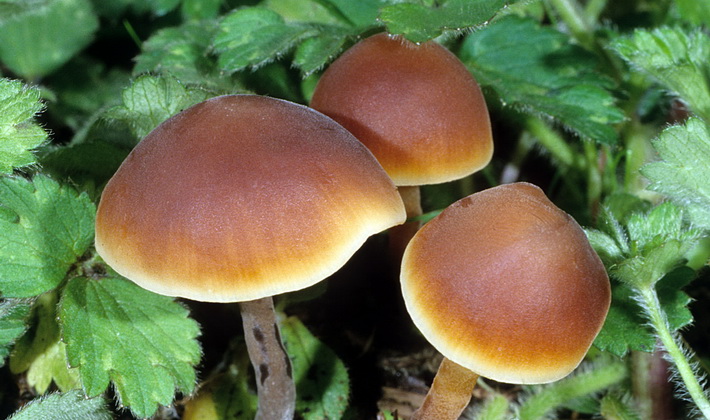
The hat is wide-bell-shaped, with a tubercle.
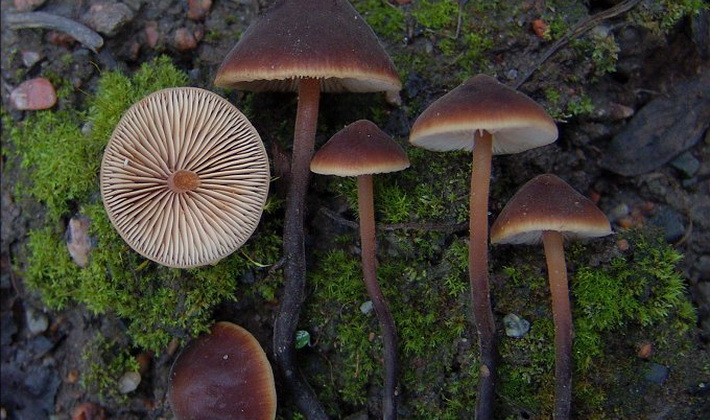
Leg is cylindrical or oblate velvety, brown.
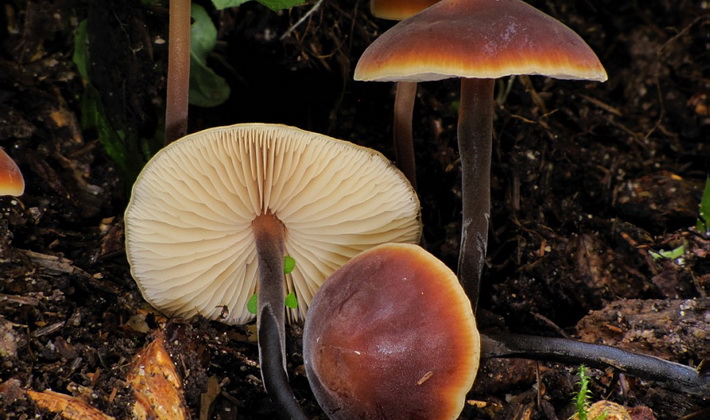
The flesh is dense, dark yellow, with an acidic-herring smell. The plates are downy, with an abdomen, pinkish. The edge of the hat with a pale-edged border. The surface of the hat is chestnut-brown, smooth.
Ecology and distribution:
Grows in coniferous (spruce) and mixed forests (with birch), on the edge of the forest, floodplain meadows, parks, gardens, on soil, mossy dead wood, plant debris, manure.
Entoloma beautiful (Entoloma nitidum).
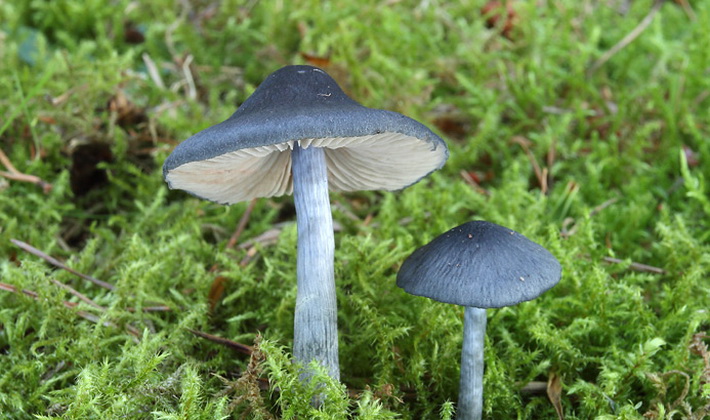
Family: Entolomataceae
Season: mid July - end of September
Growth: in small groups
Description:
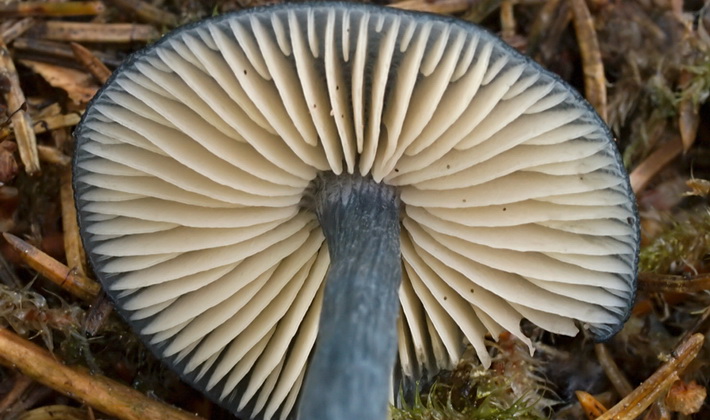
The plates are quite frequent, whitish, then turn pink.
The pulp is whitish, dense, with a weak sparse or floury.
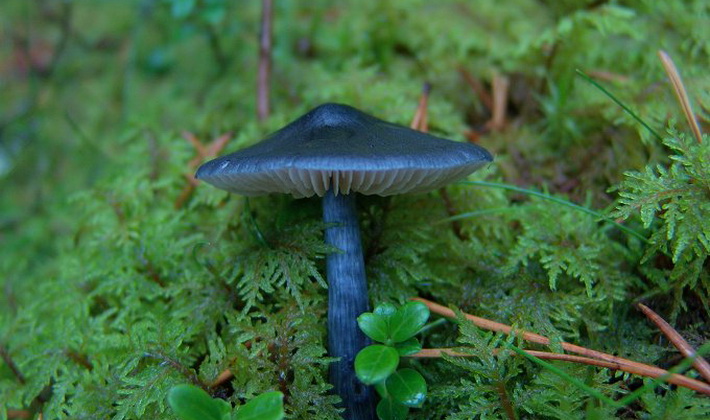
A hat with a noticeable tubercle in the center, gray-blue, shiny.
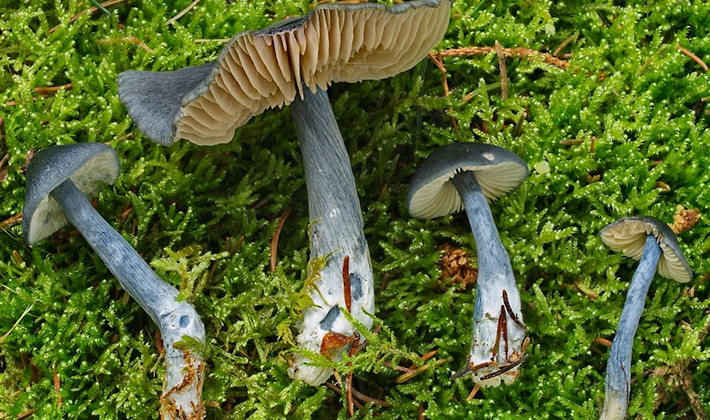
Leg flat, shiny, longitudinally lined, the same color with a hat.
Ecology and distribution:
It grows in mixed (with pine, spruce, birch) and coniferous forests, in moss, in moist places. Prefers acidic soils. It is widely distributed in Europe, but it is quite rare.
Ordinary violet (Lepista nuda).
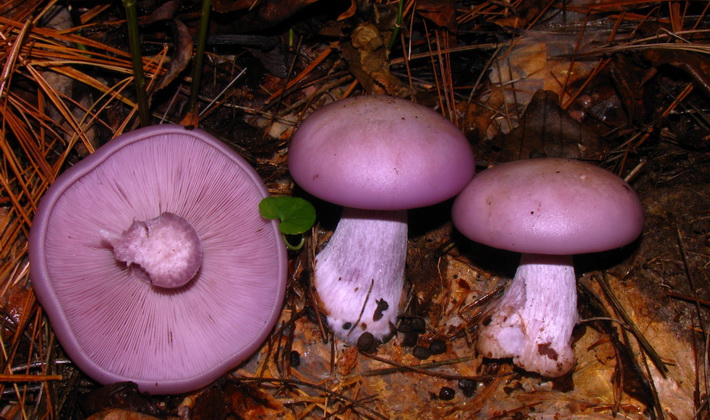
Family: Ordinary
Season: end of August - December
Growth: in groups, rows and rings
Description:
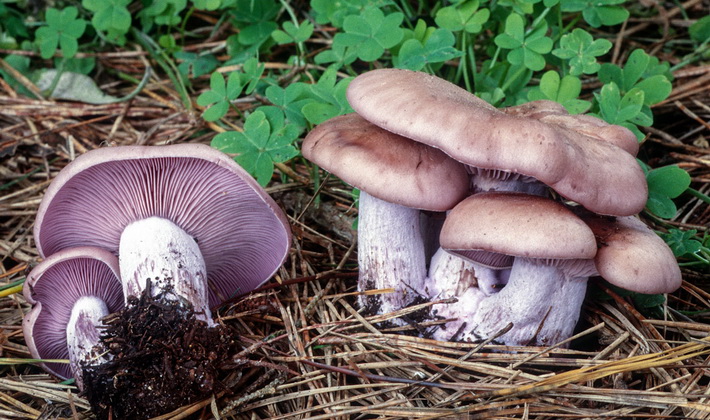
The stalk is slightly thickened to the base, in young mushrooms it is solid, later with cavities.
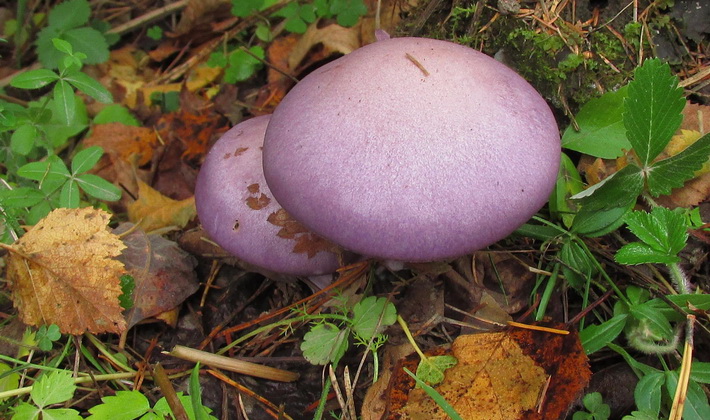
The cap is fleshy, in young mushrooms it is hemispherical, bright purple, later - convex-prostrate or depressed, brownish.
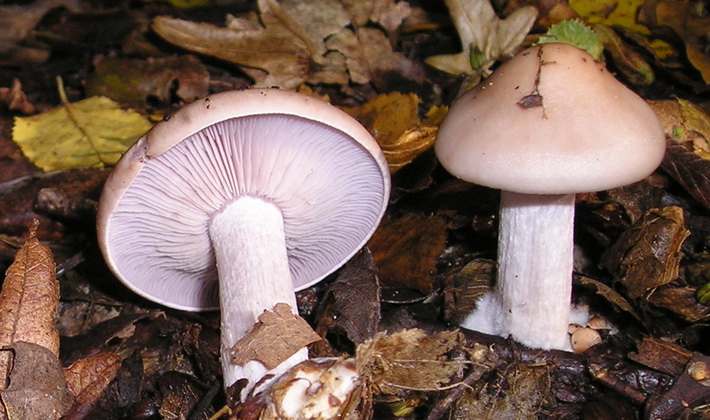
The flesh is dense, light purple, later softer, ocher-cream, with a faint smell of anise. The lamellae are frequent, thin, with a tooth or almost free, purple.
Conditionally edible mushroom, used after boiling for 20 minutes, fresh (fried, stewed), salted and pickled (young elastic mushrooms).
Ecology and distribution:
It grows on decaying leaf litter, on soil, near heaps of brushwood, on fallen needles, in coniferous and mixed forests, in gardens, on compost heaps. It tolerates small frosts.
And in conclusion - another selection of photos of edible and inedible agaric mushrooms:
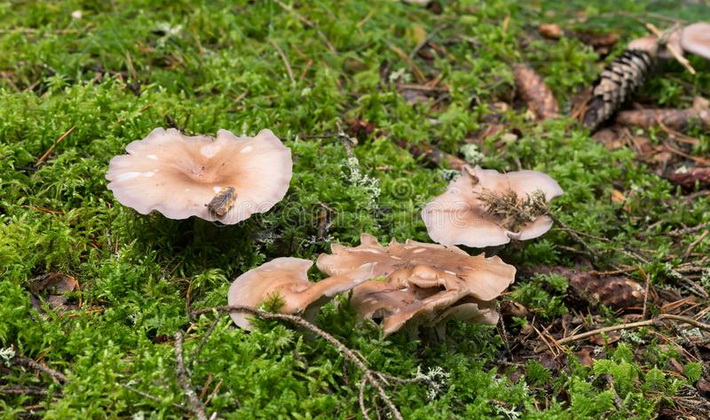
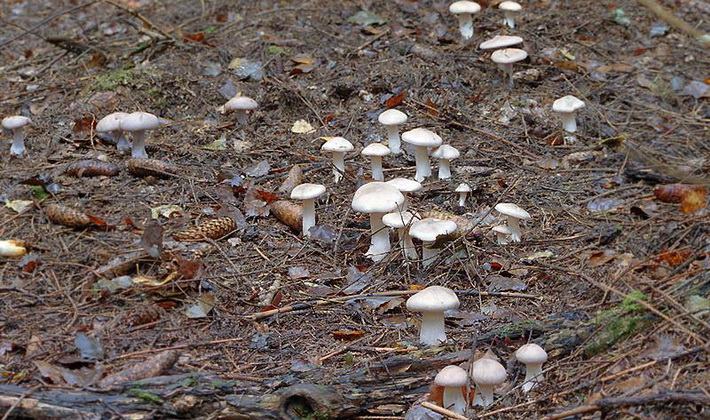
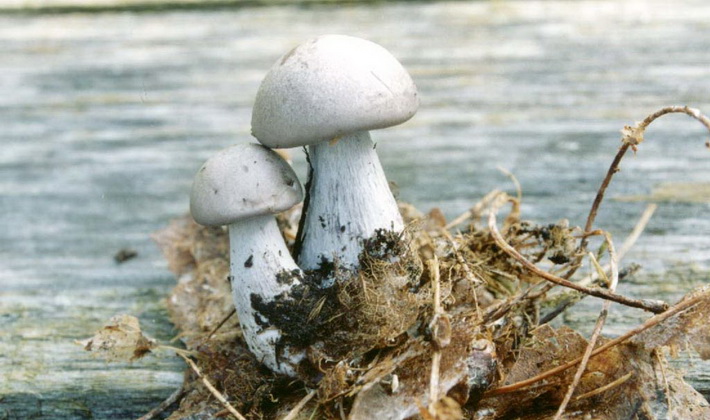

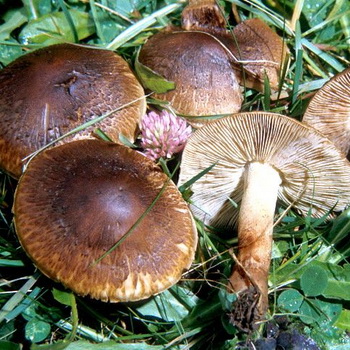
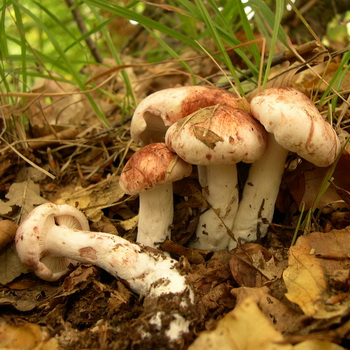
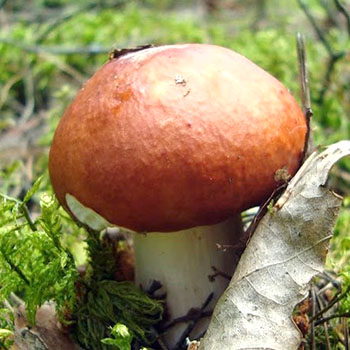
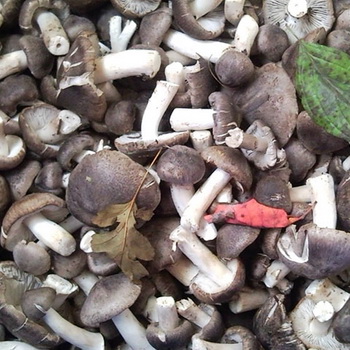
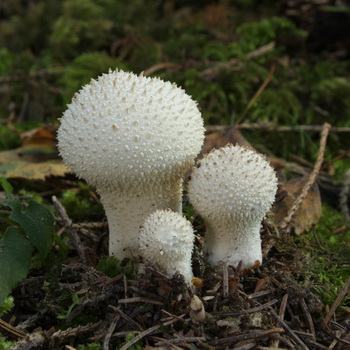
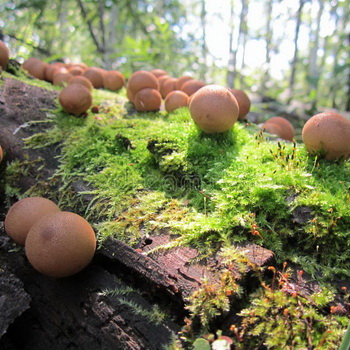
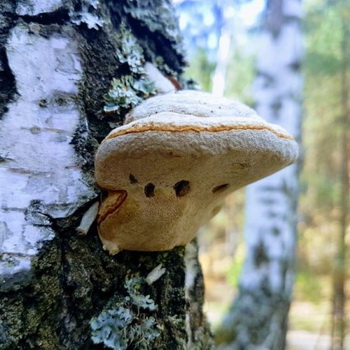
Excellent material about all kinds of agaric mushrooms! The best on the internet! This is 100%.